
Admin
-
Posts
7,893 -
Joined
-
Last visited
-
Days Won
1
Content Type
Profiles
Forums
Events
Store
Gallery
Community Map
Posts posted by Admin
-
-
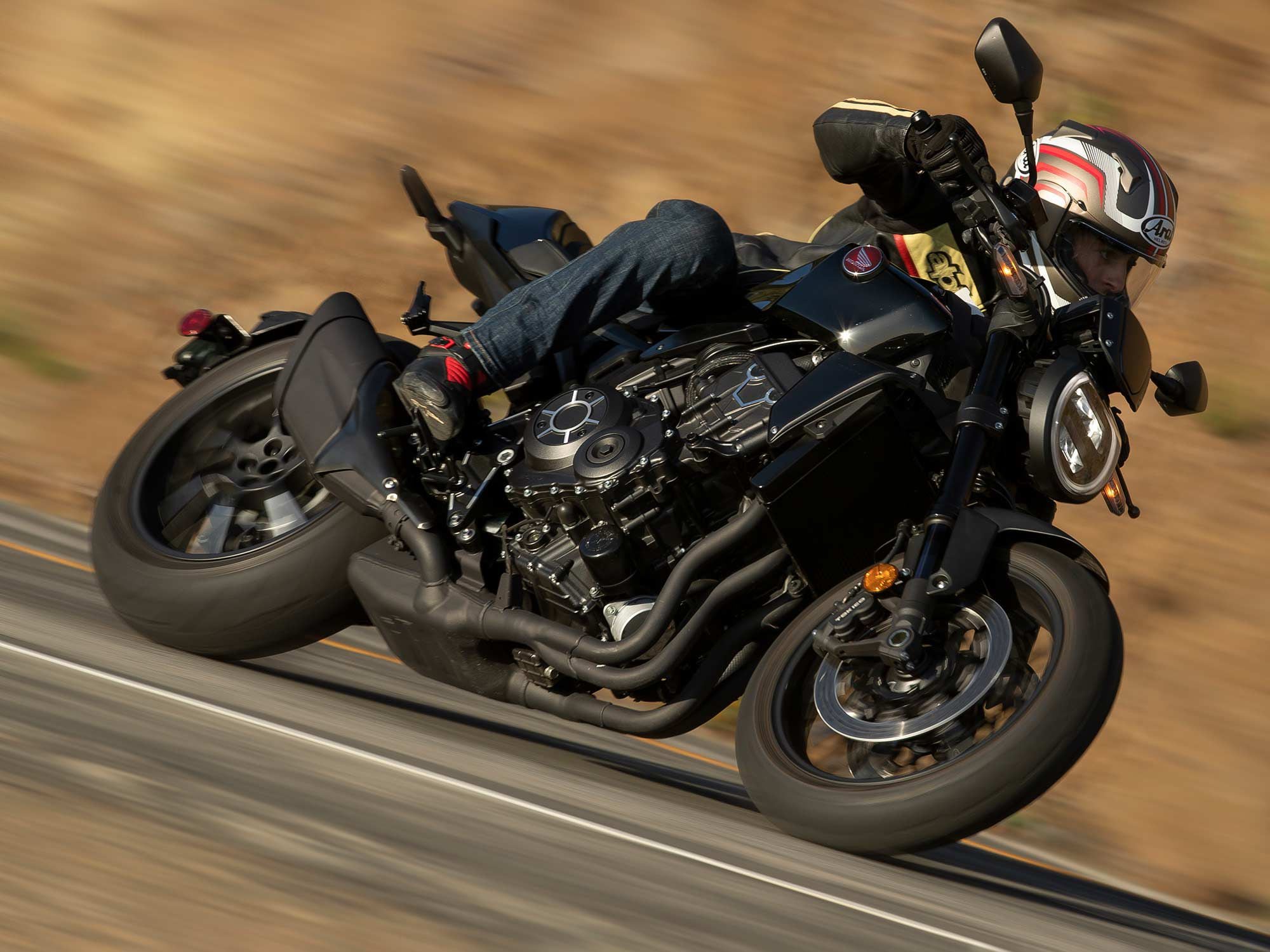
There’s only one flavor of Honda’s CB1000R available in the US: the Black Edition. (Adam Campbell/)Honda’s CB1000R Black Edition is the sensible liter-class streetfighter. Not for Honda are the wild excesses of a KTM 1290 Super Duke R or the Ducati Streetfighter V4. No, Honda seems to declaim with this bike, you don’t need all the horsepower of a liter-class race replica. You need strong, balanced performance, good looks, and an attractive price. Then it proceeds to deliver exactly that.
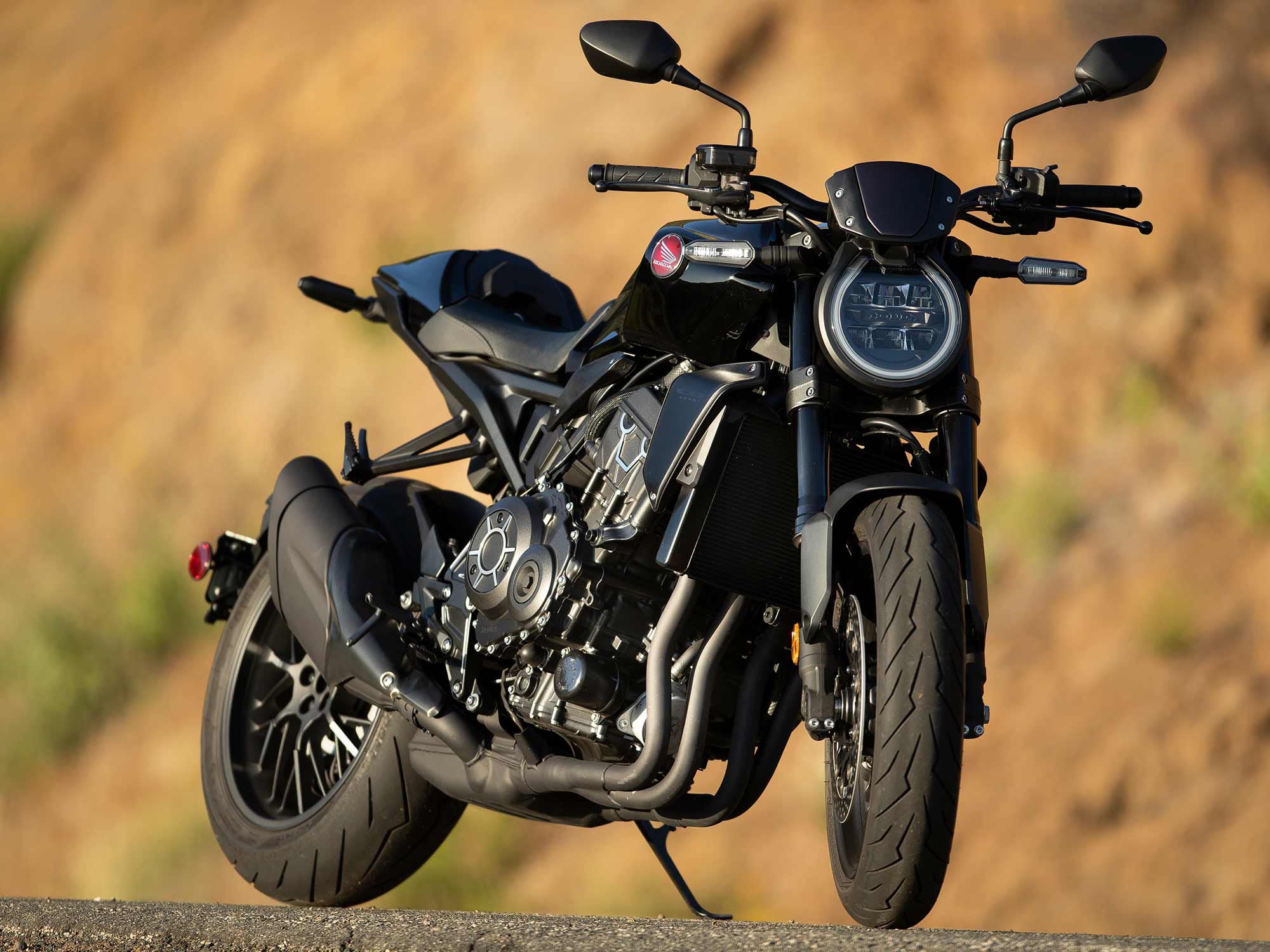
Honda’s CB1000R has a retro-modern style that the manufacturer calls Neo-Sports Café. (Adam Campbell/)The only version of the CB1000R sold in the United States is the Black Edition, a midnight special dipped entirely in shiny carbon, set off with polished aluminum highlights on the wheels, engine, and footpeg brackets, and a stainless exhaust. The not-quite-classic coffin-shaped gas tank bears a retro-modern Honda “Wing” logo that, if not for the red background, could have been salvaged from a mid-’60s Super Hawk. The front headlight is retro-modern as well, a riff on a 7-inch-round incandescent, except it’s slammed back against the huge upside-down fork tubes, carries two distinctive rectangular LED reflectors surrounded by a light-pipe halo, and flows at the top into the rectangular form of the full-color LCD instrument panel. It’s a good-looking bike, traditional and modern at the same time, and one that often elicits unsolicited compliments.
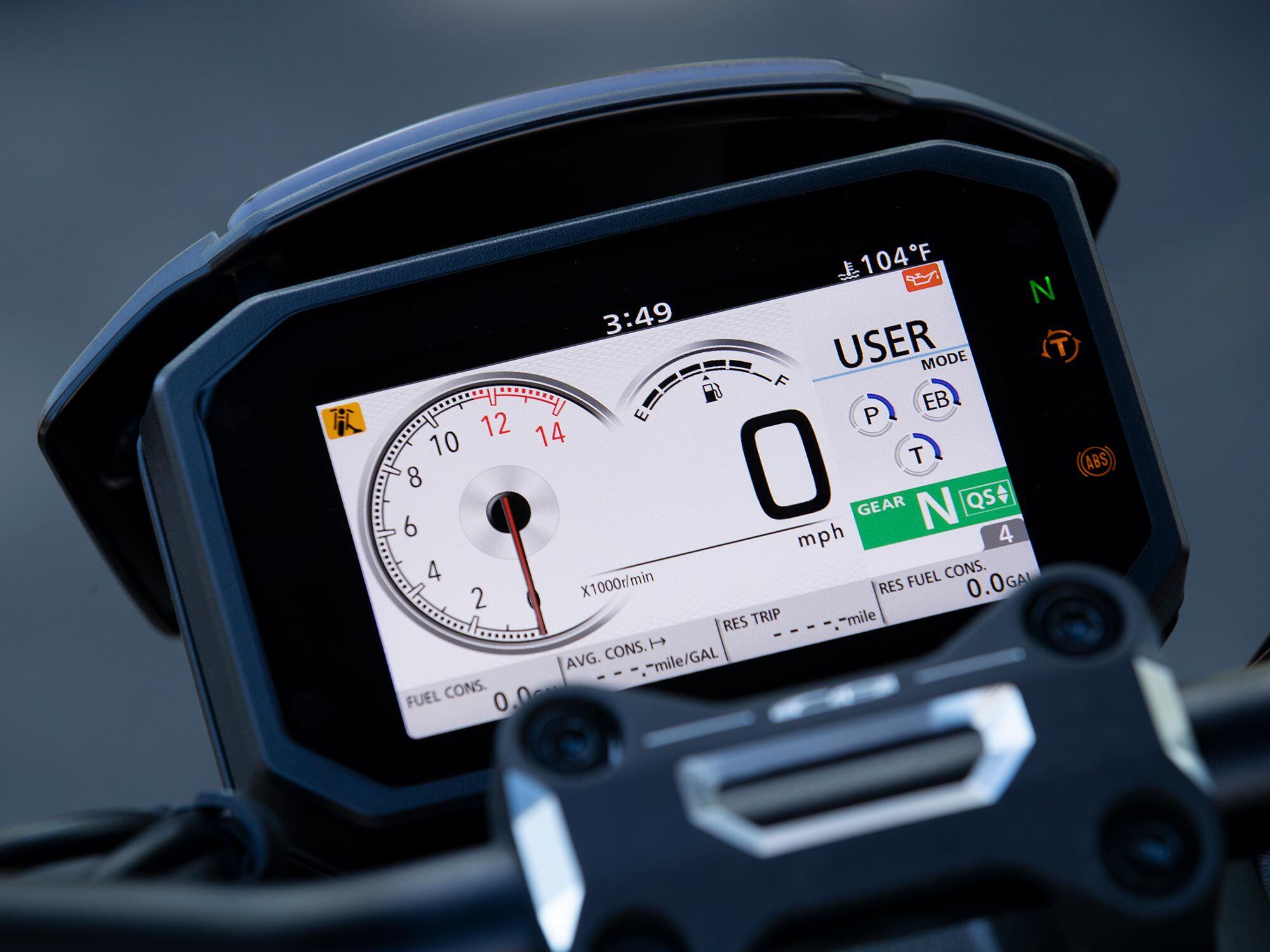
Info is conveyed via a full-color 5-inch TFT dash. (Adam Campbell/)The heart of the CB1000R is an updated and retuned version of the powerplant that first appeared in the 2004 CBR1000RR. It’s a short-stroke (75mm bore by 56.5mm stroke) four-cylinder screamer that’s been reworked for torque and equipped with the latest two-way slipper clutch for a light pull. Even so, it still redlines at 11,500 rpm. On the dyno, it peaks at 121.8 hp, with a noticeable jump in the torque curve at 6,500 rpm. And the gearing is substantially shorter than on the original CBR race replica, so that first gear tops out at about 72 mph.
Short gearing and 1,000cc of displacement launches the bike hard, with the front wheel effortlessly skimming the ground. Similarly, measured performance is strong, though far from exceptional for a literbike: The CB sprints the quarter-mile in 11.1 seconds, traveling 128 mph at the end. A dash from a stop to 60 mph takes just 3.3 seconds, a time that’s as much wheelie- as power-limited. That quarter-mile time and trap speed are a little quicker and faster than that of a Yamaha MT-09 SP, but behind that of the fire-breathing end of the liter-class streetfighter spectrum.
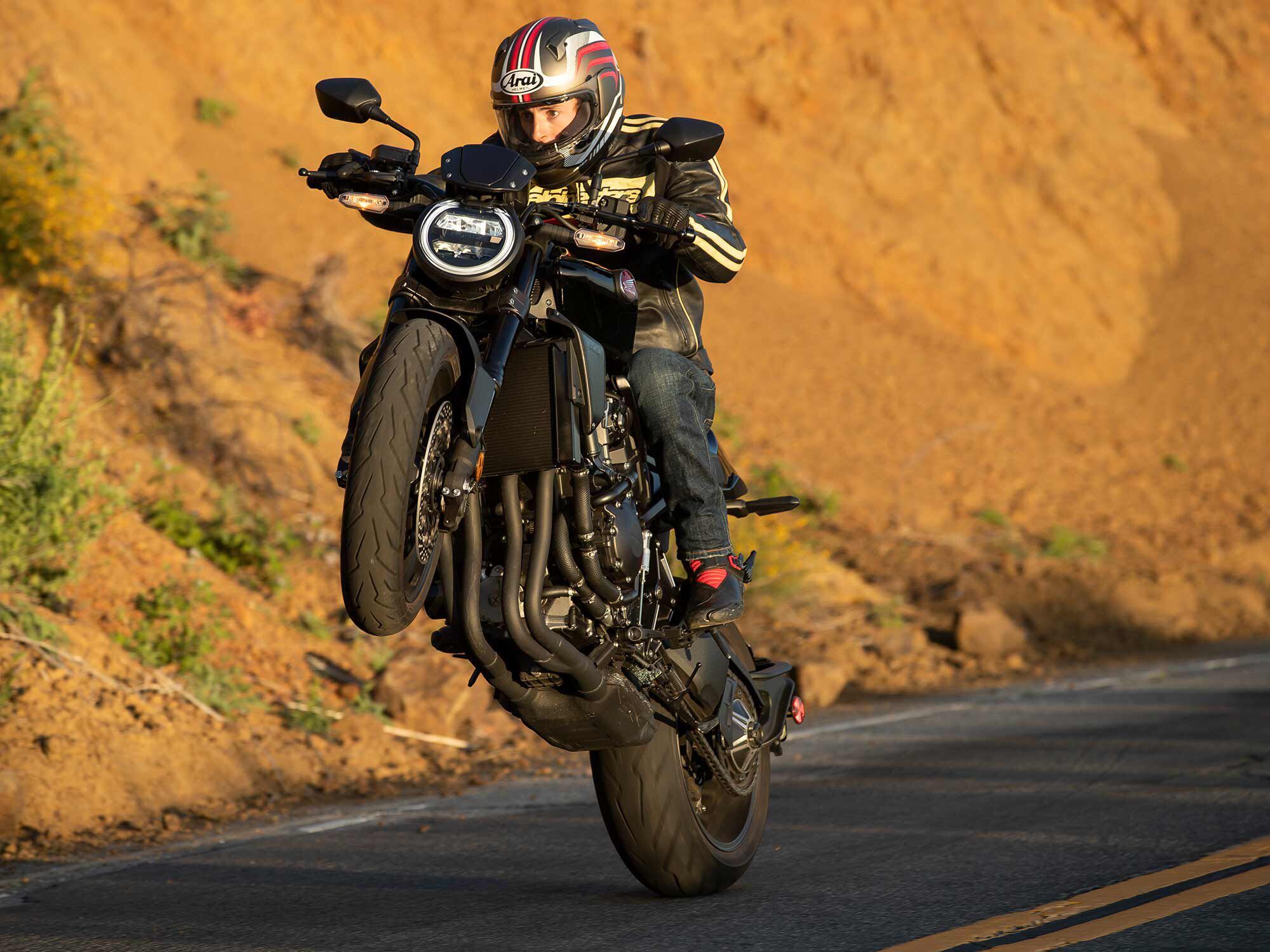
It may be powered by a retuned past-generation superbike engine, but there’s still plenty of punch in the CB1000R Black Edition. (Adam Campbell/)But the riding position and ergonomics tell you more of the bike’s character than the Superbike-sourced-but-detuned engine. The pegs are planted directly underneath you, and the reach from the 32.8-inch seat height isn’t as short as that of many supersport bikes, so your legs aren’t tightly folded. The seat itself is well-padded and wide enough for comfort on multihour rides. The handlebars rise enough to have you leaned forward slightly, enough to balance the wind at 80 mph but not enough to make you wish for a back massage after a day of riding. This is a gentleman’s express of a sportbike.
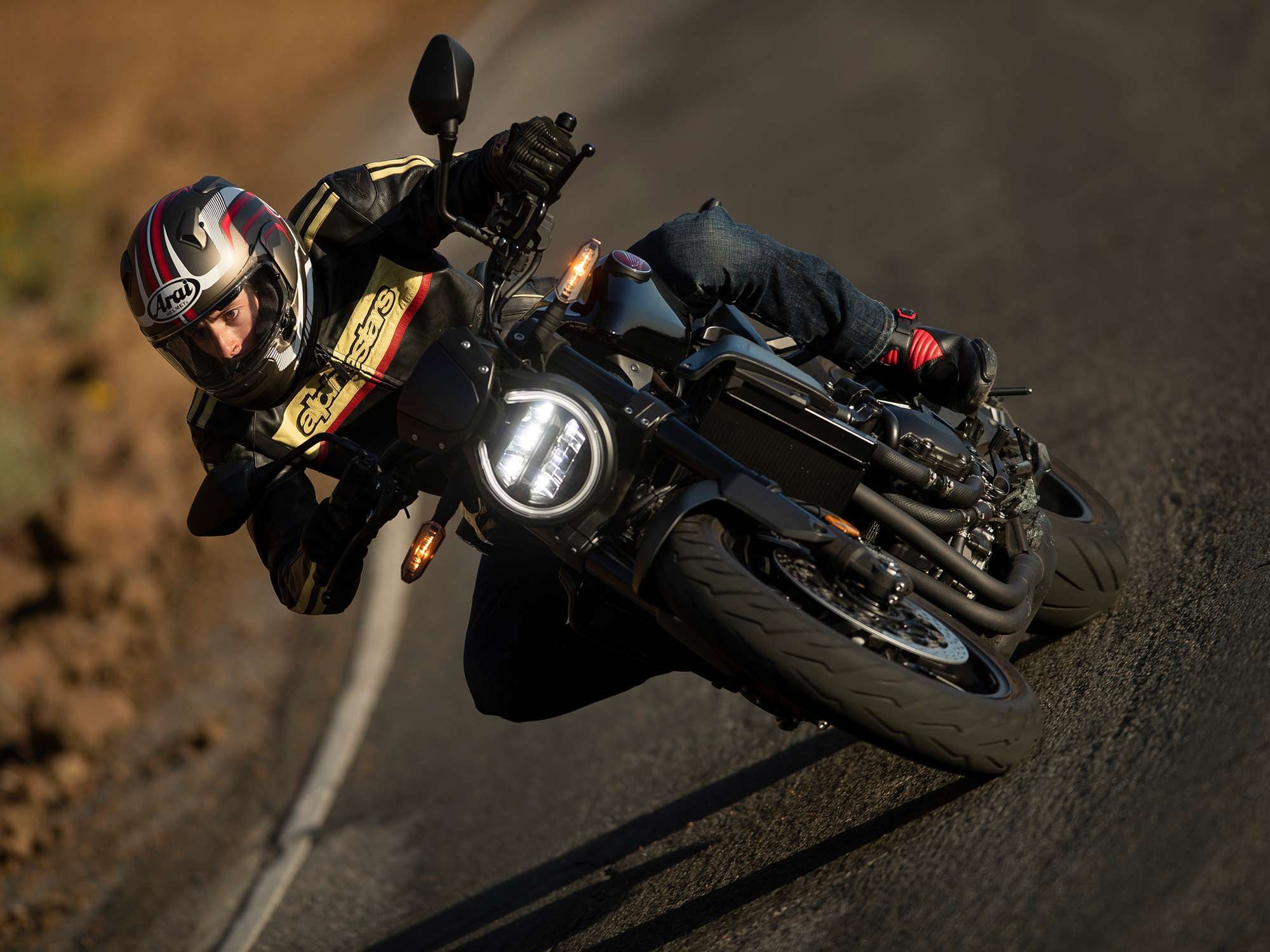
Ergonomics are just sporty enough for attacking the canyons, but not so sporty that fatigue quickly sets in. (Adam Campbell/)You notice the attention to detail every time you operate the machine: The brake and clutch levers are perfectly profiled to present only gently rounded edges, something you might not notice until you jump directly onto another manufacturer’s sportbike where the edges are just a bit squarer and a bit less comfortable. The quickshifter works effortlessly for clutchless upshifts and downshifts. When you do need the clutch, the effort on the CB is light, while the front brake is powerful without being touchy. The ABS system will eventually intrude as you brake harder, but the pulsing through the brake lever or the pedal is reasonably minimal, enough to let you know you’re on the limit without distracting. Stopping distances are also good without being exceptional: 34 and 135 feet from 30 and 60 mph, respectively.
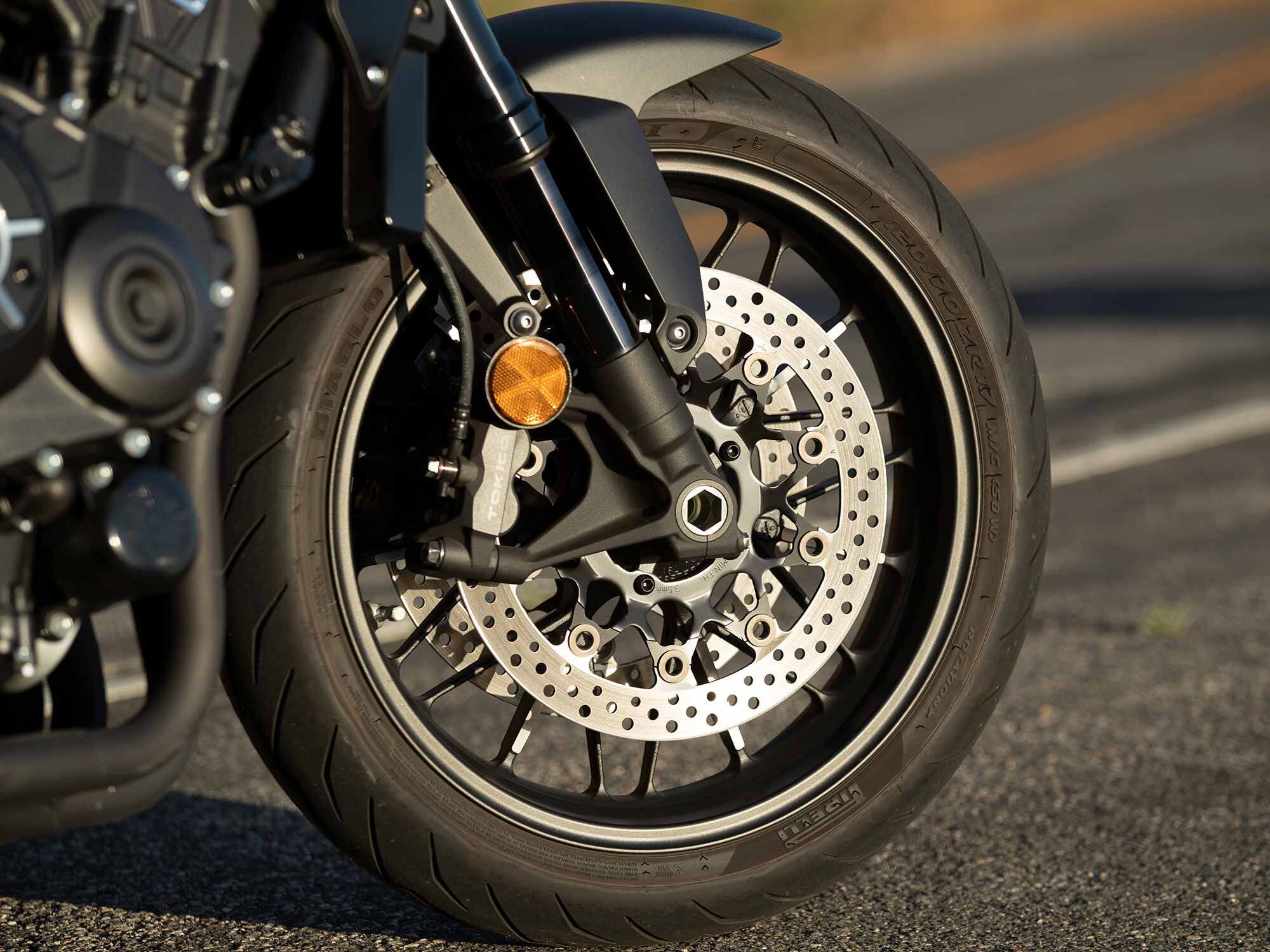
Stopping power from the CB1000R’s front brake is impressive, and the ABS works well without being distracting. (Adam Campbell/)On winding roads, the CB’s 25 degrees of rake and 3.8 inches of trail work with big Pirelli Diablo Rosso tires (120/70ZR-17 front, 190/55ZR-17 rear) to produce handling that’s stable, competent, and reassuring. The not-very-long 57.3-inch wheelbase and relatively conservative steering geometry produce a machine that simply goes where you want, without either twitchiness or less-than-responsive steering. Instead, the big CB quickly gives you the impression of being on your side, and of being a machine that is unlikely to surprise you with unexpected behavior. Part of that predictability comes from the compliant and well-damped Showa suspension. The Big Piston fork simply absorbs even the big bumps without a hint of harshness.
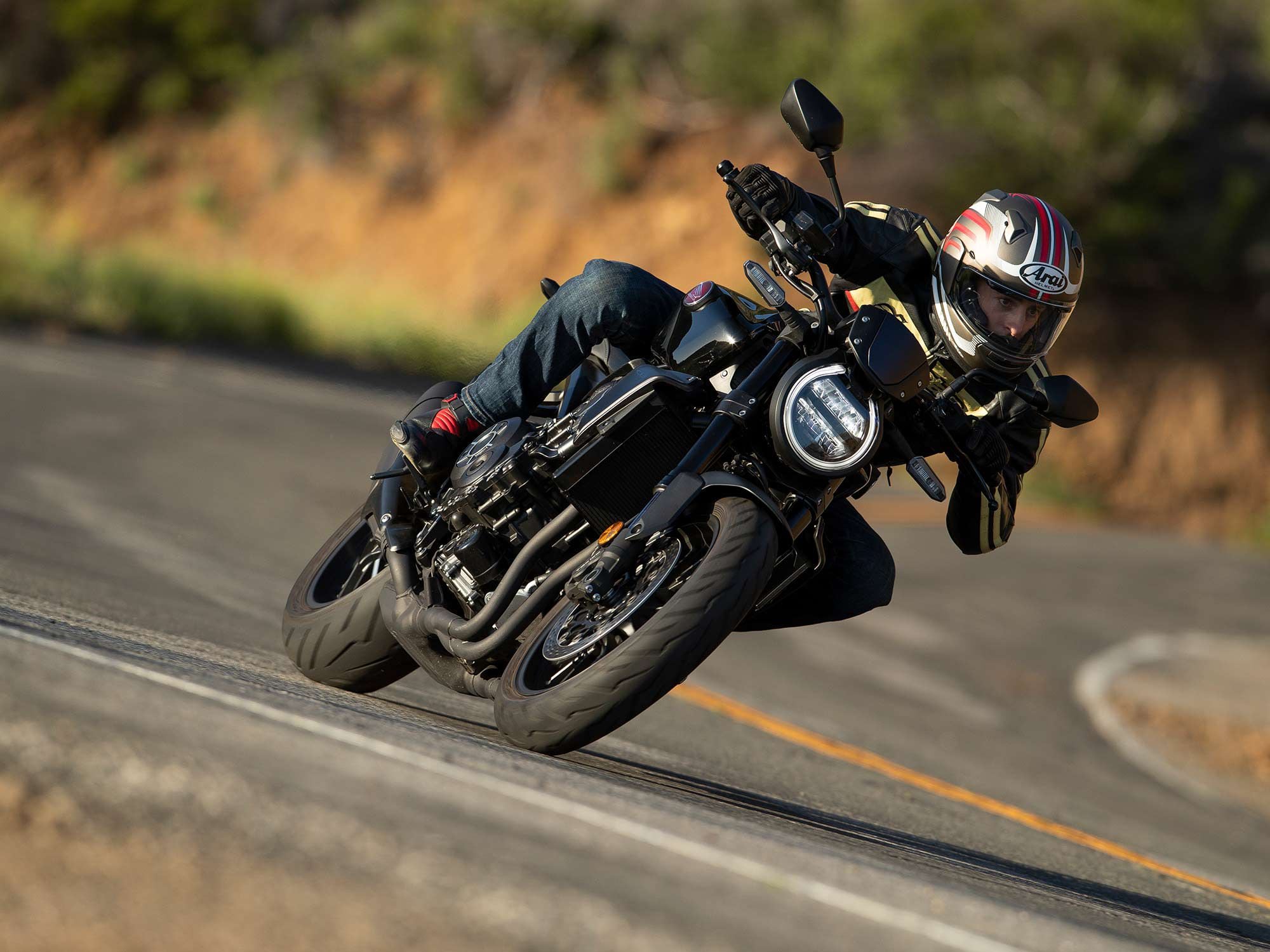
Bumpy backroads don’t upset the CB1000R Black Edition’s chassis, thanks to a balanced suspension with well-sorted damping. (Adam Campbell/)As for the electronic aids, the CB has traction control, ABS, and multiple throttle maps, but lacks a six-axis inertial sensor that would allow the various systems to be aware of the bike’s cornering attitude and to adjust their operation accordingly. Such cornering-aware systems are rapidly becoming the standard and can be found in sub-$10,000 machines, such as the Yamaha MT-09. While the CB does not have the latest tech, it has an attractive TFT-color display and dedicated switch gear that allows its rider to quickly change operating modes. The four modes available are Standard, Rain, Sport, and User. Sport mode offers the most power and the sharpest throttle response—almost too sharp at times—and the least engine-braking and the least intervention of the traction control. Standard mode tunes everything back just a bit and offers a satisfyingly smooth throttle. Rain mode offers noticeably less power and slower response, and somewhat surprisingly has a higher level of engine-braking. User mode is just that. Perhaps an ideal normal setting would be the Standard (number 2) throttle-and-power map, with minimal engine-braking and traction control selected.
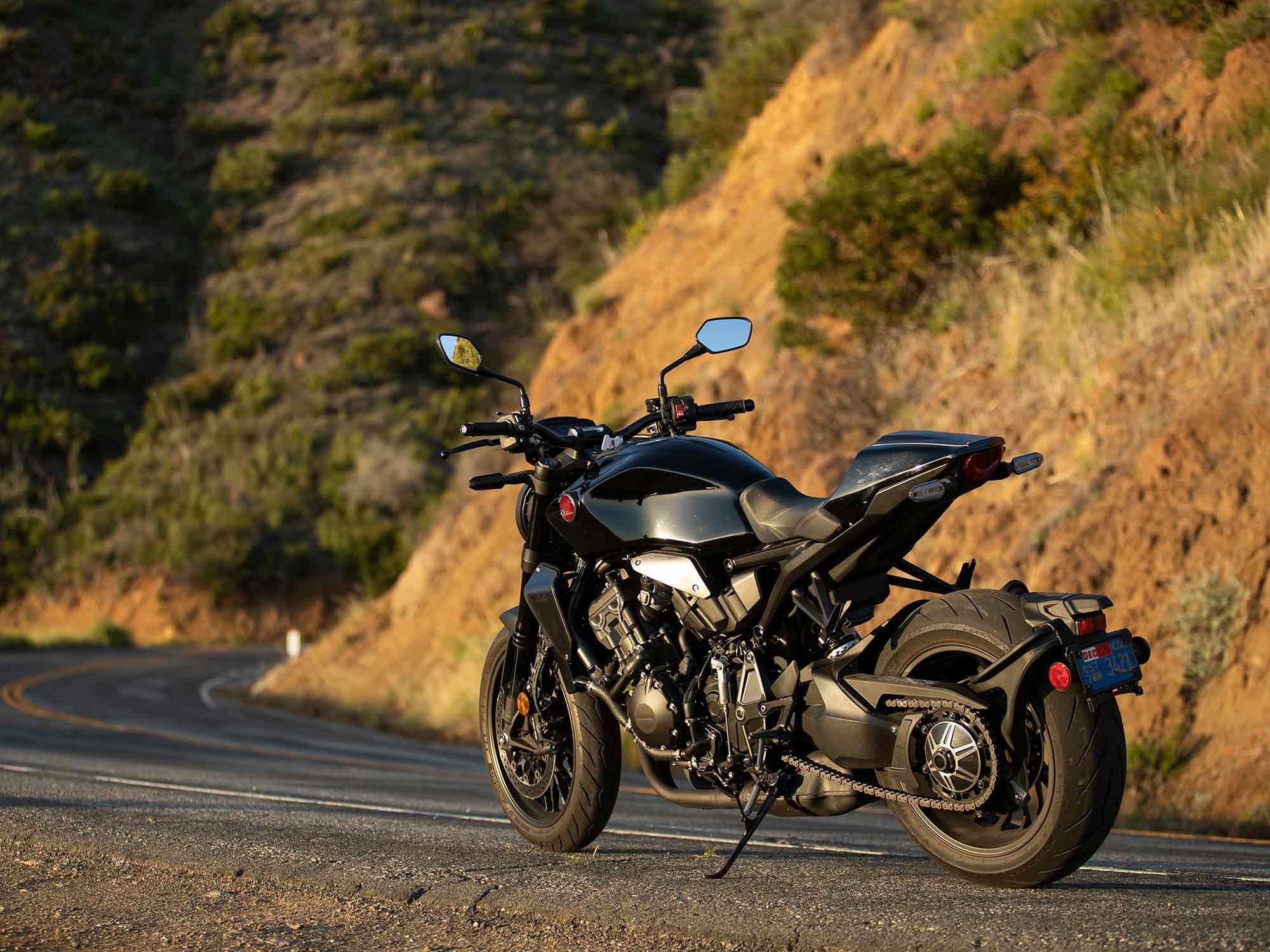
It’s hard to find many faults with the 2022 Honda CB1000R Black Edition. (Adam Campbell/)The menus for selecting many displays and other functions aren’t always exactly intuitive; even resetting the tripmeters requires a read of the owner’s manual the first time or two. And one of the only ergonomic failures on the machine can be found in the left-hand switch assembly housing the mode and cursor switches. It has a shrunken turn-signal switch, with the emergency flasher switch placed immediately to its right. In more than two months of riding, we found ourselves still occasionally hitting the flasher switch when trying to turn off the turn signal. It was a small thing, but still annoying, and one that could have been prevented with a small raised barrier to shield the flasher switch.
But when your main complaint of a motorcycle is the placement of the emergency flasher switch, you know the machine is competent indeed. With the CB1000R, Honda has prioritized solid sporty performance, good distinctive styling, and an ergonomic package that makes the CB more versatile than many other sportbikes or streetfighters. And in doing this while holding the price to $12,999, it has also made the machine something of a value proposition. All hail the CB1000R, the most sensible streetfighter.
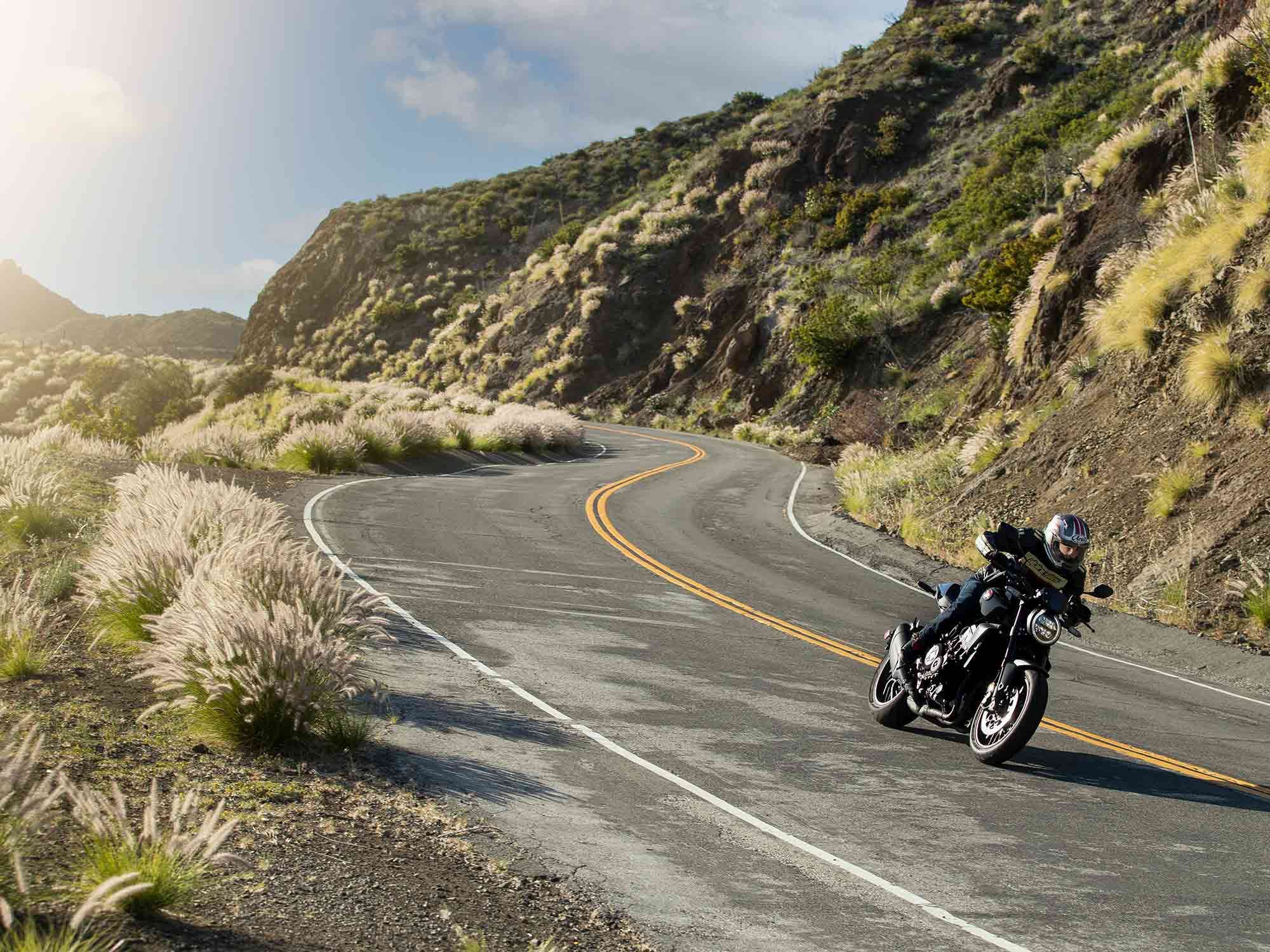
At $12,999, the CB1000R Black Edition is a bargain in the naked or streetfighter category. (Adam Campbell/)2022 Honda CB1000R Black Edition Specifications
MSRP: $12,999 Engine: DOHC, liquid-cooled inline-four; 4 valves/cyl. Displacement: 998cc Bore x Stroke: 75.0 x 56.5mm Compression Ratio: 11.6:1 Transmission/Final Drive: 6-speed/chain Cycle World Measured Horsepower: 121.8 hp @ 9,800 rpm Cycle World Measured Torque: 68.8 lb.-ft. @ 8,200 rpm Fuel System: PGM-FI fuel injection w/ 44mm throttle bodies, ride-by-wire Clutch: Wet, multiplate slipper/assist; cable-actuated Frame: Steel backbone Front Suspension: 43mm Showa SFF-BP fork, spring preload, rebound, and compression damping adjustable; 4.7 in. travel Rear Suspension: Single Showa shock, spring preload and rebound damping adjustable; 5.2 in. travel Front Brake: Dual radial-mounted 4-piston calipers, full-floating 310mm discs w/ ABS Rear Brake: 1-caliper, 256mm disc w/ ABS Wheels, Front/Rear: Cast aluminum Tires, Front/Rear: 120/70-17 / 190/55-17 Rake/Trail: 24.7°/3.8 in. Wheelbase: 57.3 in. Ground Clearance: Cycle World Measured Seat Height: 32.8 in. Fuel Capacity: 4.3 gal. Cycle World Measured Wet Weight: 468 lb. Contact: powersports.honda.com Cycle World Measured Performance
Quarter-Mile: 11.11 sec. @ 127.81 mph 0–30 mph: 1.58 sec. 0–60 mph: 3.31 sec. 0–100 mph: 6.42 sec. Top-Gear Roll-On, 40–60 mph: 2.80 sec. Top-Gear Roll-On, 60–80 mph: 3.31 sec. Braking, 30–0 mph: 33.99 ft. Braking, 60–0 mph: 135.41 ft. -
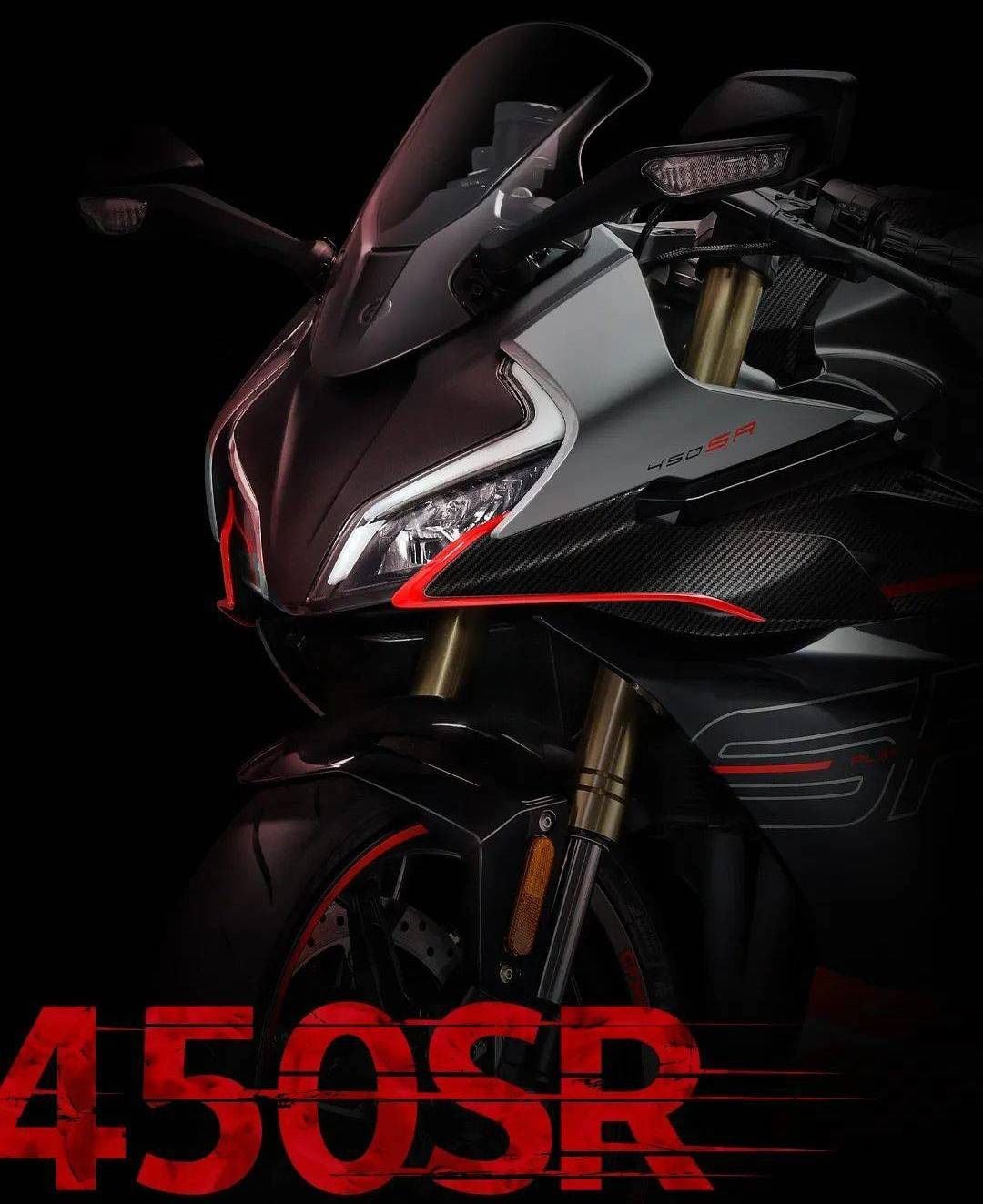
CFMoto’s lightweight 450SR model is making its official debut in China. (CFMoto/) CFMoto’s SR-C21 concept bike was a head-turning enigma when it was shown late last year, with its combination of high-end components and European styling. At the time, it had a mystery engine that the company remained steadfastly silent about, but last month we revealed it’s actually a 449cc parallel twin destined for a 450SR sportbike. CFMoto has now confirmed it’s opening the order books for just that machine in China.
Over there, the market for twin-cylinder sportbikes in the 400cc class is getting increasingly competitive, and CFMoto wants the 450SR to flatten the opposition by using much the same tactic that Honda employed when launching the CBR900RR Fireblade back in 1992. Honda rewrote the rule book then by creating a bike with the weight of a 750 and the performance of a literbike, and with the 450SR, CFMoto is promising a machine with the weight of a 250 and the power of a 500.
Related: CFMoto 450SR Photos and Details Leaked
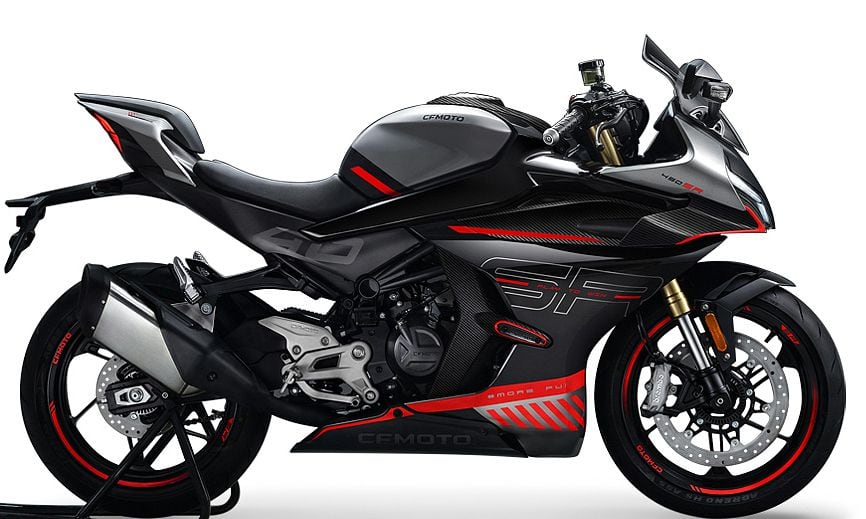
We don’t see the same high level of specification carry over from the SR-C21 concept to the production model, but the overall appearance is similar. (CFMoto/) The company has confirmed the leaked performance figures we received last month. As expected, the new parallel twin engine makes a claimed 50 hp from 449cc, along with 29 pound-feet of torque, and the bike comes in at an impressively light 370 pounds wet.
What the numbers didn’t reveal were the huge differences between the new 449cc twin and CFMoto’s earlier 400cc designs. The 450SR’s engine is completely new, with a more compact, lightweight design and a 270-degree crankshaft instead of the normal 180-degree design. The 270-degree angle means the firing interval of the engine is similar to that of a 90-degree V-twin. In recent years, 270-degree cranks have become increasingly popular for parallel twins, being adopted by bikes including BMW’s F 900 models, Honda’s Africa Twin, Aprilia’s RS 660, and Yamaha’s CP2-powered machines like the MT-07, R7, and XSR700.
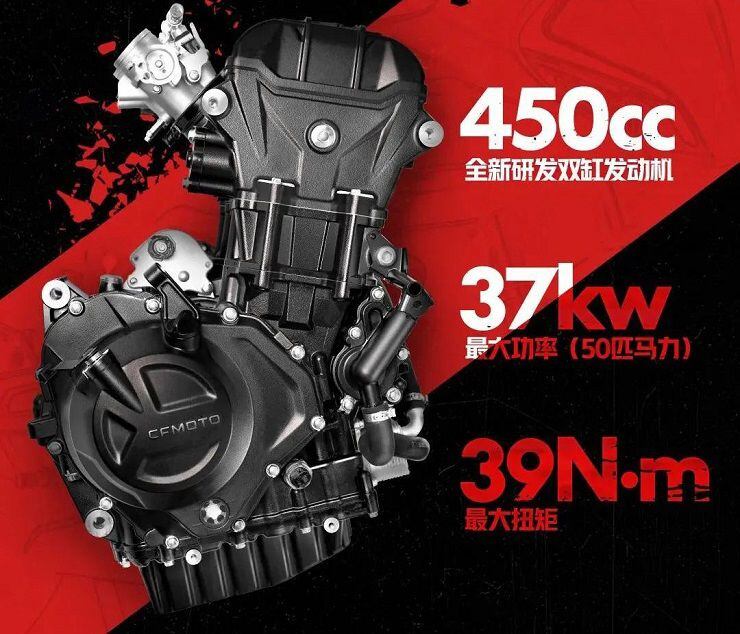
Specs for the completely new compact 449cc parallel-twin engine reveal 50 hp and 29 pound-feet of torque, along with a 270-degree firing angle. (CFMoto/) In terms of appearance, the 450SR is exactly as expected from the leaked image seen in March. In short, it adopts the SR-C21 concept’s styling, with just a handful of concessions to practicality and legality, most notably in the addition of larger headlights below the LED running lights at the front, as well as a pillion seat and elements like reflectors and mirrors. In CFMoto’s first official pictures, the bike even wears the same black and red paintwork as the concept model, although the white and blue that we saw last month will be an alternative option.
Differences from the concept also include the adoption of a dual-sided swingarm instead of a single-sider, while the front suspension is also downgraded from the concept’s Öhlins units to some currently unnamed forks. The race-spec Brembo brakes of the concept, with their carbon-cowled discs, are also gone—replaced by a single 330mm disc and a four-pot radial caliper. It’s still a Brembo, though, and is backed up by Bosch ABS.
Related: CFMoto’s SR-C21 Seems To Be More Than a Concept
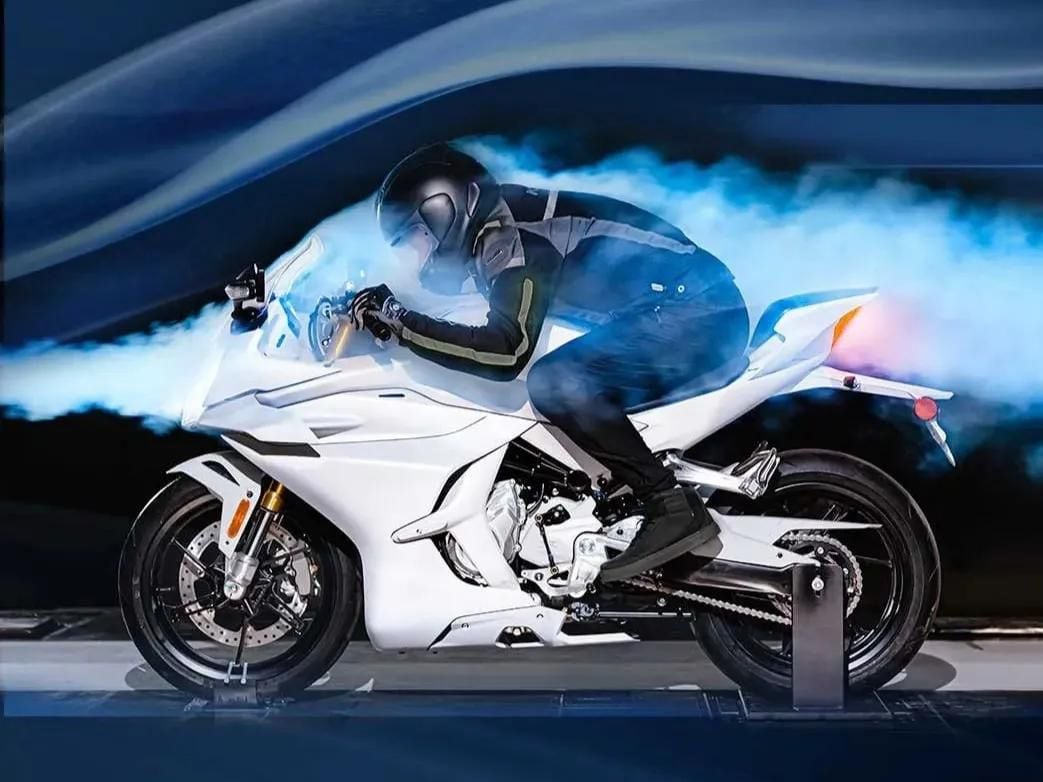
How effective they’ll be on a 450cc streetbike remains to be seen, but CFMoto says the 450SR’s fairing-mounted winglets are wind-tunnel tested. (CFMoto/) Like seemingly every other new-for-’22 sportbike, the 450SR features fairing-mounted winglets. Although they’re valuable on a 300 hp, 200-mph-plus MotoGP machine, it’s harder to make an argument for them on a 450cc, 50 hp streetbike that maxes out at 118 mph. However, CFMoto says they’re wind tunnel-tested and give 2 kilograms (4.4 pounds) of front downforce at 75 mph.
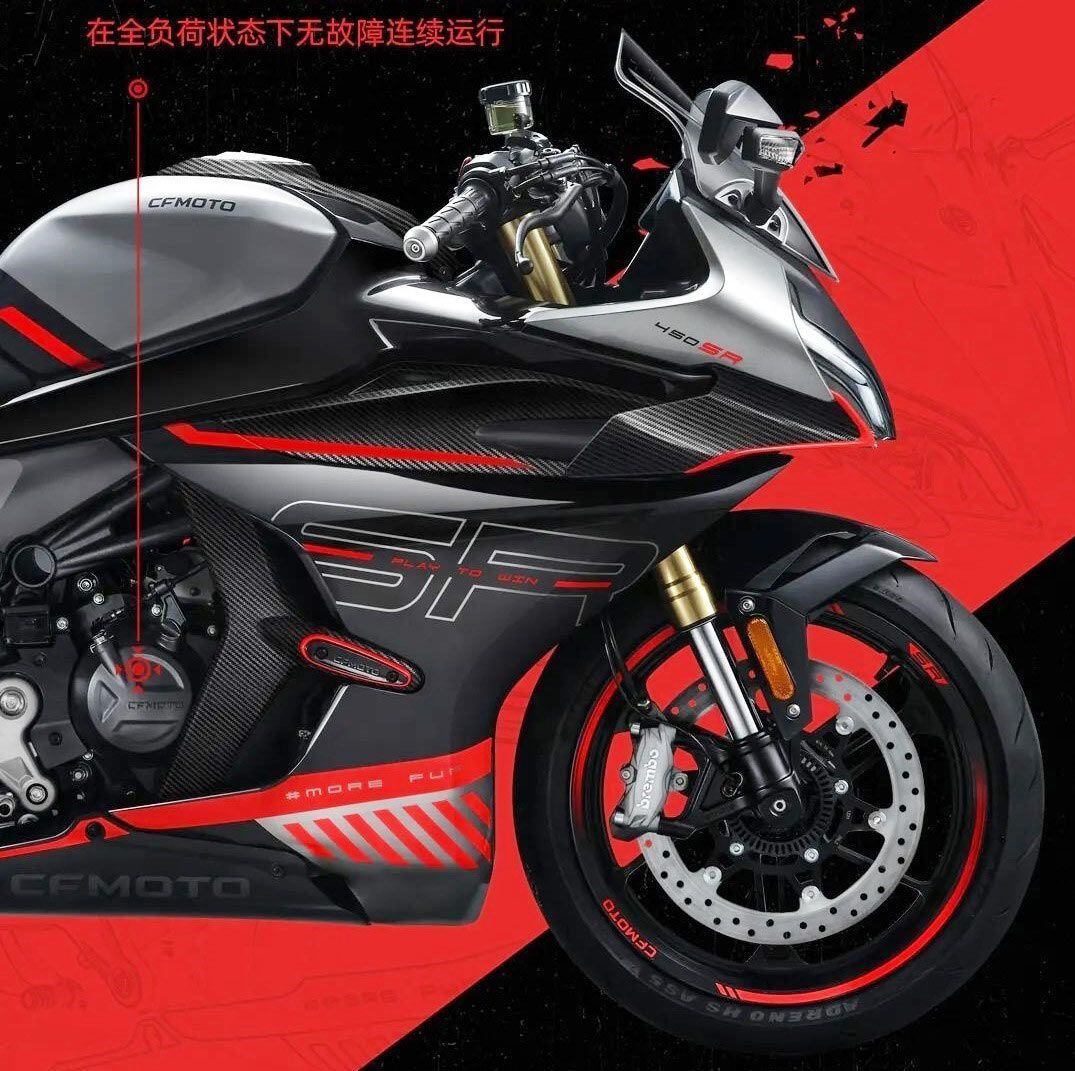
Up front, a single disc is clamped by a four-piston Brembo caliper and paired with Bosch ABS, though other technical details have yet to be revealed. (CFMoto/) Although full specs have yet to be announced, CFMoto is preparing to take orders for the bike in China, where it has an introductory price of 31,980 yuan ($5,000) and plans to begin deliveries in July. Given that the rest of CFMoto’s range is offered all over the world, it’s virtually certain the 450SR will follow suit, so there’s a good chance it will make its way here eventually.
-
Hello IngusM,
Welcome to The Motorbike Forum. Please feel free to browse around and get to know the others. If you have any questions please don't hesitate to ask.
Why not tell us a bit about yourself too.
-
Specifically kitted out for the upcoming MotoRally season, this Aprilia Tuareg’s got choice parts.
-
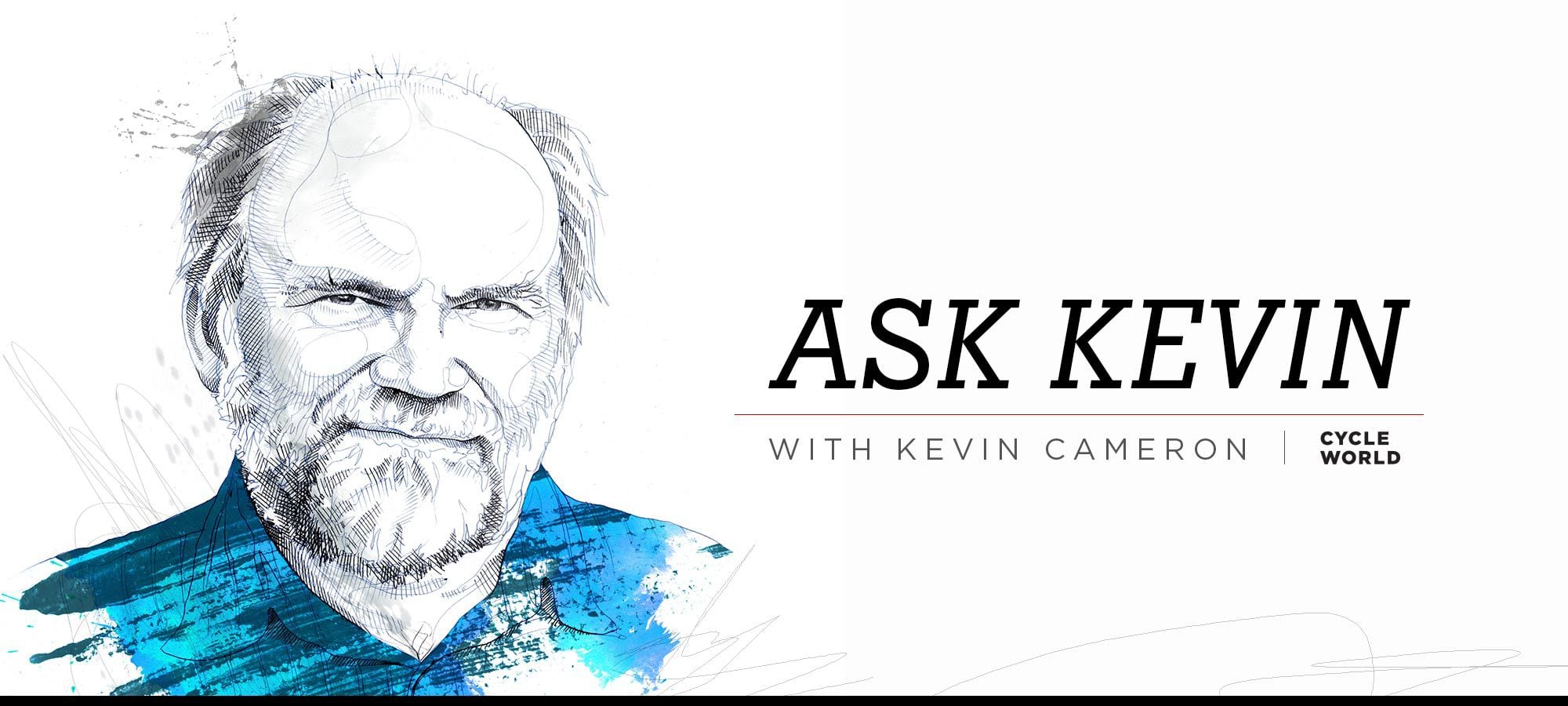
Kevin Cameron has been writing about motorcycles for nearly 50 years, first for <em>Cycle magazine</em> and, since 1992, for <em>Cycle World</em>. (Robert Martin/)In response to my recent “Bore, Stroke, and Engine Performance” story, Simon Felix wants to know if there are any oversquare engines (bore greater than stroke) that produce lots of low-end torque.
The classic example often given was built by Ford of Britain years ago. Combining oversquare bore and stroke with quite small valves and ports, it was remarkable for its bottom-end and midrange torque. There are other such engines as well.
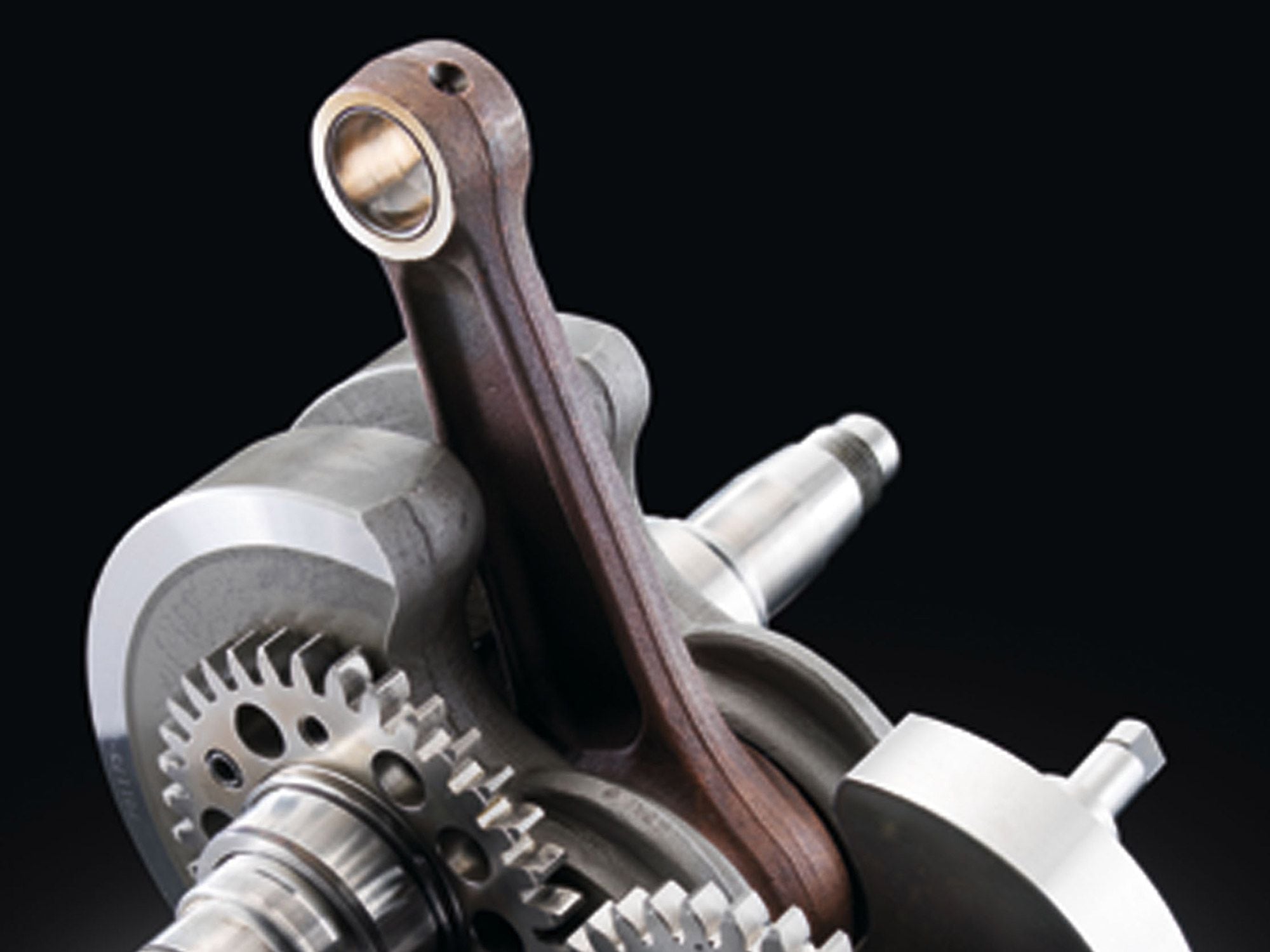
Engine torque is not entirely dependent on an engine’s stroke. (KTM/)Let’s compare two cylinders having the same displacement—one a stock Harley 114′s undersquare bore and stroke of 4.0 x 4.5 inches, and the other having the radically oversquare dimensions of 5.0 x 2.9 inches. Dividing the stock H-D’s 4.5-inch stroke by the rad example’s 2.9-inch figure tells us the Harley’s stroke is 1.55 times longer than the oversquare engine’s. Does that mean it will make 55 percent more torque? No. This is because the short-stroke cylinder’s bigger piston has more area for combustion gas to push against. When we do the arithmetic, we find that the big-bore, short-stroke cylinder has (wait for it) 1.55 times more piston area. The result, given equal cylinder-filling and combustion pressure, is that the two exactly cancel, and produce the same torque. This tells us that engine torque is not created by stroke length alone.
Intake Port Size and Torque
As builders have known for many decades, if you “hog out” an engine’s ports, what you’ll get is loss of bottom-end and midrange torque, resulting in a top-end-only “light switch” engine. How does opening up the ports kill torque? Once an engine’s intake stroke is about half completed, the inrushing air-fuel mixture is moving really fast. It is the kinetic energy associated with this velocity (K.E. = 1/2 M x velocity, squared, where M equals the mass of what’s in motion) that keeps the intake process going even though the piston is decelerating toward bottom center.
Making the intake valve and port bigger reduces mixture velocity, causing cylinder filling to be less complete at low- and mid-rpm engine speeds—returning the hard-to-ride “light switch” torque curve.
It works the other way too. The usual reason we build oversquare engines is to allow them to rev higher, so it’s normal to fill as much of the cylinder head’s area with the biggest possible valves. This was how British single-cylinder race engines evolved between the wars (1919–1939), with gradual reductions of stroke, increases of bore, and provision for larger and larger valves.
Building a Tractor
But what if we’re not trying to build a race engine? What if we’re an automaker needing a family-car powerplant with a wide torque range, yet all we have in production is an oversquare engine? Just put smallish valves and ports into a new cylinder head and—presto—now we have a tractor. Those small valves and ports don’t “know” how big the bore is or how short the stroke. All they know is that something is creating a pressure difference across the port. By half-stroke, intake velocity is very high, so as the piston approaches BDC at middling rpm, air keeps right on rushing into the cylinder, filling it well, resulting in wide torque.
Another less subtle example: Back in the 1970s both Ferrari and Alfa Romeo built flat-twelve F1 engines with large bores and short strokes. Ferrari’s 312T was quite successful, the Alfa less so. Now pull a cylinder head from each and invert it so we can see the combustion chambers. Alfa’s head has the biggest valves that will fit, but Ferrari’s has smaller valves with a lot more room around them.
Why? We know that if we make intake valves and ports too big, an engine can generate cylinder-filling high intake velocity only at the very top of its rev range. Ferrari chose smaller valves because that gave them stronger acceleration.
How Fast Is Too Fast?
We also know that if intake velocity is pushed too high by really small ports, air friction and even sonic shock formation put the brakes on flow, making the flow unable to keep up with the falling piston’s demand. This is what happens to stock Harley Big Twins as they approach 5,000 rpm—their short VW-like cam timing (very close to 180 degrees) and smallish valves and ports do a fine job of packing the cylinders with high-velocity mixture off the bottom and into the midrange (peak torque near 3,000 rpm), but as the pistons move even faster, intake air velocity rises into the friction-loss zone, so cylinder filling weakens. The engine is all done at 5,000 rpm. The very same thing would happen even if we changed the Harley’s bore and stroke to a radical 5 x 2.9 inches.
It is valve and port size that determine where in its rev range an engine will breathe its deepest. We associate long stroke and small bore with good low- and midrange torque because small valves and ports are all that will fit into a small bore. But the physics behind cylinder filling has to do with having the right intake velocity—not too low, not too high—in the rpm range where you need torque the most.
About the Oval-Piston Honda NR500
In the comments after my “Curtain Area” article, reader WR300R also asks an interesting question: “Was valve shrouding by its neighbors any part of the downfall of Honda’s NR500?”
The NR500 of the late ‘70s/early ‘80s was Honda’s attempt to build a four-stroke V-4 that could beat the 500cc two-stroke GP bikes fielded by Yamaha and Suzuki. To make power at very high revs the NR used oval pistons, each joined to the crankshaft by a pair of con-rods. Each cylinder also had eight valves—four intakes on one side of the oval, and four exhausts on the other—in a classic pent roof chamber. Although intended to give peak power at 23,000 rpm it eventually made 136 hp at 19,000 rpm, and never won a single GP point. Honda now regards it as the starting point for its family of round-cylinder four-valve V-4 bikes, including the RC213V racer which has carried Marc Márquez to six MotoGP world championships.
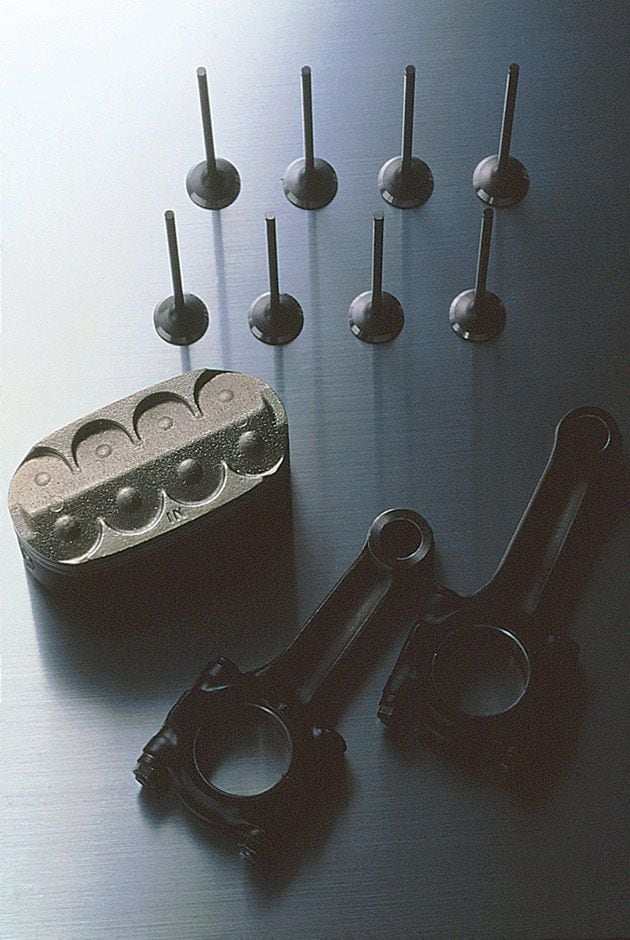
Honda’s NR500 had <i>eight</i> valves per cylinder. (Honda/)Those who have worked with conventional five-valve engines such as Yamaha’s FZR750 have noted that if only the two outer intake valves are operating, the flow through them is outstanding. But when the center intake operates with the other two, something happens that can result in less-than-expected flow. Do the flow streams interfere with each other? Did something similar happen, as our reader suggests, with the NR500 and its four intakes all in a row?
The Real Culprit
Cylinder filling and combustion in the NR seem to have been fairly good, at about 93 percent of what is regarded as outstanding, so I suspect Honda’s lack of results came more from being unable to reach the hoped-for peak-power revs of 23,000. Chronic piston cracking held them back, and when you calculate the NR’s peak piston acceleration, you find they were trying to make their pistons reliable at a level 30 percent higher than what was usual then in Formula 1.
Honda worked very hard on the NR, refining it through multiple designs. Had they succeeded in making reliable power at 23,000 rpm, then 165 hp might have been possible. The two-strokes reached that level in 1991, and six years later went on to produce 190 horses. To make that power from a four-stroke would have required reliability at 25,000 revs.
I heard the NR run at a few GPs in 1981. During warmup it made a deep booming sound, like the 1,000cc Superbikes of that time. But at speed, on the track, it was hard to tell from the two-strokes.
-
Hello hizzy11,
Welcome to The Motorbike Forum. Please feel free to browse around and get to know the others. If you have any questions please don't hesitate to ask.
Why not tell us a bit about yourself too.
-
Hello ColJ,
Welcome to The Motorbike Forum. Please feel free to browse around and get to know the others. If you have any questions please don't hesitate to ask.
Why not tell us a bit about yourself too.
-
Hello macnab51,
Welcome to The Motorbike Forum. Please feel free to browse around and get to know the others. If you have any questions please don't hesitate to ask.
Why not tell us a bit about yourself too.
-
A weekend full of exciting, off-road adventure awaits those who sign up.
-
Hello kristenpe,
Welcome to The Motorbike Forum. Please feel free to browse around and get to know the others. If you have any questions please don't hesitate to ask.
Why not tell us a bit about yourself too.
-
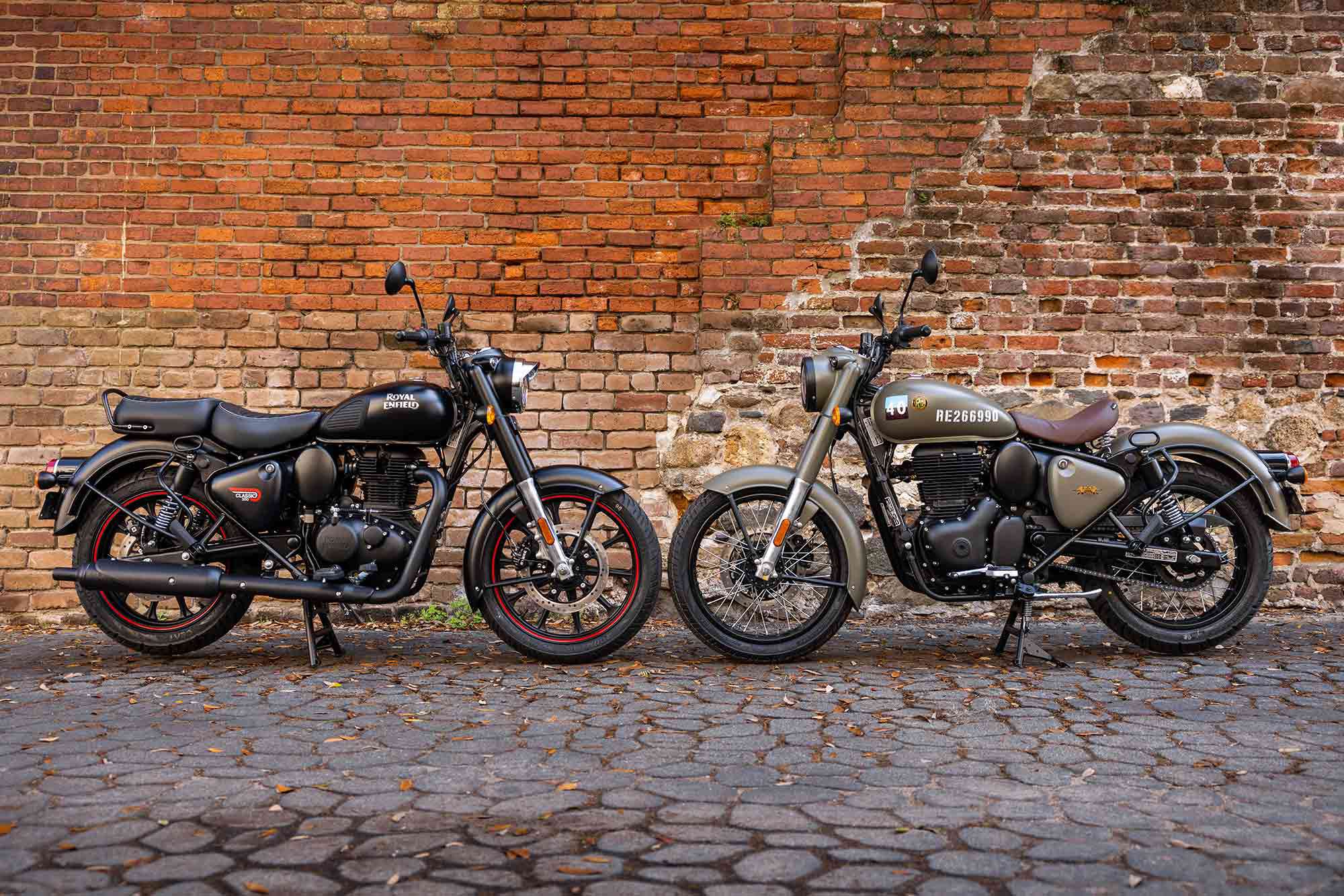
Royal Enfield meshes an all-new design of the 2022 Classic 350 with the post-war silhouette of its 1948 G2 350. (Royal Enfield/)If there’s ever been a company able to throw around the term “classic” all willy-nilly, it’s Royal Enfield. That’s because the company has been continuously producing motorcycles since 1901. Originally founded in England, the brand produced bikes there until its factories in Redditch and Bradford on Avon were shuttered in 1970. Its Indian subsidiary survived and was eventually acquired by The Eicher Group. That provided the chance for rebirth, and the Chennai company has been streaking forward ever since.
In recent years, Royal Enfield has introduced a string of new models that have made a respectable mark, including the Himalayan and the Meteor 350, which join long-time stalwarts like the Continental GT and Bullet. For 2022, RE has brought back the Classic 350, the best-selling model in the company’s long history, which was inspired by the 1948 G2 350 Bullet—the first bike with an articulating swingarm! The Classic was brought back to provide the simplicity of pure riding enjoyment in a basic package, with nostalgic styling, but powered by an all-new modern engine.
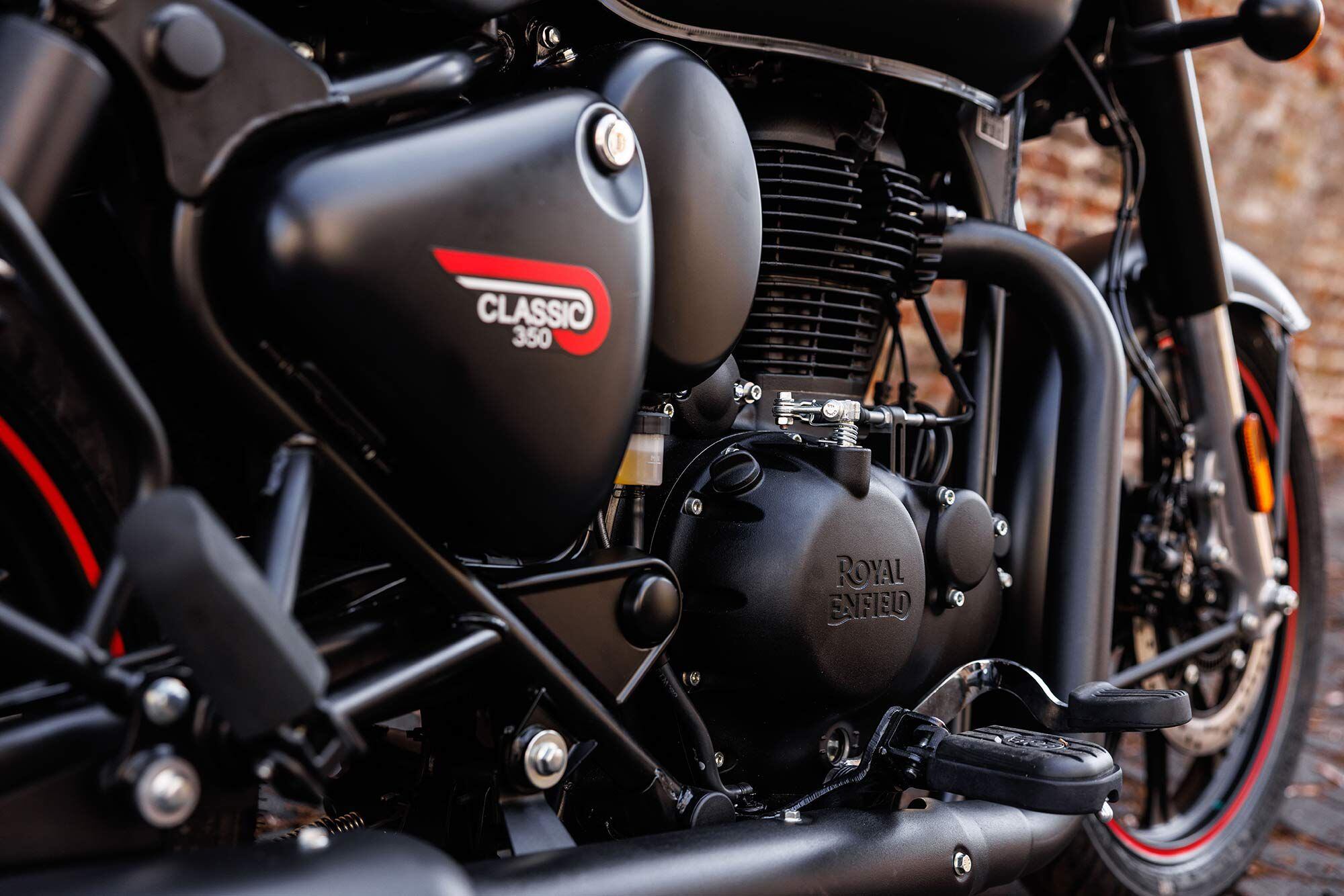
The Classic 350 is powered by the same air/oil-cooled 349cc DOHC powerplant as seen in the Royal Enfield Meteor 350, which we’ve become fond of for its gradual power delivery and gentle personality. (Royal Enfield/)“Throughout our history, we have been consistent in our pursuit to build timeless, beautiful motorcycles that are great fun to ride, and the new Classic 350 does just that,” said Siddhartha Lal, Managing Director of Eicher Motors Ltd. “The all-new Classic 350 combines this quintessential, retro design with a modern and refined ride experience. We are confident that the all-new Classic 350 will once again redefine the midsize motorcycle space, globally.”
Its brand-new single-cylinder DOHC counterbalanced air/oil-cooled 349cc J-series engine first found life in the Meteor 350 and puts out a claimed 20.2 hp at 6,100 rpm and 19 lb.-ft. of peak torque at 4,000 rpm. Fueling is provided by EFI, while the classic pea-shooter exhaust gets rid of spent gasses. Power is sent through a wet multiplate clutch to the five-speed transmission and then onto a chain final drive.
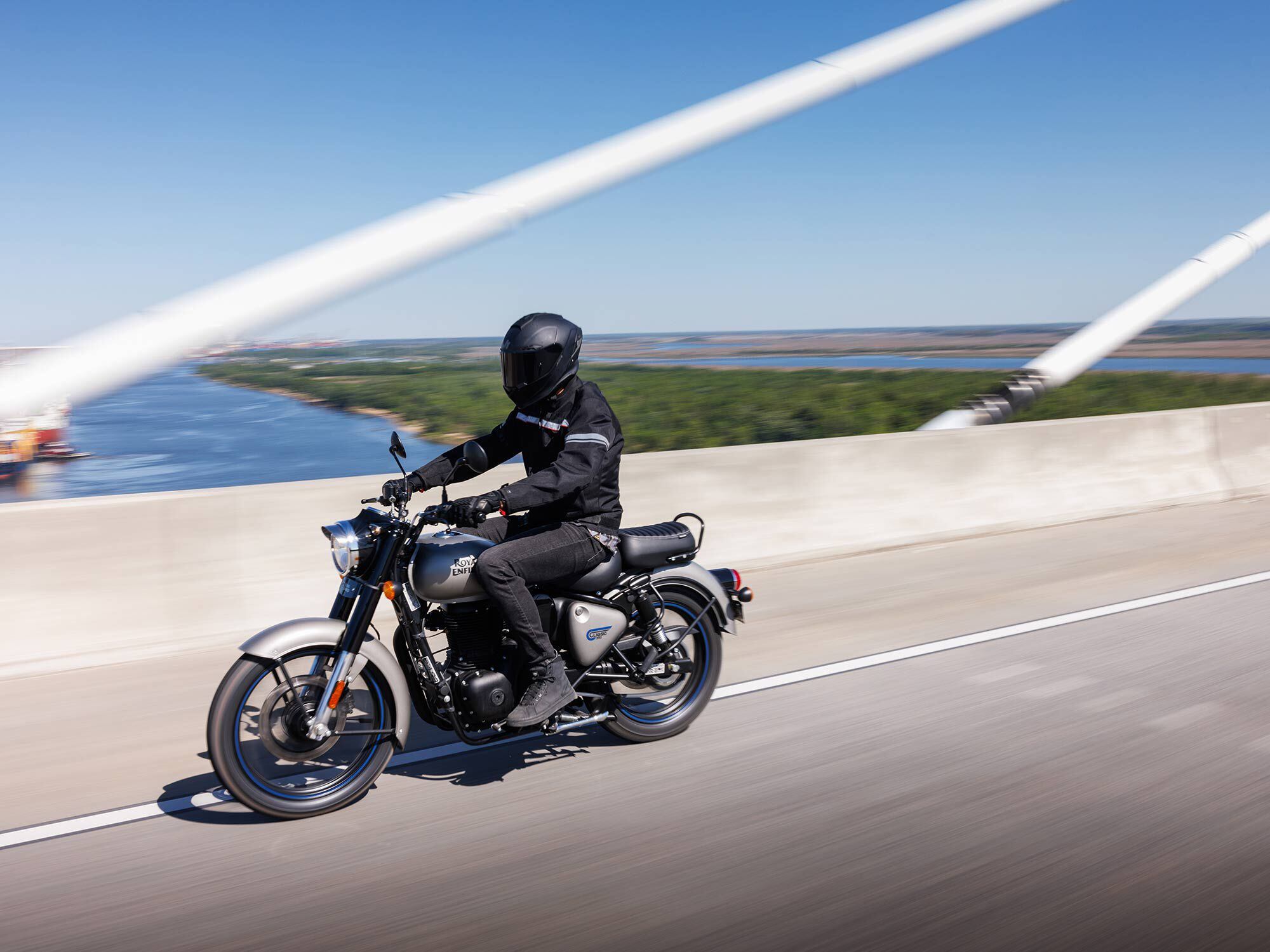
The Royal Enfield Classic rides on an all-new steel twin-downtube spine chassis and a 41mm fork. A pair of twin tube emulsion shocks handle the rear end’s damping needs, and offer six-steps of spring-preload adjustment. (Royal Enfield/)“We’ve paid great attention to every aspect of the motorcycle, right from its stunning look to the perfection in parts and the touchpoints to its impeccable riding performance,” adds Lal. “The engine is super smooth, intuitively responsive and engaging, and has that gorgeous growl on acceleration.”
This engine bolts into an all-new, steel twin-downtube spine frame that RE claims has been strengthened for better stability and more precise handling. Plush suspension is provided by a conventional 41mm fork with just over 5 inches of travel and a pair of twin tube emulsion shocks with six steps of spring-preload adjustment. Most models ride on spoked chrome alloy inner-tube wheels with a 19 in. front and 18 in. rear, while the Dark models have 10-spoke (tubeless) alloy wheels in the same diameters. Both versions come with 100/90-19 front and 120/80-18 rear tires made by CEAT. Braking is handled by ByBre (Brembo’s Indian subsidiary) components with a single 300mm disc and twin-piston floating caliper on the front, and a 270mm disc/single-piston floating caliper out back. The system features dual-channel ABS.
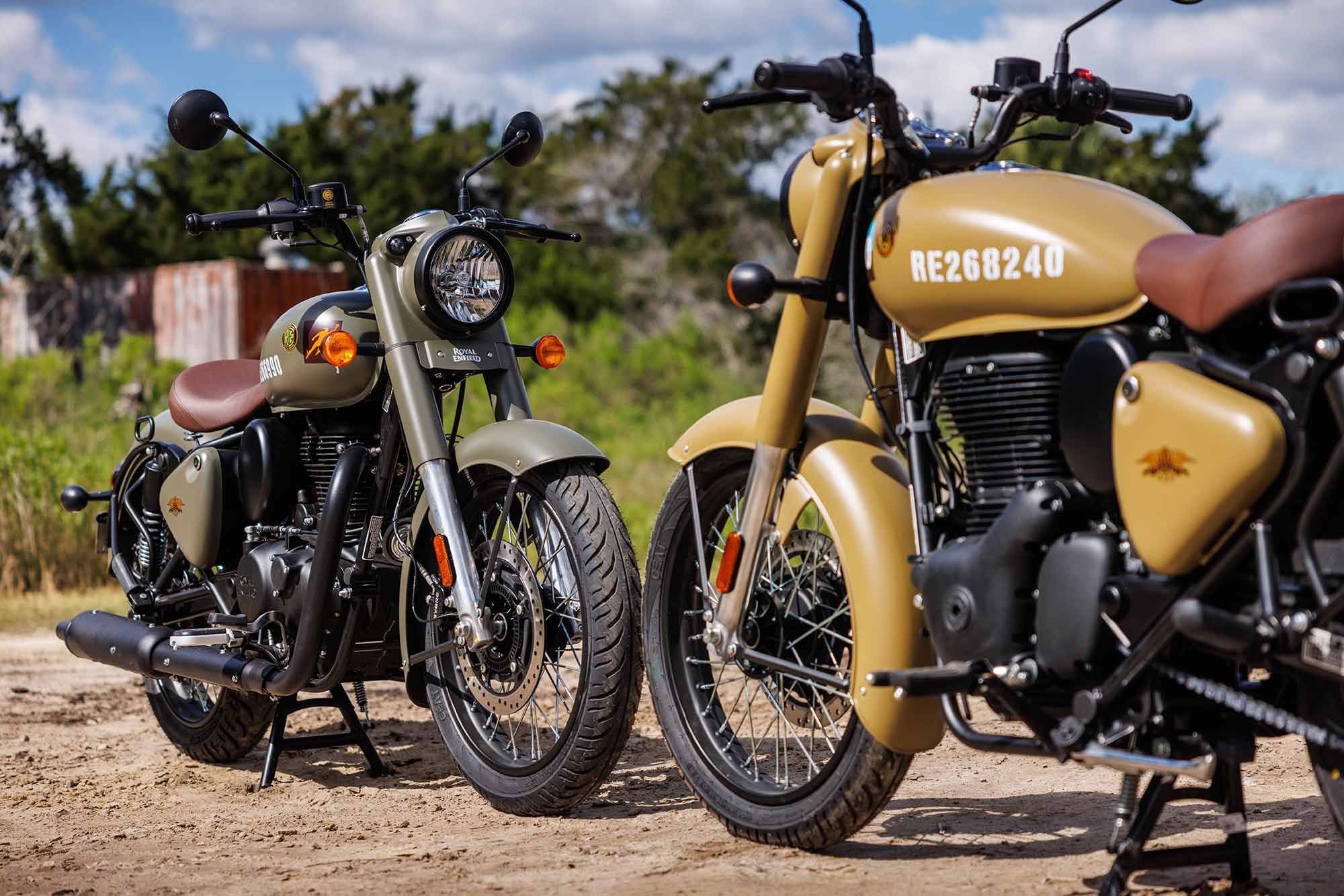
The Royal Enfield Classic 350 is available in several unique colorways. The Signals Desert Sand and Signals Marsh Grey seen here pay homage to the Indian army with 1950s military-inspired graphics and wire-spoke wheels. (Royal Enfield/)“The all-new chassis lends enormous confidence while riding, with surefooted handling and agile braking,” continues Lal. “The motorcycle feels in control and well-mannered around tight corners. The motorcycle is, without a doubt, class-leading, and feels incredibly refined and enjoyable to ride.”
Everything about this bike was designed to be fun and friendly to a wide range of riders. Key to that goal is a low 31.7-inch seat height that ensures that riders of all heights can get their feet firmly planted on the ground. The thickly padded seat promises a comfortable place to sit whether you’re making a quick trip around town or on a long ride over the weekend. Want to take a passenger? No problem, as there are passenger accommodations. Still, the rear pillion seat and passenger pegs are removable if you prefer that look and don’t want someone hanging on your back.
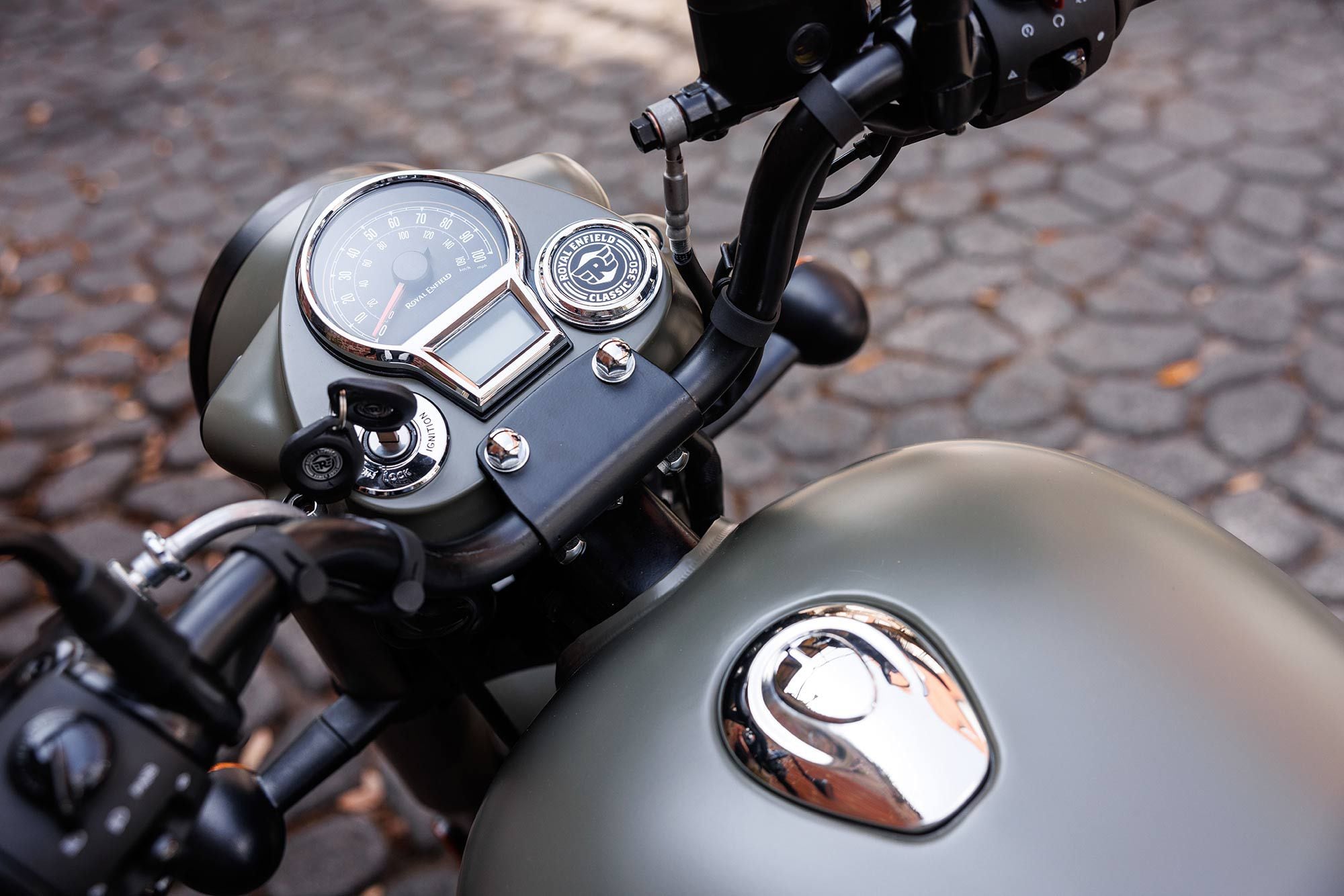
Despite being the Classic 350, Royal Enfield mixed premium fit and finish throughout, including the analog tachometer and LCD display. (Royal Enfield/)A mid-rise handlebar should help provide a relaxed and upright riding position, while mid-mounted foot controls with rubber inserts should put most rider’s legs into a gentle bend that won’t cramp them up on longer rides. Looking out over the single traditional headlight is an analog speedometer with a variety of warning lights and even an ECO-mode indicator that lets you know when you’re being mellow with the throttle hand and consuming fuel at the most efficient rate. Speaking of fuel, the classic teardrop tank has a 3.4-gallon capacity and should provide good range from this mellow engine.
The Classic 350 will be available in nine different styles and colors. Available in April of 2022 are the Dark Stealth Black and Dark Gunmetal Grey models that come with 10-spoke alloy wheels and tubeless tires for $4,599. Also arriving in April are the Signals Desert Sand ($4,599) and Signals Marsh Grey ($4,599) models that were inspired by Royal Enfield’s association with the Indian armed forces and feature 1950s era military graphics. Later in 2022, five more color options will be available including Halcyon Forest Green, Halcyon Black, or Halcyon Blue, all three of which are $4,499. Chrome Red and Chrome Brown with mirror-finish tanks and special badging will run $4,699.
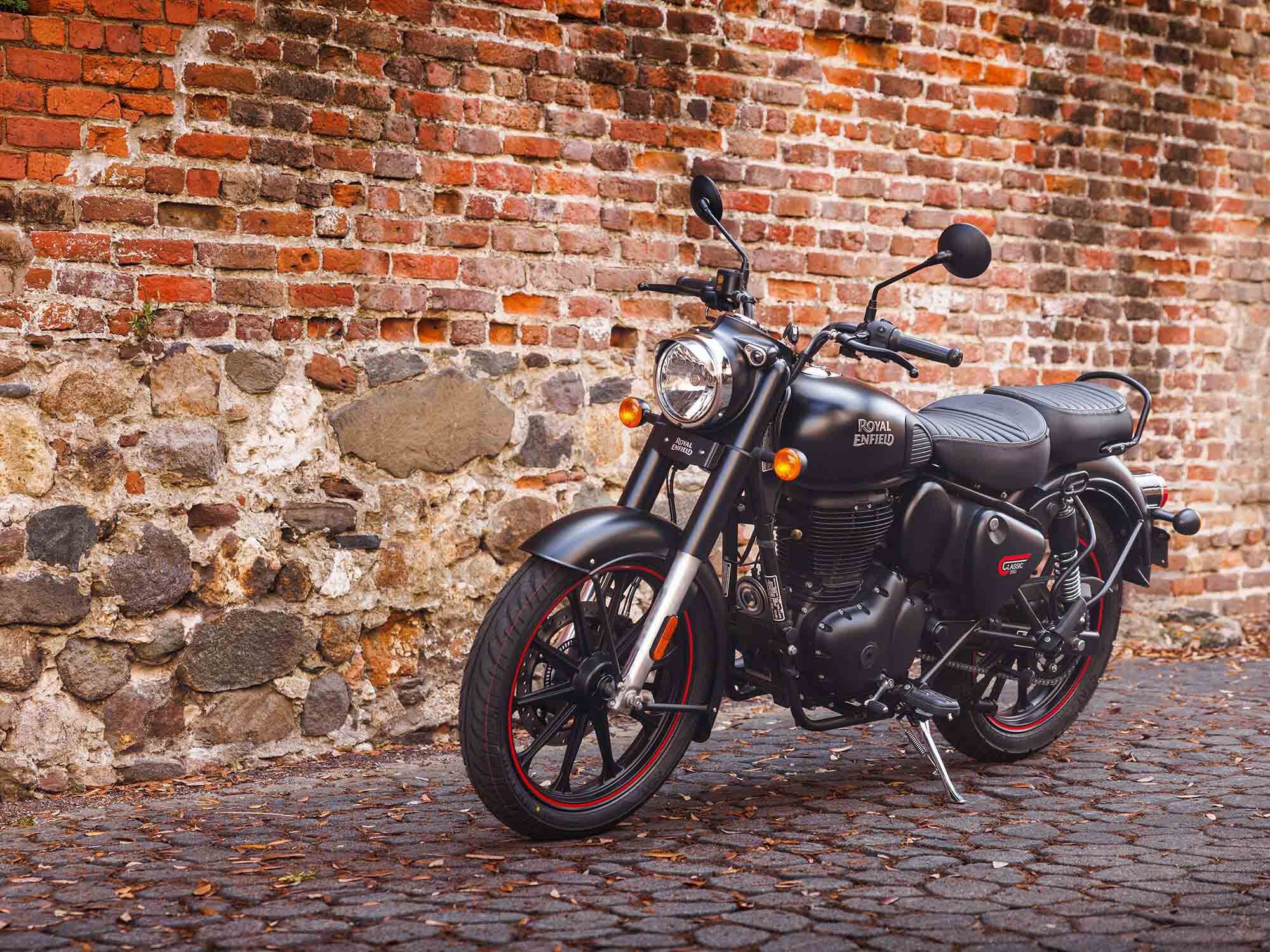
The Royal Enfield Classic 350 arrives stateside in April of 2022. (Royal Enfield/)2022 Royal Enfield Classic 350 Claimed Specifications
MSRP: $4,499-$4,699 Engine: 349cc, air/oil-cooled, DOHC single Bore x Stroke: 72.0mm x 85.8mm Transmission/Final Drive: 5-speed/chain Claimed Horsepower: 20.2 hp @ 6,100 rpm Claimed Torque: 19 lb.-ft. @ 4,000 rpm Fuel Delivery: Electronic fuel injection Clutch: Wet, multiple disc, cable operation Engine Management/Ignition: Electronic Frame: Twin-downtube spine steel Front Suspension: 41mm telescopic fork; 5.1-in. travel Rear Suspension: Twin tube emulsion shock absorbers; preload adjustable Front Brake: ByBre 2-piston floating caliper, 300mm disc w/ ABS Rear Brake: ByBre 1-piston floating caliper, 270mm disc w/ ABS Wheels, Front/Rear: Spoked wheels w/ alloy rims (Signals, Halcyon, Chrome); 10-spoke Alloy (Dark Stealth); 19 in. / 18 in. Tires, Front/Rear: 100/90-19 / 120/80-18 Rake/Trail: N/A/ N/A Wheelbase: 54.7 in. Ground Clearance: 6.7 in. Seat Height: 31.7 in. Fuel Capacity: 3.4 gal. Wet Weight: 430 lb. Contact: RoyalEnfield.com -
Hello kurtbayne,
Welcome to The Motorbike Forum. Please feel free to browse around and get to know the others. If you have any questions please don't hesitate to ask.
Why not tell us a bit about yourself too.
-
Hello jmg1992,
Welcome to The Motorbike Forum. Please feel free to browse around and get to know the others. If you have any questions please don't hesitate to ask.
Why not tell us a bit about yourself too.
-
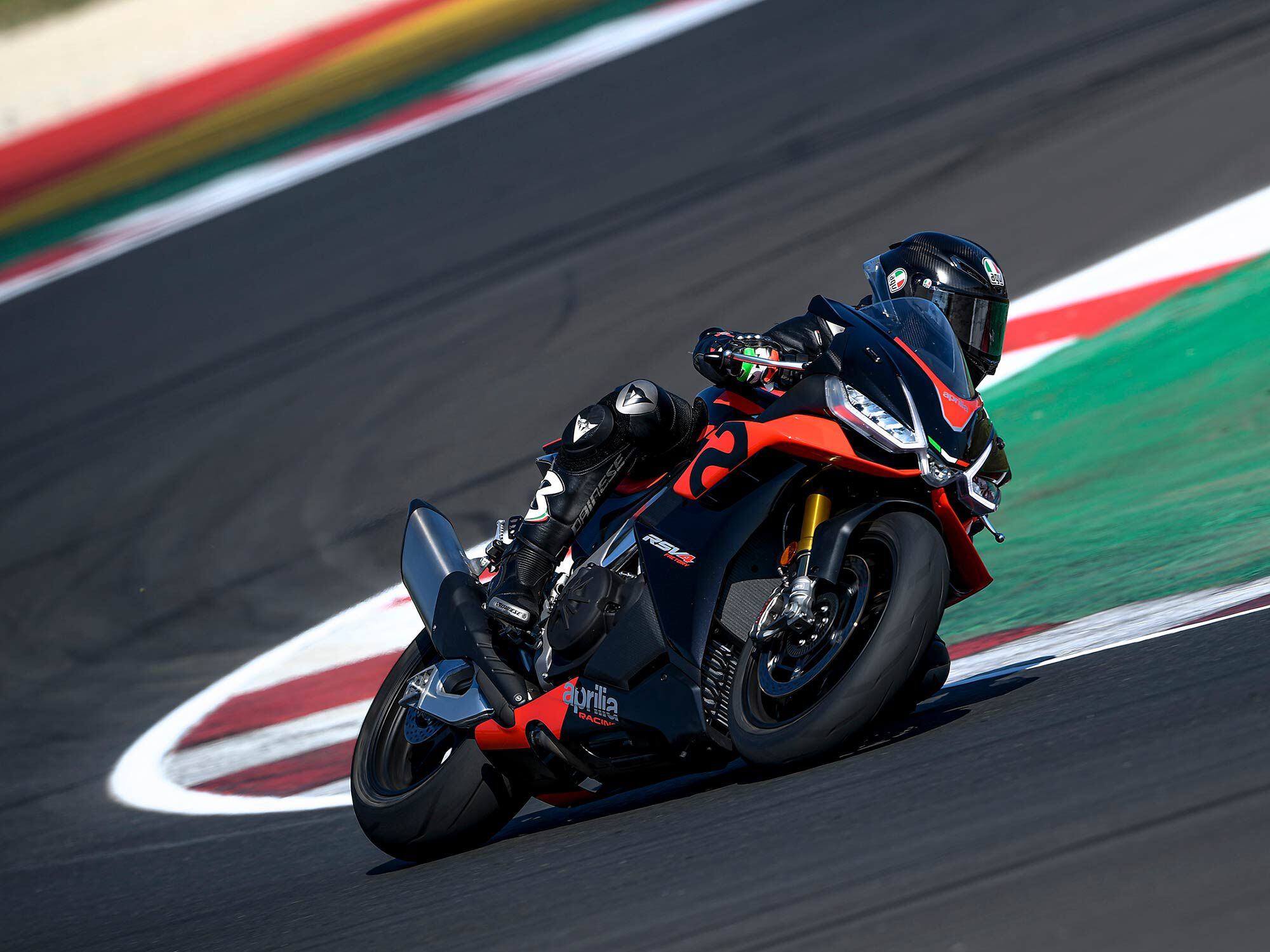
Want Max Biaggi as your riding coach? Check out the Aprilia Pro Experience. (Aprilia/)Many sport riders dream of lapping world-class MotoGP circuits, carving the same lines as their favorite Grand Prix motorcycle racers.
Imagine doing just that; training with some of the world’s most famed moto racers, with Max Biaggi as your head coach.
The all-new Aprilia Pro Experience provides the opportunity to complete this feat at the Misano World Circuit Marco Simoncelli in Northern Italy this May.
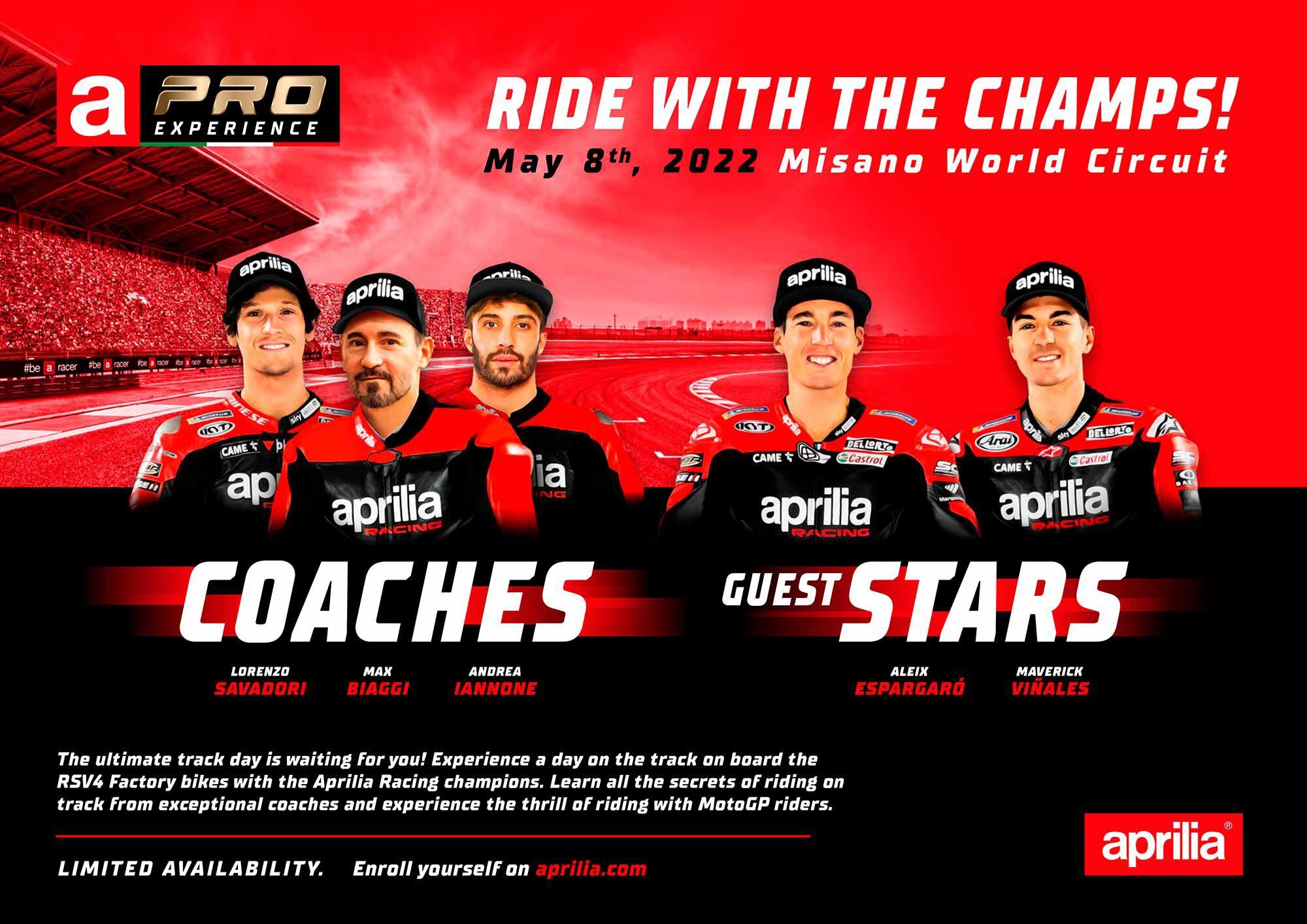
Here's the Aprilia Pro Experience lineup: coaches Lorenzo Savadori, Max Biaggi, and Andrea Iannone, with on-track riders Aleix Espargaró and Maverick Viñales. (Aprilia/)Heading up the coaching staff is Biaggi, who holds six world titles: four straight in 250cc World Championships (1994-1997) and two in World Superbike (2010, 2012). Biaggi, who will be inducted into the MotoGP Legends Hall of Fame ahead of the Italian Grand Prix at Mugello in May, will have some “super coach” assistance from other notable world-class motorcycle racers: Lorenzo Savadori and Andrea Iannone.
Savadori claimed the European 125 GP title with Aprilia in 2008 and is currently a test rider for Aprilia. He also dominated the CIV Superbike season, winning six out of eight races in 2020 to take the title. In addition, he tests the RS-GP MotoGP prototype and will compete as a wildcard in select rounds this season. Iannone is also a former Aprilia MotoGP pilot and has experience across Grand Prix Motorcycle Championship racing since 2005.
Participants will turn laps with Aprilia Racing MotoGP riders Aleix Espargaró and Maverick Viñales. Both GP pilots will discuss their lifestyles as international motorcycle racers competing at the top level of their sport.
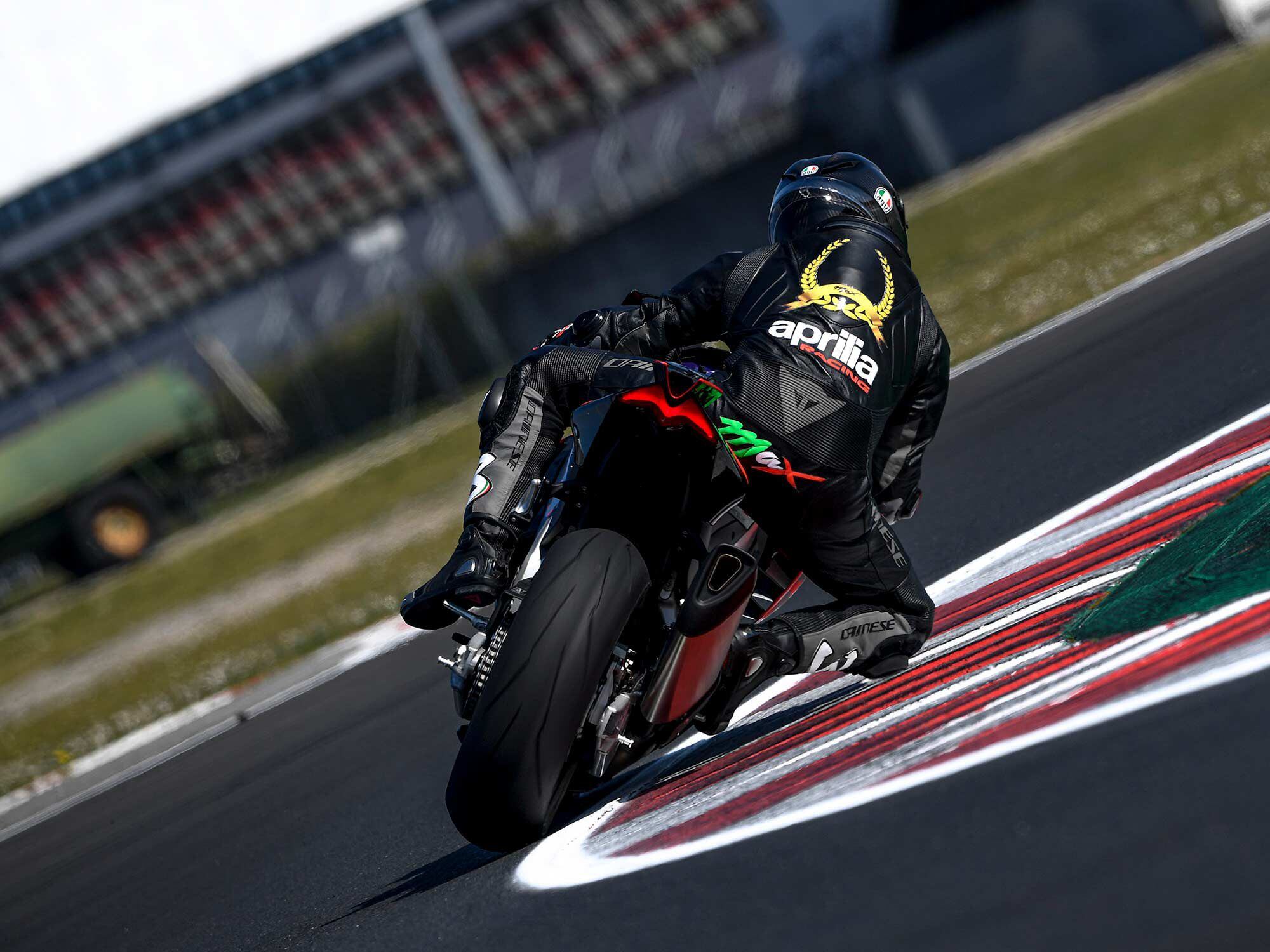
Six-time World Champion Max Biaggi makes riding fast look easy. (Aprilia/)Of the one-day event slated for Sunday, May 8, Aprilia says in the press release, “Each ‘super coach’ will be assigned to four participants, thereby ensuring as much attention and supervision as possible for everyone both during the training activities in the box and during practice on the track.
“The exclusive package includes six sessions, twenty minutes each, astride the bike that has set the bar in the superbike category for years: the refined and powerful Aprilia RSV4 Factory, the same one the rider-coaches will also be riding, to guarantee a truly memorable day.”
During the day, Aprilia Pro Experience riders will take breaks with their coaches, each one limited to only four riders, and analyze their laps through the onboard video from each RSV4 Factory model. Participants will also receive professional photos from the event.
For additional information or to sign up for the event, visit Aprilia.com.
-
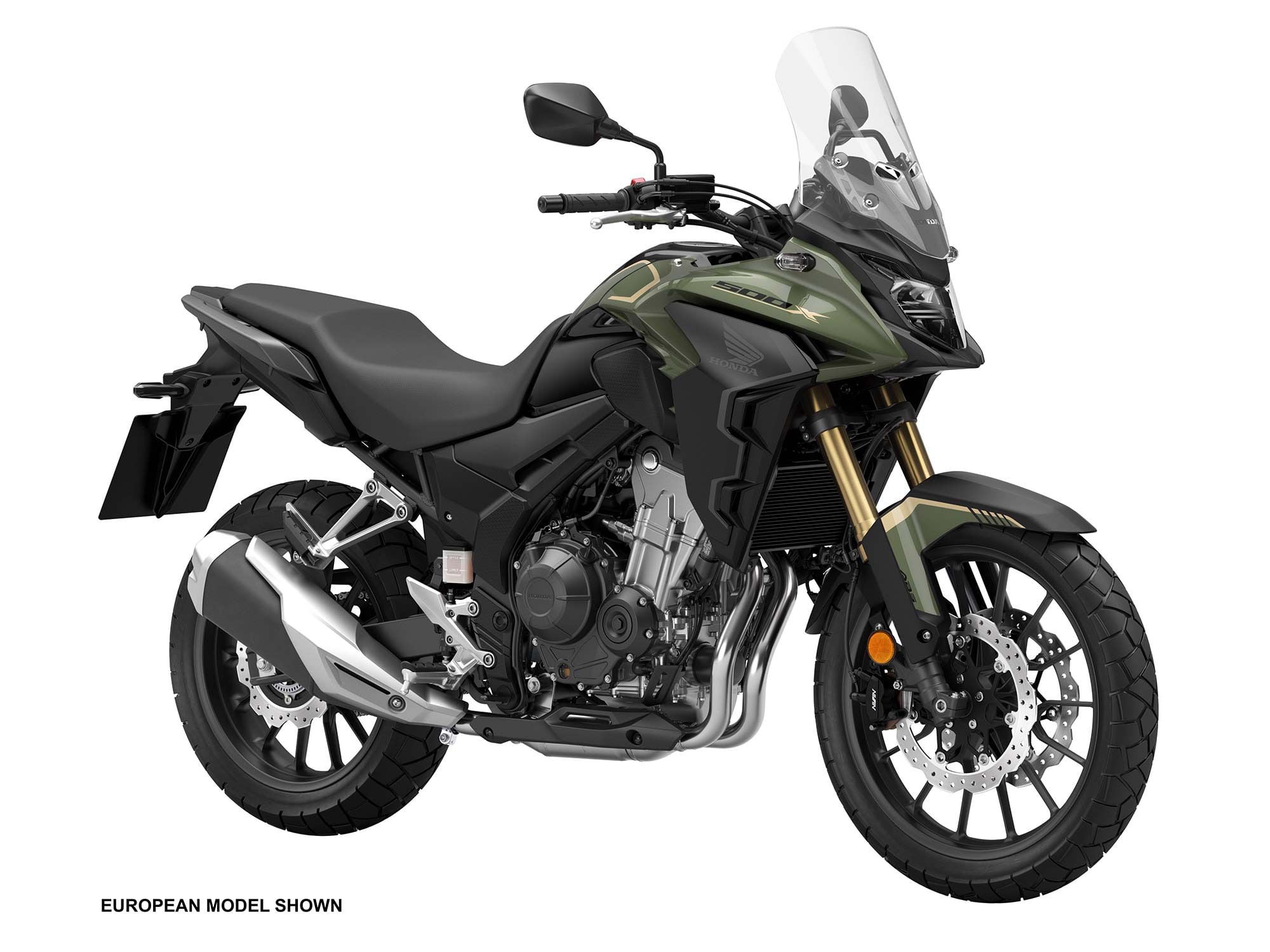
Consider the Honda CB500X a “light middleweight” adventurer that’s ready to serve as a city commuter on weekdays but then deliver actual off-road adventure on weekends. (American Honda/)Ups
- Upright seating position with good wind protection
- Low seat height welcomes riders of all heights
- New dual-disc front brakes (with standard ABS) and upgraded fork
Downs
- Handlebar too low to comfortably accommodate standing off road
- Windscreen requires tools for height adjustment
- No provisions for fork adjustment
Verdict
When it comes to entry-level adventure-style motorcycles, the Honda CB500X is an amazing value at $7,199. The bike is more at home on the asphalt than the dirt, but is perfectly capable of tackling gravel roads too. For 2022, Honda upgraded the fork, braking system, and made a few other chassis-related improvements. Riders who want to give adventure riding a try for the first time or those just looking for a comfortable, upright, and all-around practical motorcycle should definitely check out the 500X.
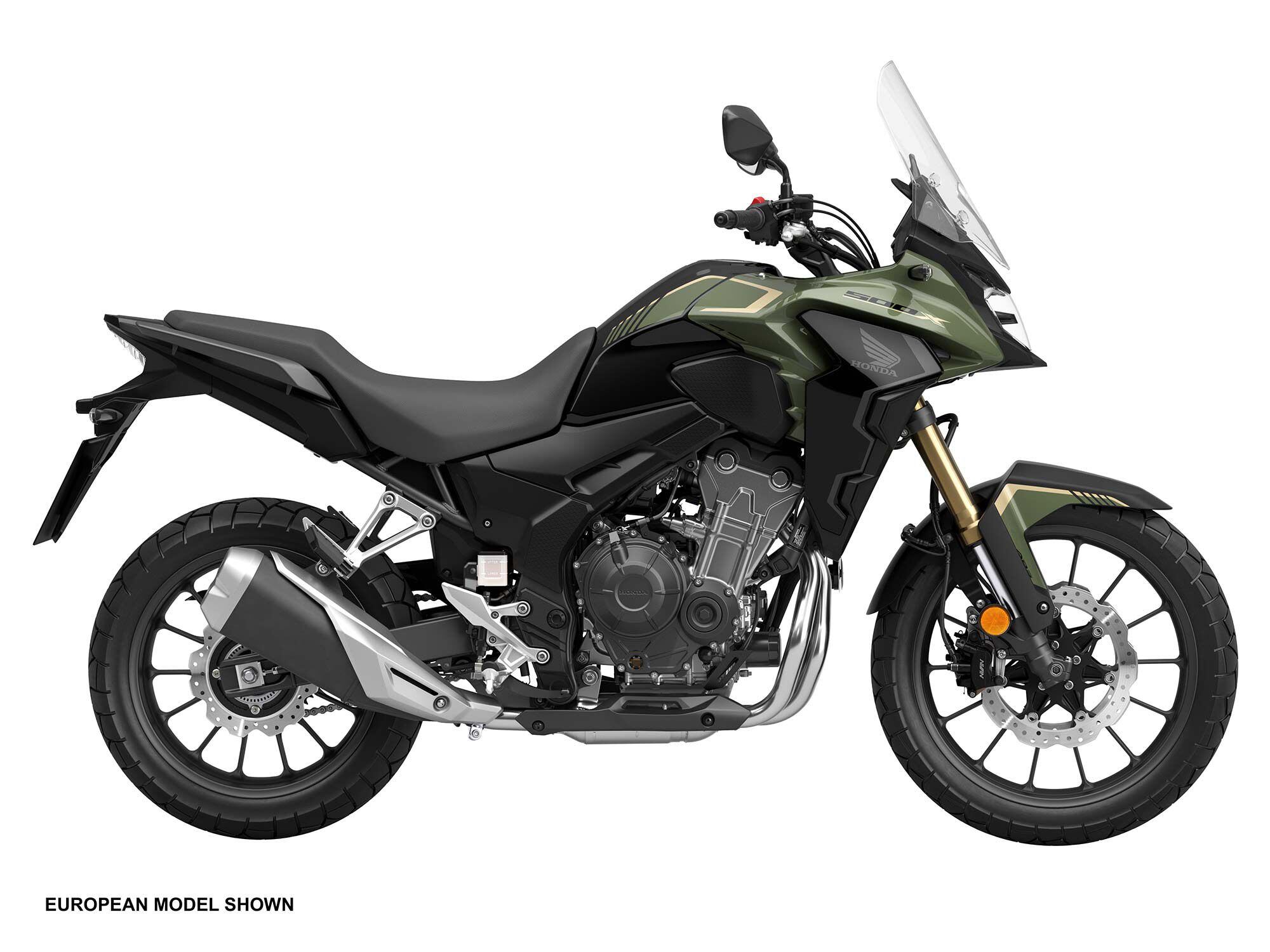
For 2022, Honda upgraded the CB500X’s fork, braking system, and made a handful of chassis-related improvements, including new wheels and a redesigned swingarm. (American Honda/)Overview
Honda has long taken on the responsibility of encouraging new riders into the sport, and the CB500 range of bikes is proof. This trio of machines includes the naked CB500F, fully faired CBR500R, and the adventure-styled 500X detailed here. An argument can quickly be formed that the CB500X is the most practical and versatile of the lot. With an upright seating position, tall and protective windscreen, dual 296mm disc brake setup up front (with standard ABS), adventure-oriented wheel sizes (19-inch front and 17-inch rear), dual-purpose-style tires, and a tractable parallel-twin engine, the “light middleweight” adventurer is ready to go wherever you want to travel.
Originally launched in 2013, the CB500X brought crossover adventure style to Honda’s fun-focused 500cc lineup. Driven by customer feedback, the CB500X has become more adventurous over time. A 2016 upgrade included a larger fuel tank and more wind protection via a taller screen. The bike also gained LED lighting, a spring-preload-adjustable fork and an adjustable brake lever.
Another evolution happened in 2019, with Honda updating the engine for increased torque and roll-on performance. The switch to a 19-inch front wheel (from a 17-incher) was a nod to the bike’s adventurous personality, while comfort features like a 20mm-taller windscreen and full-featured display were added to help the CB500X stand out in an ultracompetitive category.
If you’re looking to get your feet wet (or muddy?) in the world of adventure riding, are a newer rider, or a seasoned vet looking for an affordably priced choice, the CB500X is definitely worth consideration.
Updates for 2022
Having already gained recognition for its versatile performance, the CB500X receives modest but purposeful updates for 2022. Engine changes include revised fuel-injection settings and a lighter radiator, while the chassis benefits from the switch to an inverted Showa 41mm SFF-BP fork, dual Nissin radial-mount four-piston calipers biting 296mm rotors, lightweight wheels that feature thinner spokes, and a redesigned swingarm for improved rider comfort and handling performance. Compared to the previous model, claimed curb weight is 5 pounds lighter at 439 pounds, and weight bias also moves slightly forward for enhanced front-tire grip and feel. The front/rear weight bias percentage is 48.7/51.3 compared to the previous 48/52.
Styling updates are limited to just a larger front fender.
Pricing and Variants
Now that ABS is standard, there is only one version of the CB500X, which is available in one color scheme: Pearl Organic Green/Black for $7,199.
Competition
Although there are few 500cc twin-cylinder competitors, there are many similarly styled, entry-level ADV models that could be considered alongside the CB500X. The KTM 390 Adventure, Kawasaki Versys-X 300, Royal Enfield Himalayan, and BMW’s G 310 GS are a bit smaller in displacement, while the KTM 690 Enduro R, Yamaha Ténéré 700, and Suzuki V-Strom 650 sit on the other side of the spectrum with larger engines. Although visually similar but at the far end of the price and displacement scale—for those ready to jump into the deep end—there is Ducati’s Multistrada V2.
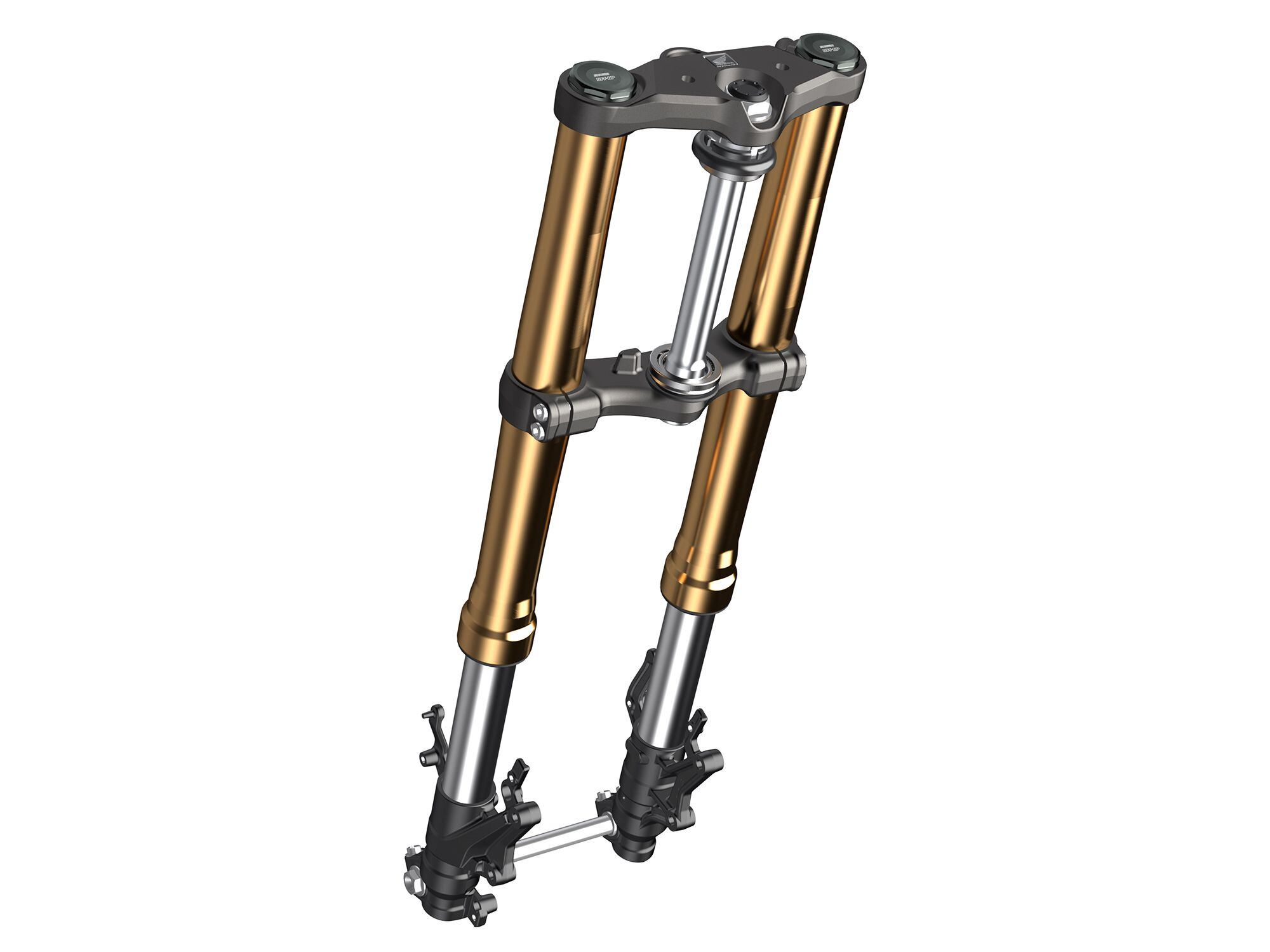
The previous year model's conventional fork has been replaced with a Showa 41mm inverted Separate Function Fork Big Piston (SFF-BP) fork with 5.9 inches of cushion stroke, held by new upper and lower triple clamps. (American Honda/)Powertrain: Engine, Transmission, and Performance
At the core of Honda’s CB500 range is a 471cc liquid-cooled parallel-twin engine with new fuel-injection settings targeting improved torque feel and character. Exhaust is expelled through twin pipes that lead to a low-mount muffler. Power is delivered to the rear wheel via a Slipper Assist Clutch (with a claimed 45 percent less lever effort than a traditional clutch), through a six-speed transmission to a chain final drive.
In our most recent test Cycle World described the engine performance as such: “The engine, although docile, was in no way lacking when it came to the spirited paces of Southern California’s busiest freeways. Its 42.45 hp at 8,130 rpm and 29.25 pound-feet at 6,500 rpm recorded during a fourth-gear pull on the CW in-house dyno are plenty for an adventure motorcycle meant to be friendly and usable.” Power delivery is predictable, making it easy to comfortably tackle gravel roads on fun adventures out of the city.
Handling
Lightweight and nimble, Honda designed the CB500X for easily navigating traffic, canyon roads, dirt trails, and everything in between. The suspension components on previous-generation CB500X models left riders wanting a little more, with Cycle World commenting, “On the pavement, the CB-X’s 41mm fork and single shock are soft and don’t allow for a planted feel in switchbacks—mid-turn bumps have the rear pogoing over those undulations, causing instability.” The changes for 2022 look to address those criticisms, and while test riders have yet to log miles on the platform, we’ll soon see if the 2022 model can match or beat the performance we experienced on the 2020 bike.
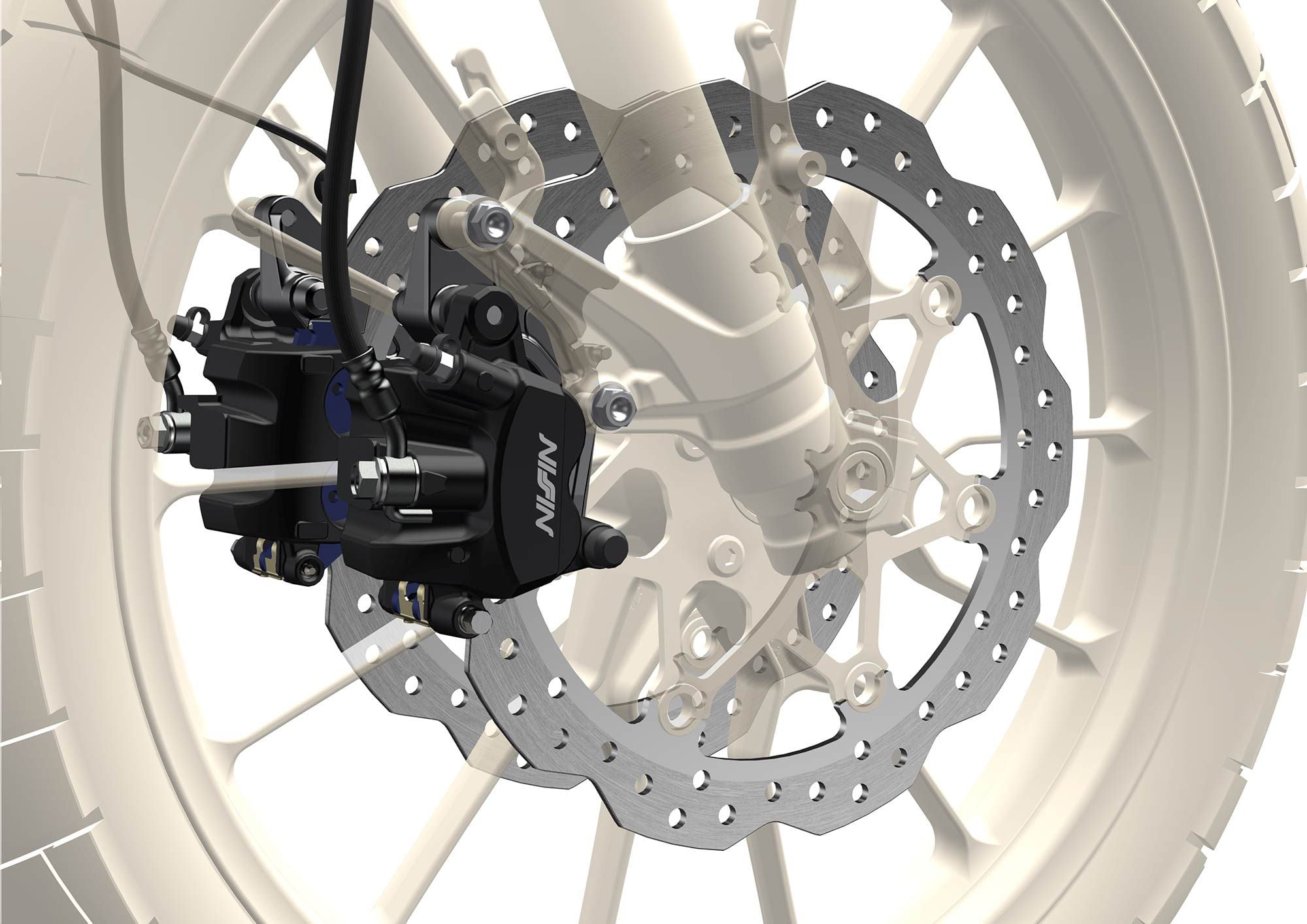
The 2022 CB500X’s dual 296mm petal-style rotors (versus single 310mm brake disc on the 2021 model) and axial-mounted Nissin two-piston calipers require less lever pressure when braking, while keeping any weight gain to a minimum. (American Honda/)Brakes
On the previous model, we felt the braking was adequate with that bike’s single front disc/twin-piston-caliper setup. The addition of two slightly small-diameter (296 versus 310mm) discs with twin-piston calipers should in theory be a big improvement in performance and feel. Honda claims that the required lever pressure when braking has been reduced, and that the smaller disc size keeps any weight gain to a minimum.
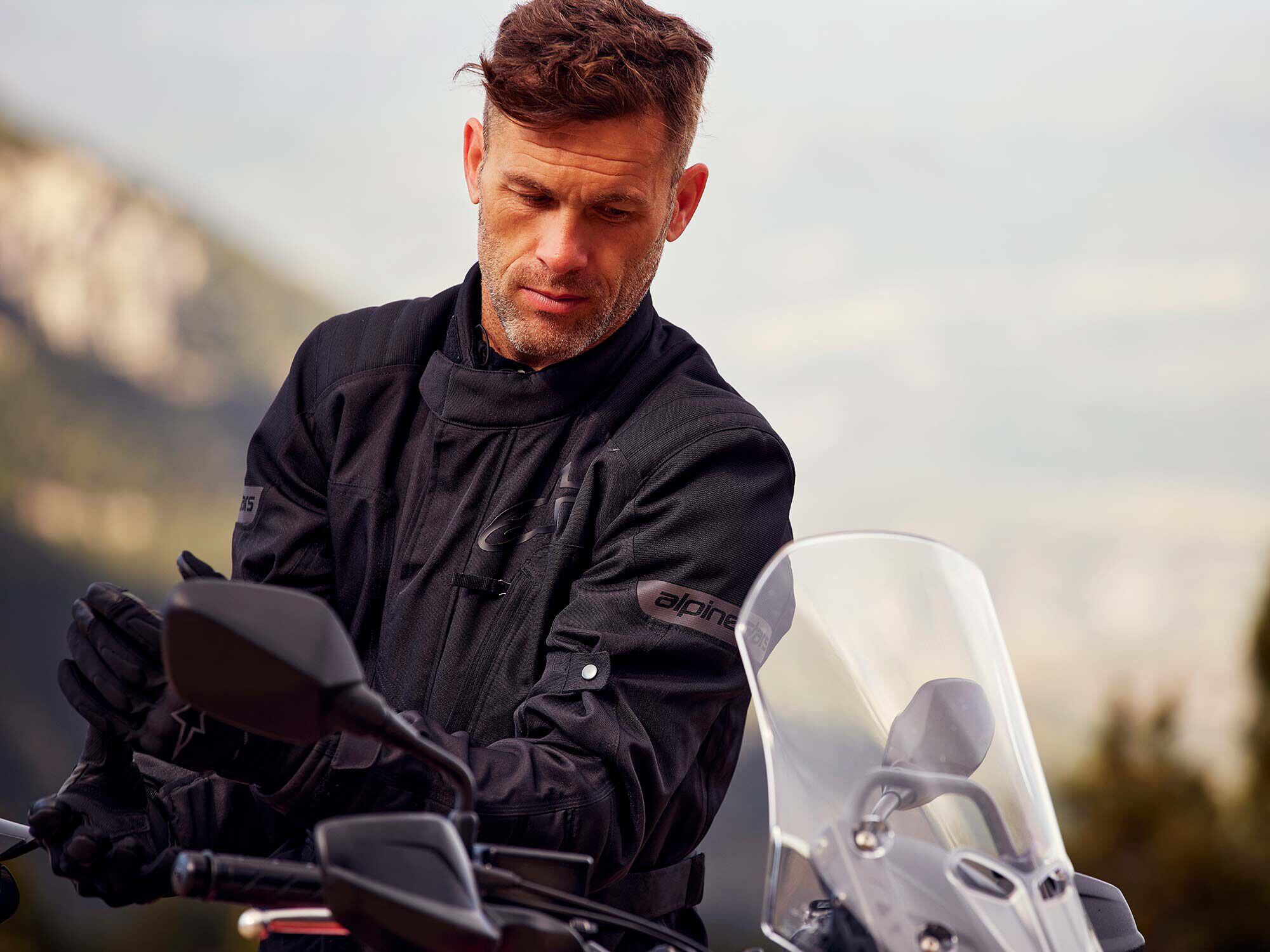
The CB500X’s windscreen has two available height settings—56.9 inches and 55.5 inches—but requires tools to be adjusted. (American Honda/)Fuel Economy and Real-World MPG
Considering that very little if anything has changed with the engine itself, our last recorded average fuel economy on the 2020 model of 54.6 mpg is totally solid, and should work out to around 250 miles of total range.
Ergonomics: Comfort and Utility
More findings from the last test that should carry over to the new model pertain to rider comfort. “When cruising along at speed the windscreen serves its purpose in deflecting the wind, but you best be sure the placement is suitable before your journey because the two-height adjustability does require tools,” wrote the Cycle World test staff. Even still, it is nice to have options, and in this case you have two; the windscreen can be adjusted to 56.9-inch or 55.5-inch heights.
While we had no issue with flat-footing, riders with shorter inseams will be on their toes. Commuting to and from the office or around town is done in comfort; the ergonomics are upright with the tapered handlebar and central peg position. The width of the bar and low-slung weight allow for easy slow-speed maneuvering. Standing up on the pegs for dirt sections is moderately uncomfortable since the bars are just a tad low and back, causing the rider to bend more over the bars than preferred. Then again, the CB500X is more street-oriented than dirt-focused.
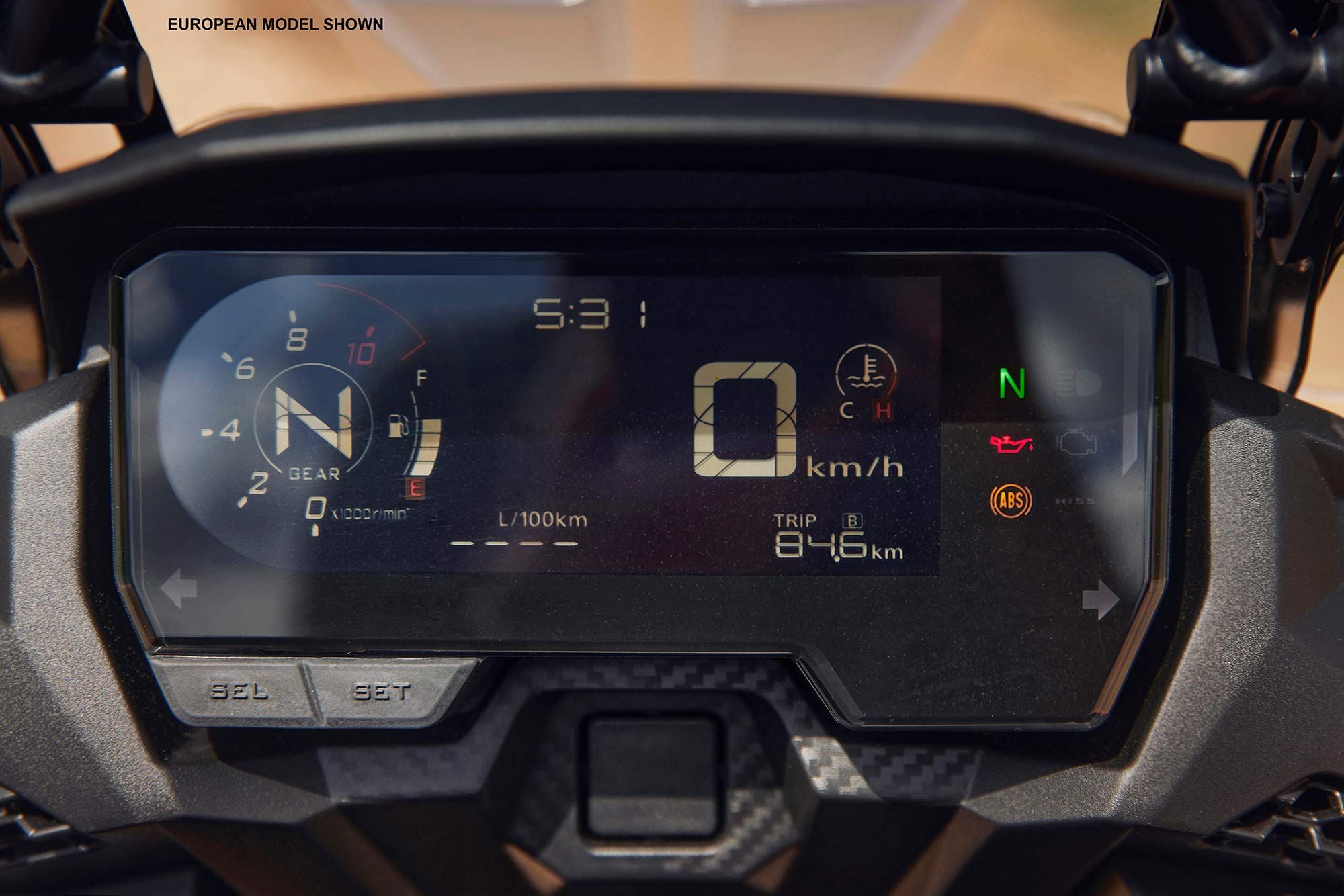
LCD instruments—set in a multi-surfaced and textured surrounding—give the affordable CB500X a premium look and feel. (American Honda/)Electronics
There isn’t a lot of tech wizardry here, but you get standard ABS, LED lighting, and a fully digital instrument cluster featuring a gear position indicator and programmable shift-up light.
Warranty and Maintenance Coverage
A one-year transferable, unlimited-mileage limited warranty is standard, while an optional HondaCare Protection Plan is also available.
Quality
Despite the affordable price, this is still a Honda, and the Japanese company has an amazing reputation for high-quality fit and finish, and takes pride in the durability of its products.
2022 Honda CB500X Claimed Specifications
MSRP: $7,199 Engine: 471cc, DOHC, liquid-cooled parallel twin; 8 valves Bore x Stroke: 67.0 x 66.8mm Transmission/Final Drive: 6-speed/chain Fuel Delivery: PGM-FI w/ 34mm throttle bodies Clutch: Wet, multiple disc; cable operation Engine Management/Ignition: Computer-controlled digital transistorized w/ electronic advance Frame: Diamond-shaped steel-tube mainframe Front Suspension: 41mm Showa SFF-BP USD fork; 5.9 in. travel Rear Suspension: Pro-Link single shock, spring preload adjustable; 5.3 in. travel Front Brake: 2-piston calipers, dual 296mm discs w/ ABS Rear Brake: 1-piston floating caliper, 240mm disc w/ ABS Wheels, Front/Rear: Cast aluminum spoked; 19-in. / 17 in. Tires, Front/Rear: 110/80-19 / 160/60-17 Rake/Trail: 27.5°/4.3 in. Wheelbase: 56.9 in. Ground Clearance: 7.1 in. Seat Height: 32.8 in. Fuel Capacity: 4.7 gal. Wet Weight: 439 lb. Contact: powersports.honda.com -
The 2022 KTM 1290 Super Adventure R has finally made its way stateside, a year after it was made available to the European market. KTM redesigned the Super Adventure with major updates to its engine, chassis, and electronics package.
The KTM 1290 Super Adventure R is powered by a variation of the 1,301cc LC8 75-degree V-twin powerplant, which also powers the ridiculously entertaining 1290 Super Duke R Evo. The engine was updated extensively for the 2022 model year to achieve Euro 5 compliance, which we covered in our first ride review of the new model.
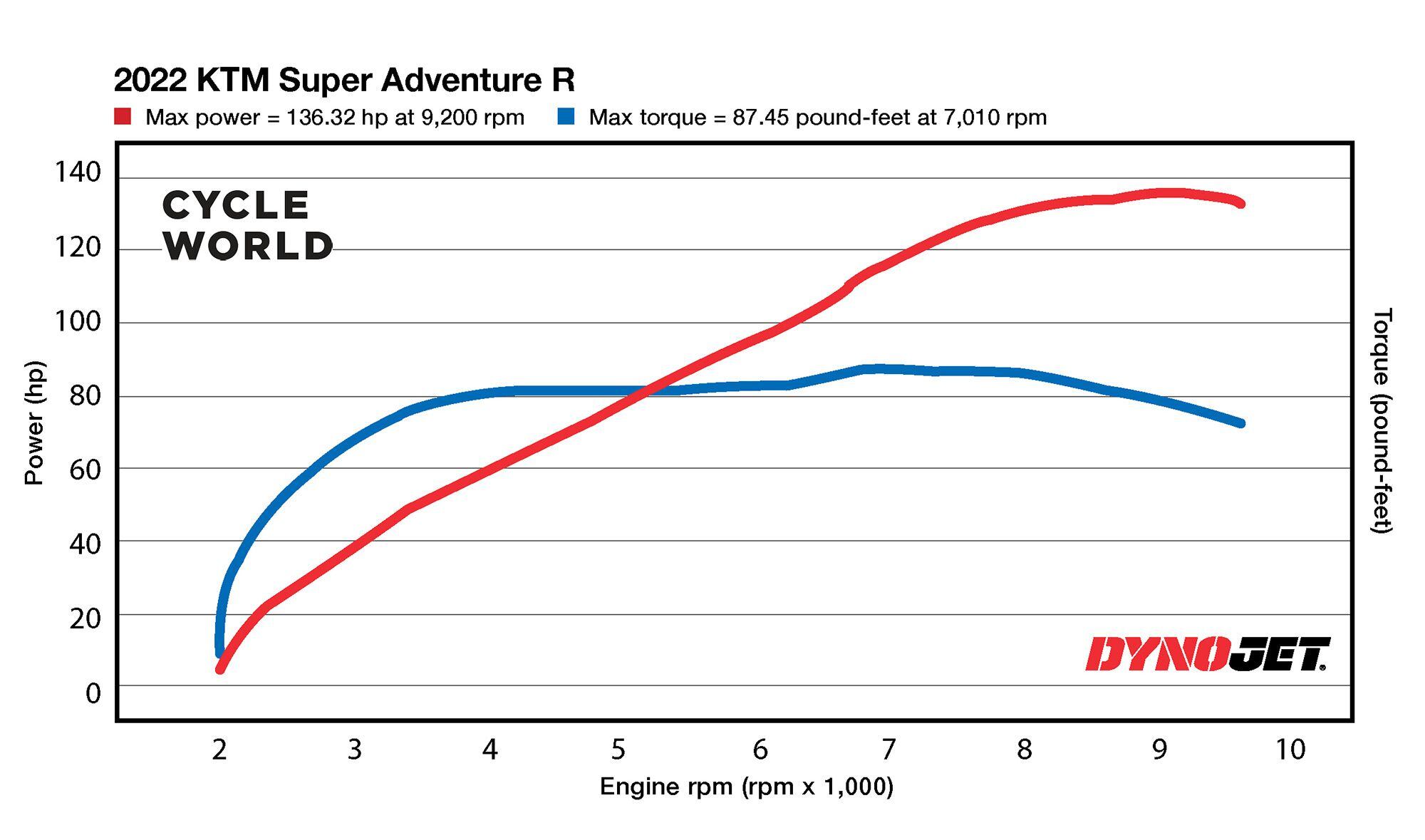
Horsepower and torque figures of the 2022 KTM 1290 Super Adventure R on the <i>Cycle World</i> dyno. (Robert Martin Jr./)As part of the Cycle World testing protocol, we placed the 2022 KTM 1290 Super Adventure R on our in-house Dynojet 250i dynamometer, recording horsepower and torque measurements. The Super Adventure produced a peak 136.32 hp at 9,200 rpm and 87.45 pound-feet torque at 7,010. The immediacy of available torque and tabletop-like curve is remarkable. Over 80 pound-feet of torque is available from the 3,500 rpm mark and only tapers off beyond 9,000 rpm.
-
Several optional add-ons are available, too.
-
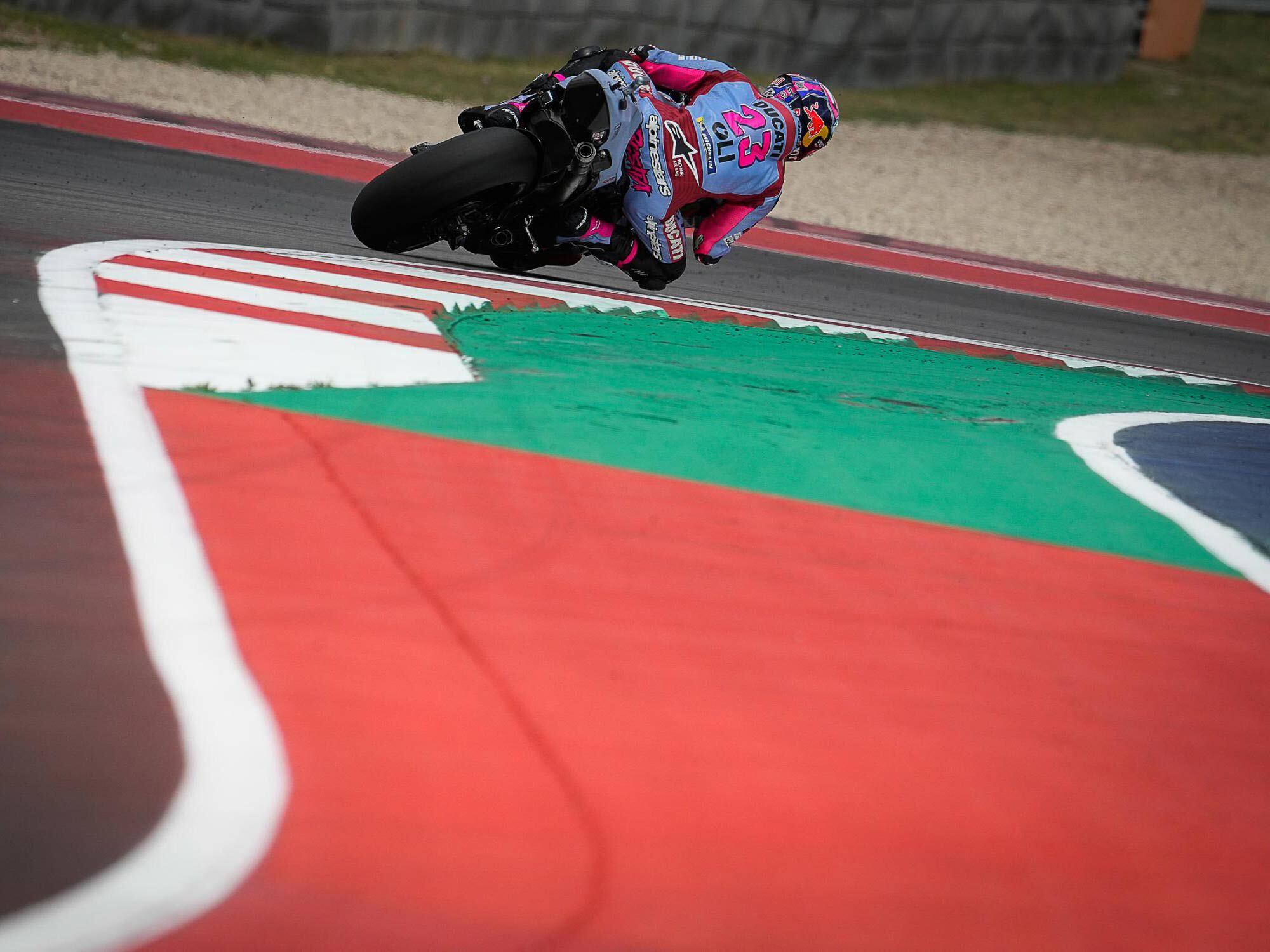
With Marc Márquez still not riding at 100 percent, a COTA victory was up for grabs, and grab it Enea Bastianini did. The Ducati rider qualified in fifth, with the other four bikes in front of him also Ducatis. By the checkered flag, though, things had changed. (MotoGP/)At Circuit of The Americas, qualifying packed the front of the MotoGP grid with Ducatis—first through fifth, Jorge Martín on pole. Was this the pattern we’ve been waiting for? Locked out back in sixth was the current champion, Yamaha’s Fabio Quartararo, down 7 mph in top speed but riding with narrow margins. The two Suzukis of Álex Rins and Joan Mir were next, followed by two of the Hondas so recently hailed as most likely to succeed—returning Marc Márquez and Takaaki Nakagami. In functional nowhereland, 13th and 14th, were the new paragons of apex speed, the Aprilias of Aleix Espargaró and Maverick Viñales.
Márquez is the recognized King of COTA, having won every MotoGP here but one. His stiff, hard-braking and quick-maneuvering Hondas have been the right tool for COTA’s repetitive direction changes—features that have made this the most physically demanding of tracks. Want a workout? Try the bar-bending exercise of manhandling a 400-pound (wet) motorcycle from elbow-down turning in one direction to the other, over and over for 45 minutes, all while holding your line with precision. Remember to breathe.
The track—known for the constant heaving of the clay and variable water table underlying it—had been extensively smoothed this year. Riders reckoned it was much better (and safer) than a year ago, but bumps do remain. To lay persons tooling around the circuit in rental cars it’s perfect. On two wheels, at 200 mph, navigational hazards appear, and riders commit every one to memory. At the first Indianapolis MotoGP, when Casey Stoner stated that the circuit was rough, he was challenged by a Brickyard loyalist: “Where?” He then recited every bump on the racing line, with its effects. Racing in MotoGP is not about gittin’ real friendly with danger—it’s a high-speed intelligence test.
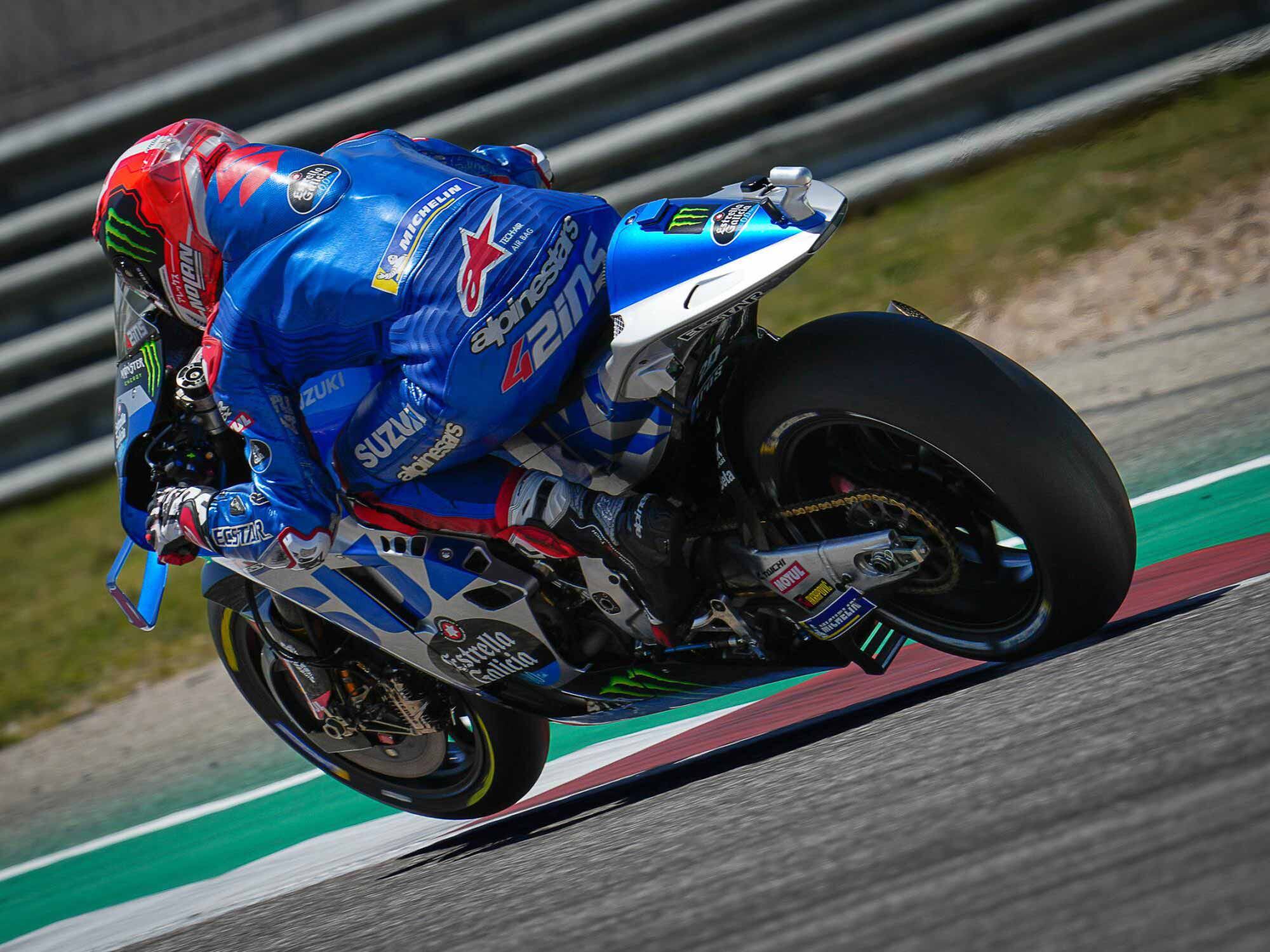
Álex Rins is one of two Suzuki riders to push aside the Ducatis and finish up front. At the end, Rins (second overall) is overtaking Jack Miller only a few laps before the checkers. (MotoGP/)The bikes shot forward at the start, and Jack Miller was first into turn 1 at the top of the hill. Something glitched on Márquez’s Honda: While showing a dash alarm it behaved as if the pit-lane speed limiter was enabled. He poked buttons, was rewarded with workable function, but was now last—just as he had started his last-ever Moto2 race years ago.
Ducati’s phalanx faltered. Rins was past Francesco Bagnaia by lap six, then past Johann Zarco three laps later. Miller continued to lead, looking a likely winner for 16 laps. Márquez, despite his compromised physical condition and recurring vision problems, was moving up, passing other riders wholesale. As he did so, he was noting and evaluating the clash between his own style and the changed nature of the 2022 Honda, and also finding ways to ride the bike better.
He said, “I knew that riding at 100 percent for all the laps would be impossible, but I gave everything and then when five or six laps remained my body said ‘OK, that’s it,’ and I just tried to finish the race.”
Miller was at the same time being challenged by Enea Bastianini (aka “The Beast”). Miller said, “I tried to break away but made a couple of slight mistakes. Enea was back on me and blitzed me down the back straight. I thought ‘All right. Be calm. Sit behind and see what I can do toward the end of the race.’
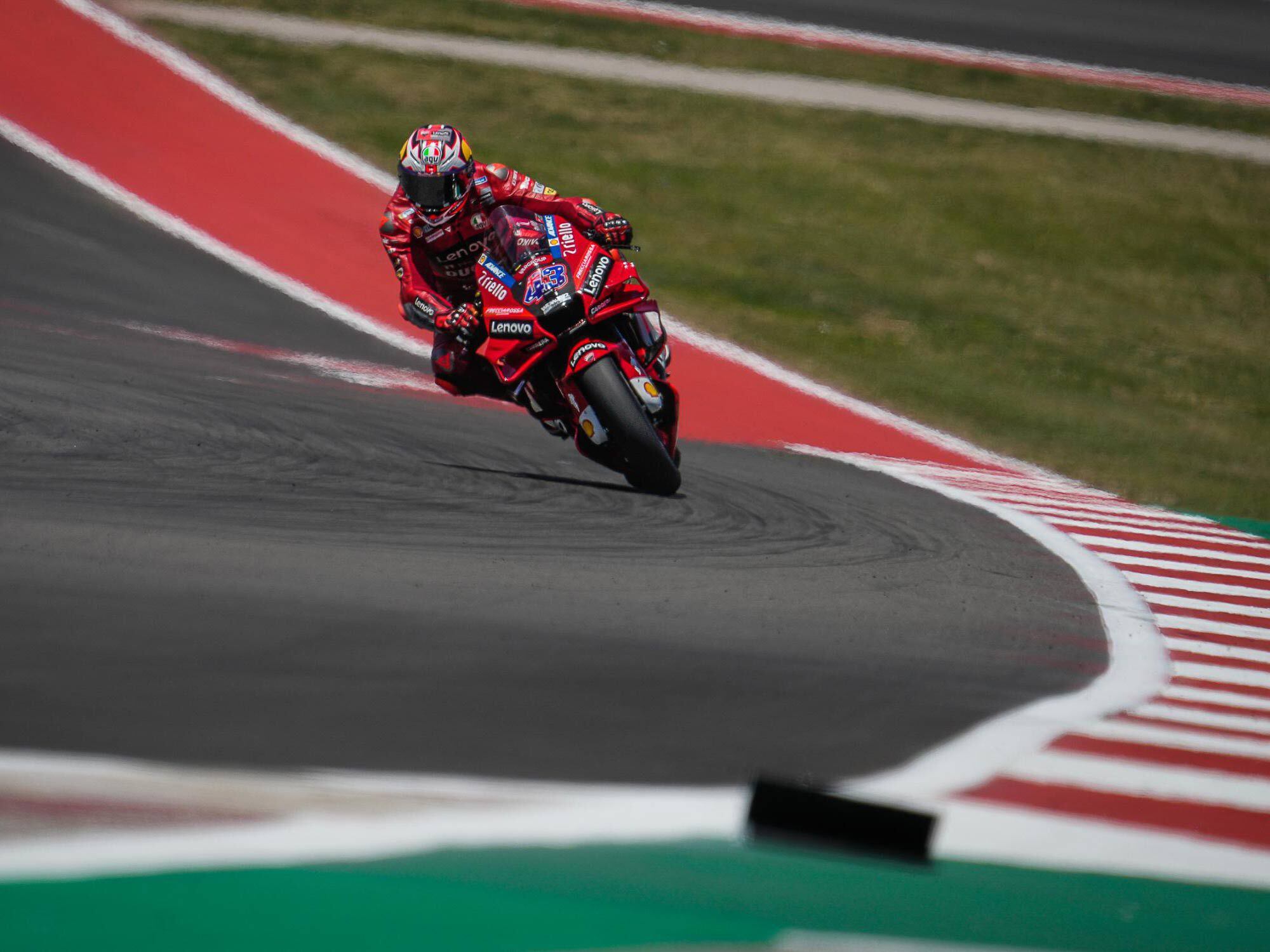
Jack Miller (Ducati) made a good showing at COTA. In the end, diminishing tire grip moved him from second back to third. (MotoGP/)“The next lap we came to turn 11. He went deep and I followed him in and nearly ended up in the car park! Then I heard that Suzuki right next to me.”
Miller was missing apexes. Bastianini had tire left, Jack less so.
“A nice clean battle there, through to the end.”
Miller finished third, with Rins second, just ahead. Suzuki teammate Mir was fourth, another 1.6 seconds back.
Speaking of Bastianini, Miller said, “He’s unreal with the way he puts the throttle down. In some ways he doesn’t ever use the rear of the bike to turn, which is my big problem. I’m always using the rear of the bike to turn.”
More Tire Observations
Every detail of rider style affects tire life! Yet just as beautiful fashion models hate their elbows and feet, Bastianini said, “I’m really fast in entry of the corner, especially when there’s a big braking, but I pay in the middle of the corner because I’m more slow. I have to improve this…”
And the other Ducatis? Bagnaia (fifth) said, “Jack was great because he was fast right from the start with the same specs as me, while I struggled a bit in the early laps.
“I knew the tire consumption was a bit high for us.”
Zarco, who finished ninth? “…I had some difficulties with the rear tire and after that it was impossible to recover.”
Martín, finishing eighth: “A very difficult race. I really gave everything I had but unfortunately it was not enough.”
Rins, too, was at the limit of his tires: “…in the first few laps I was struggling a bit and at risk of losing ground. I had to push the tires more, to brake later, to make good overtakes. When I got into third I had a couple of moments on the front, some mistakes.
“Then, with just two laps to go I felt better and my pace was good. I was able to overtake Jack and get second.”
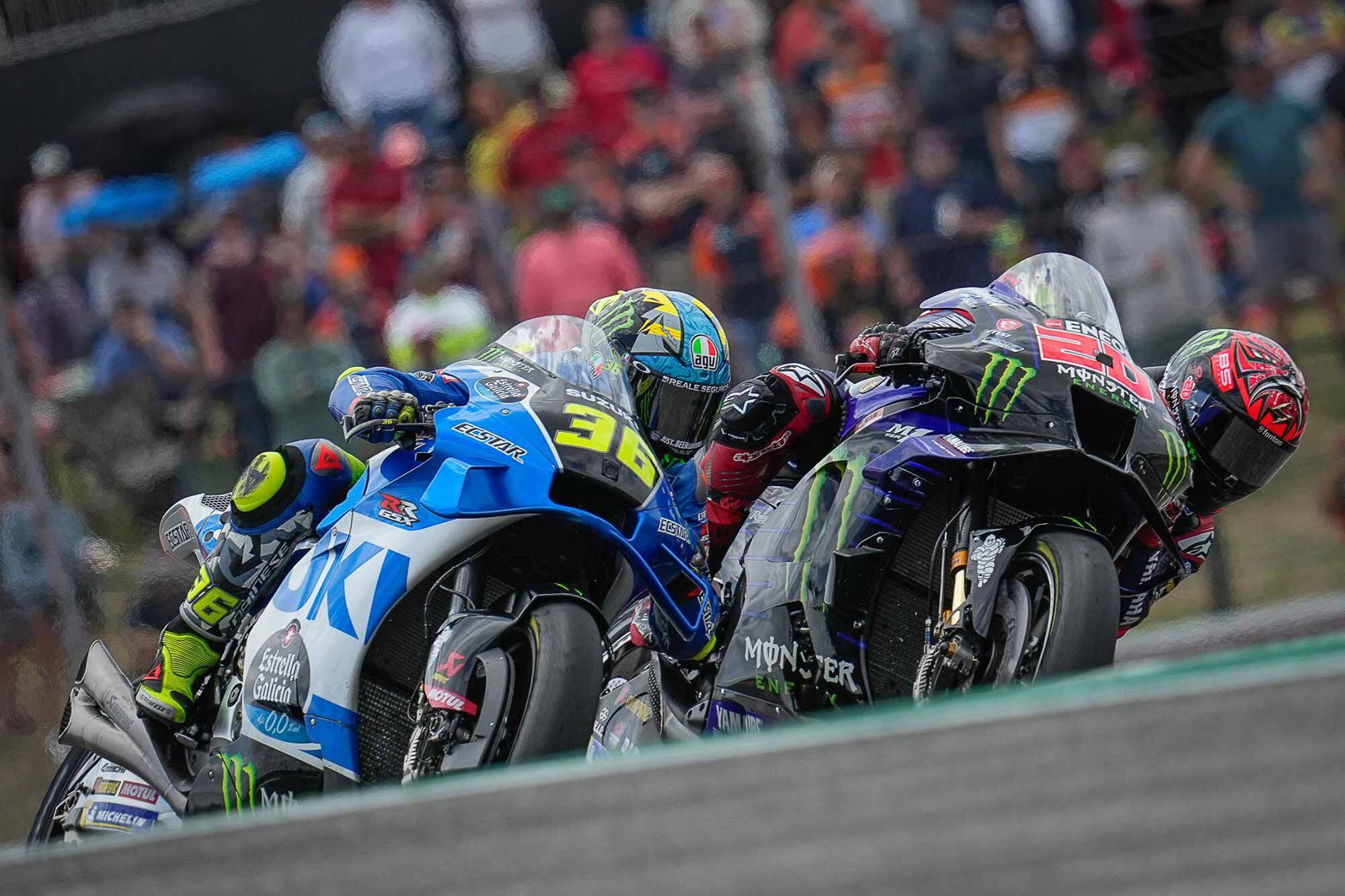
Like his teammate Rins, Joan Mir had his Suzuki dialed in at COTA, finishing fourth. (MotoGP/)Riders often report such instances of settling themselves and smoothing out.
Marc Márquez continued his rush to the front to finish sixth, causing speculation that had his bike functioned normally at the start, he could have won. (Márquez himself said “…25 points were possible today.”)
During practice Márquez had noted that “the front of this bike is one of the weak points for my riding style. It is where I am struggling more.
“…today I had some warnings that I did not understand well.”
The classic Márquez style of the past was to rush up to the corner on the front wheel alone, let the rear swing out to turning position and set it down. Get the turning done quickly, lift, and accelerate. This requires a stiff chassis that responds quickest to command, with either maximum weight on the front or, next best, a tallish center of mass that transfers weight pronto during braking/acceleration.
But last year many riders noted that rear grip was poor during corner entry, and some were trying to improve it by moving weight to the back, preferably to the point of sharing braking with the rear wheel.
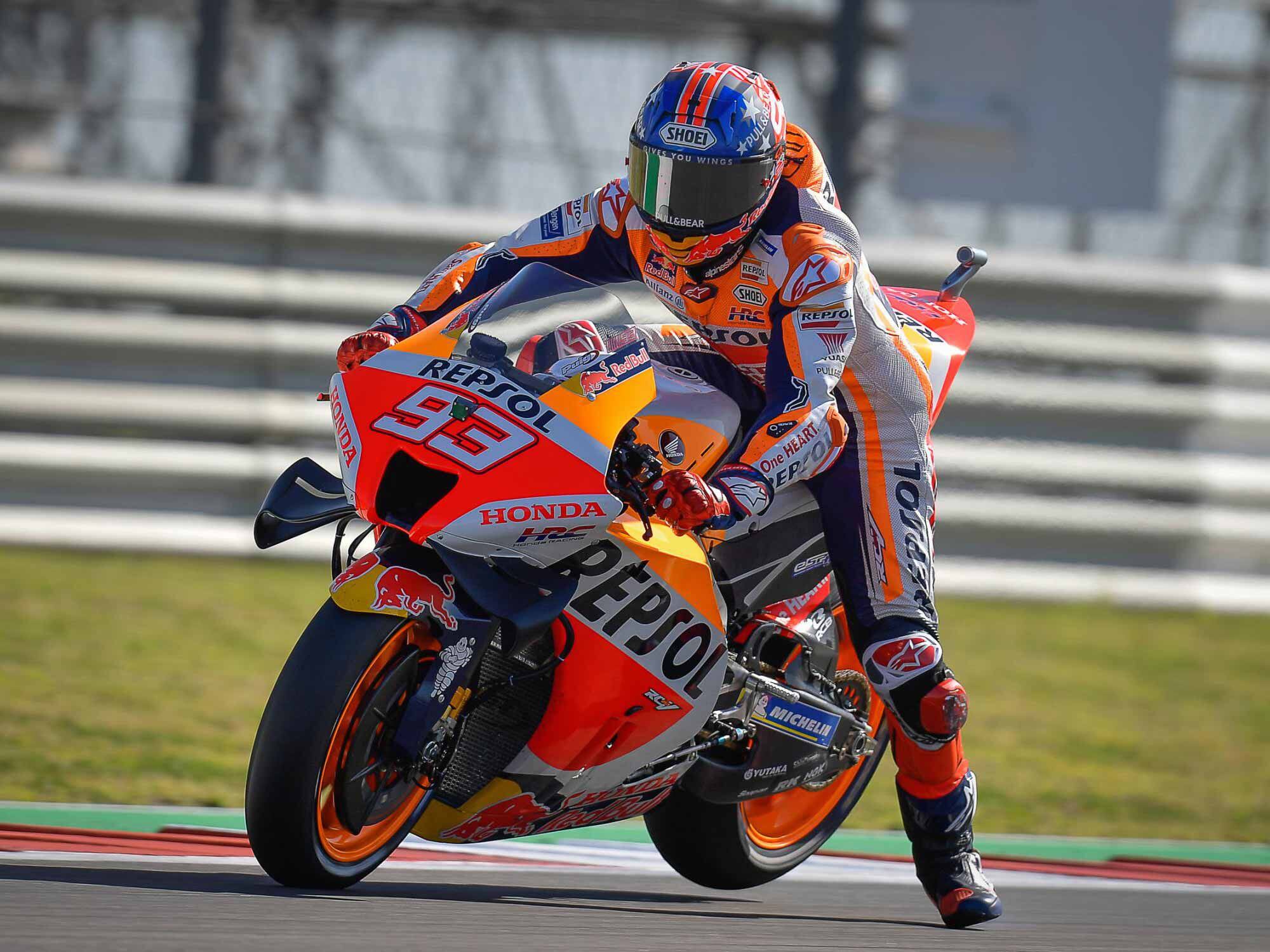
Marc Márquez, the (former) king of COTA, showing his trademark style, getting the bike turned with the rear wheel off the surface. A software glitch at the start moved him back to dead last, but he charged through the field to finish sixth. (MotoGP/)Márquez’s severe braking often required him to use a hard front tire. Others on Honda (Nakagami, Pol Espargaró, Álex Márquez), being less severe, may prefer to distribute their turning over a greater distance, needing more side grip from their tires. One element in building side grip is lateral chassis flexibility. It may be that the 2022 Honda is less stiff up front and carries a bit less weight there—features that to Marc Márquez might 1) reduce the force of initial braking and 2) reduce confidence as the more flexible chassis weaved about during braking.
Rubber’s Glass Transition Temperature
Another point to consider: the nature of tire tread rubber. Every rubber compound has what is called its “glass transition temperature” or glass point—a temperature below which the rubber becomes an unyielding solid. In tires for production vehicles this is academic, as the glass point has to be set low enough to allow safe all-weather operation. But long ago it was discovered that for maximum grip there was a temperature zone not too far above the glass point in which the rubber gave outstanding grip. Above that operating-temperature zone, the rubber becomes softer and more elastic, losing grip.
We know from the history of GP racing that Michelin achieved great things by concentrating very powerful grip in a narrow temperature range. This was made practicable by not making the tires until the last possible moment, so being as sure as possible of what conditions would be Sunday afternoon. Tires were manufactured Saturday night and then driven or flown through the small hours to European circuits.
Bridgestone, being half a world away, faced different conditions. To give its tires any chance of success they had to be given a wider operating-temperature range. When a rule change required tires to be at the circuits earlier, Michelin lost the ability to consider the Friday and Saturday tire experience in deciding what to make for Sunday. Bridgestone’s wider working-temperature range gave them an advantage, leading to the Bridgestone era and the adoption of a “control” or spec-tire rule.
Why Are Qualifying Times so Close?
Today, the high variability we are seeing in rider performance is partly caused by how close everyone’s lap times have become (with as many as 21 riders in the first second after qualifying). That magnifies the effects of small changes, but it may also be that current MotoGP race tires have quite narrow operating temperature ranges. What worked well in warmup for rider A relegates him to 12th at race time. How often have we heard riders say, “All our testing through the free practices went well, but as soon as the race started I had no grip.”
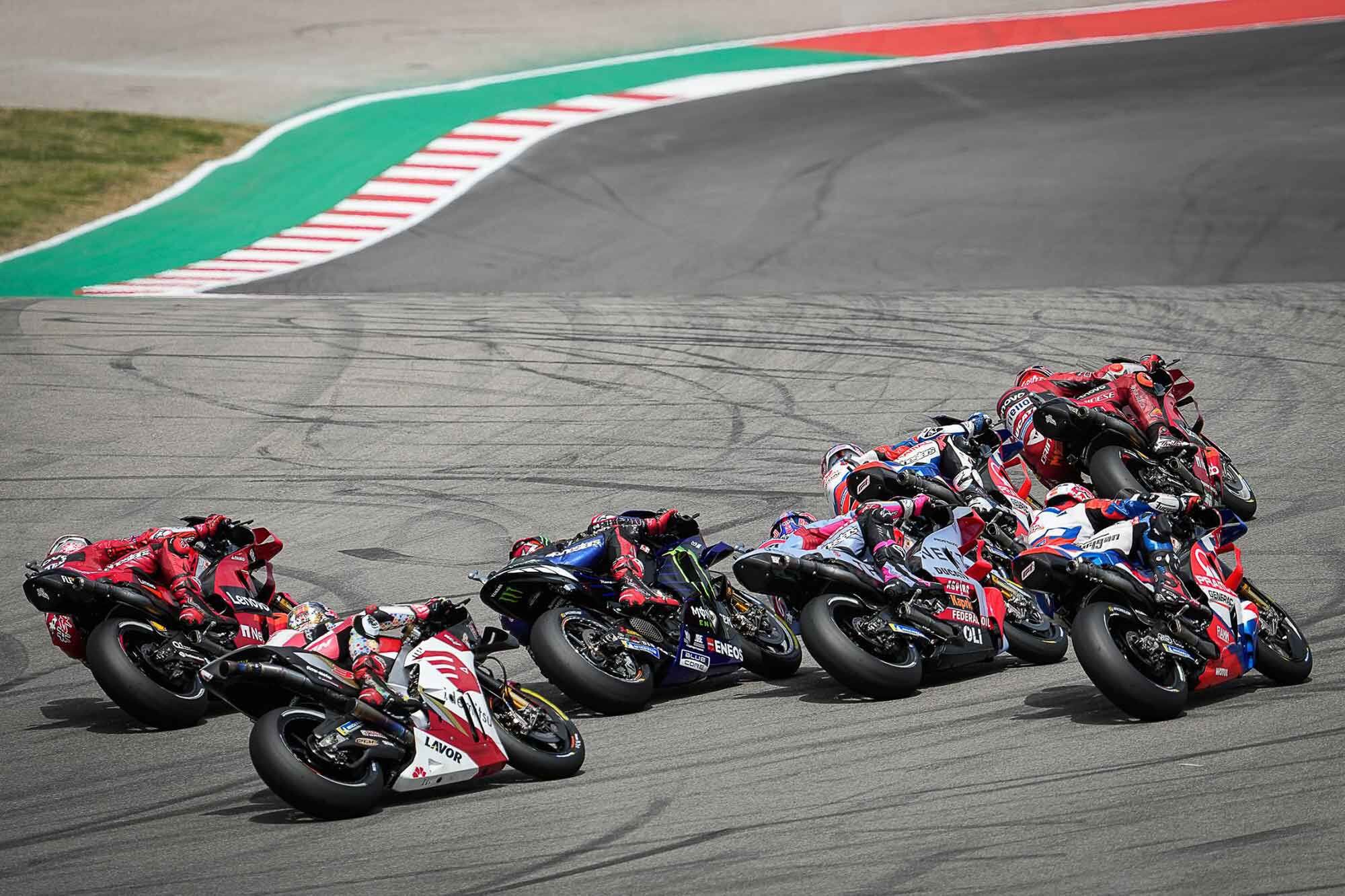
Ducatis dominated the qualifying at COTA, sweeping the top five. In the end, they finished first, third, and fifth, clearly demonstrating that they continue to be a major force at every track. (MotoGP/)Another possibility is that just as grip has increased with tire development (63 degrees of lean angle is pretty impressive) so has suspension load. To keep bikes from bottoming or grounding in turns, their springs must have the necessary stiffness and damping force must keep pace with that. The result is very stiff suspension—so stiff that many riders need help from reduced chassis lateral stiffness. Yet as we see above, point-and-shoot riders thrive on stiffness during braking and turn-in. Also, go too far with relaxing stiffness and you get instability—the weave that riders now call “pumping,” or the “shaking” that Márquez spoke of this weekend. To get one data point, a constructor must design and build a new chassis, test it in house, and then see what its top rider has to say about it. Evidently the way forward is a rocky one, as no one has answers that work consistently.
But wait a minute. At COTA the Suzukis pierced the Wall of Ducatis, and now it looks as though the team has found ways to combine their more powerful 2022 engine with their previous ability to consistently make tires last. That seems really promising.
-
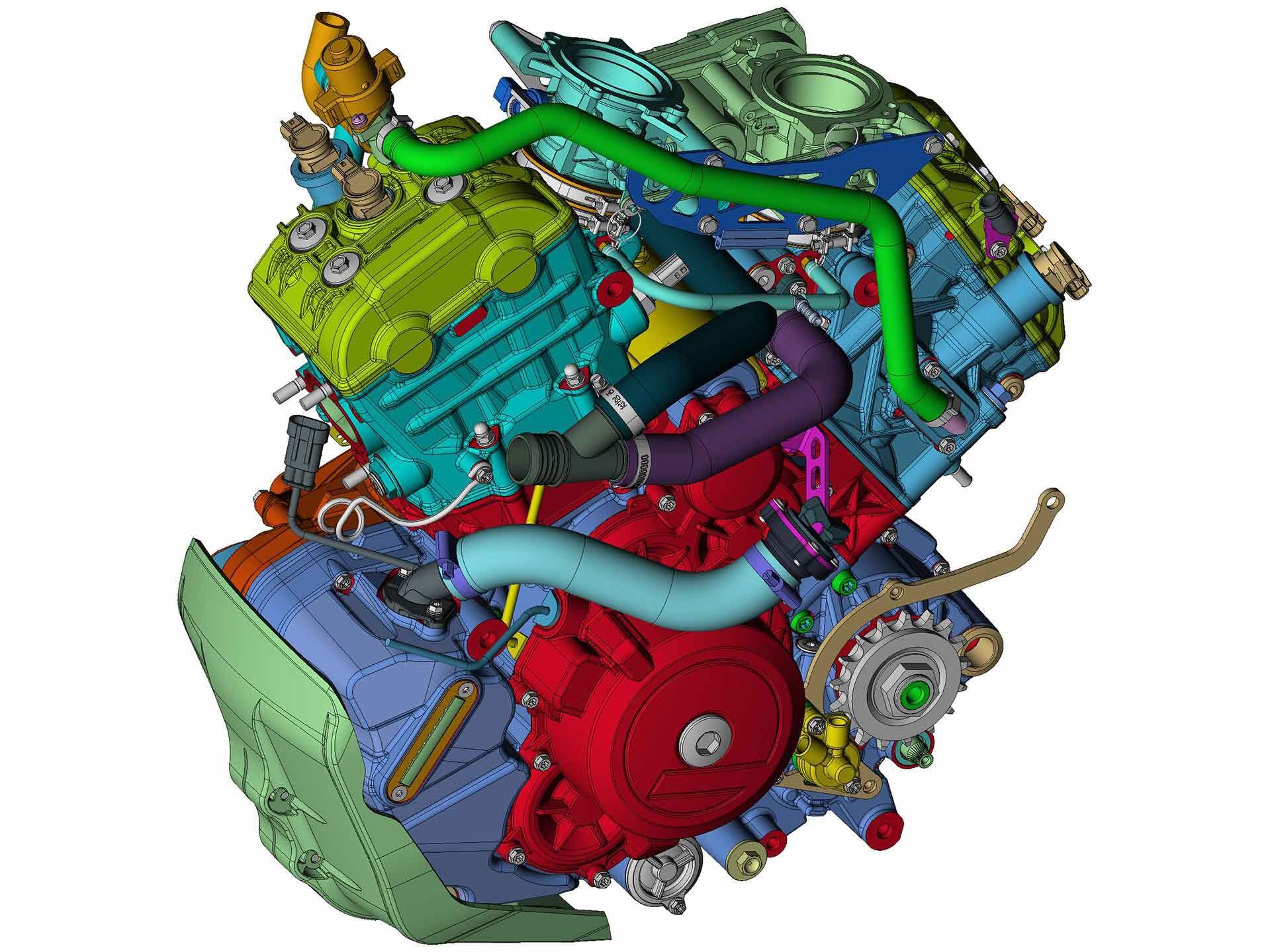
Qianjiang’s new patents show a V-twin motor that nearly mirrors the “1290″ unit seen in KTM’s Super Duke R and Super Adventure R models. (Qianjiang/)Back in January patents emerged for a new 799cc parallel-twin engine that bore the Benelli ‘“TNT” logo on its cylinder head and came from that company’s parent firm, Qianjiang, but otherwise looked nearly identical to KTM’s LC8c design. Now a second KTM look-alike engine has followed the same route, as Qianjiang has put forward designs for a large V-twin just like KTM’s 1,301cc Super Duke R motor. Visually, the design patents—intended to protect the intellectual property of the engine’s external appearance—show barely any differences to the KTM motor, and from the limited information surrounding the design we can tell it’s internally similar as well.
Related: A Future Benelli V-twin on the Way?
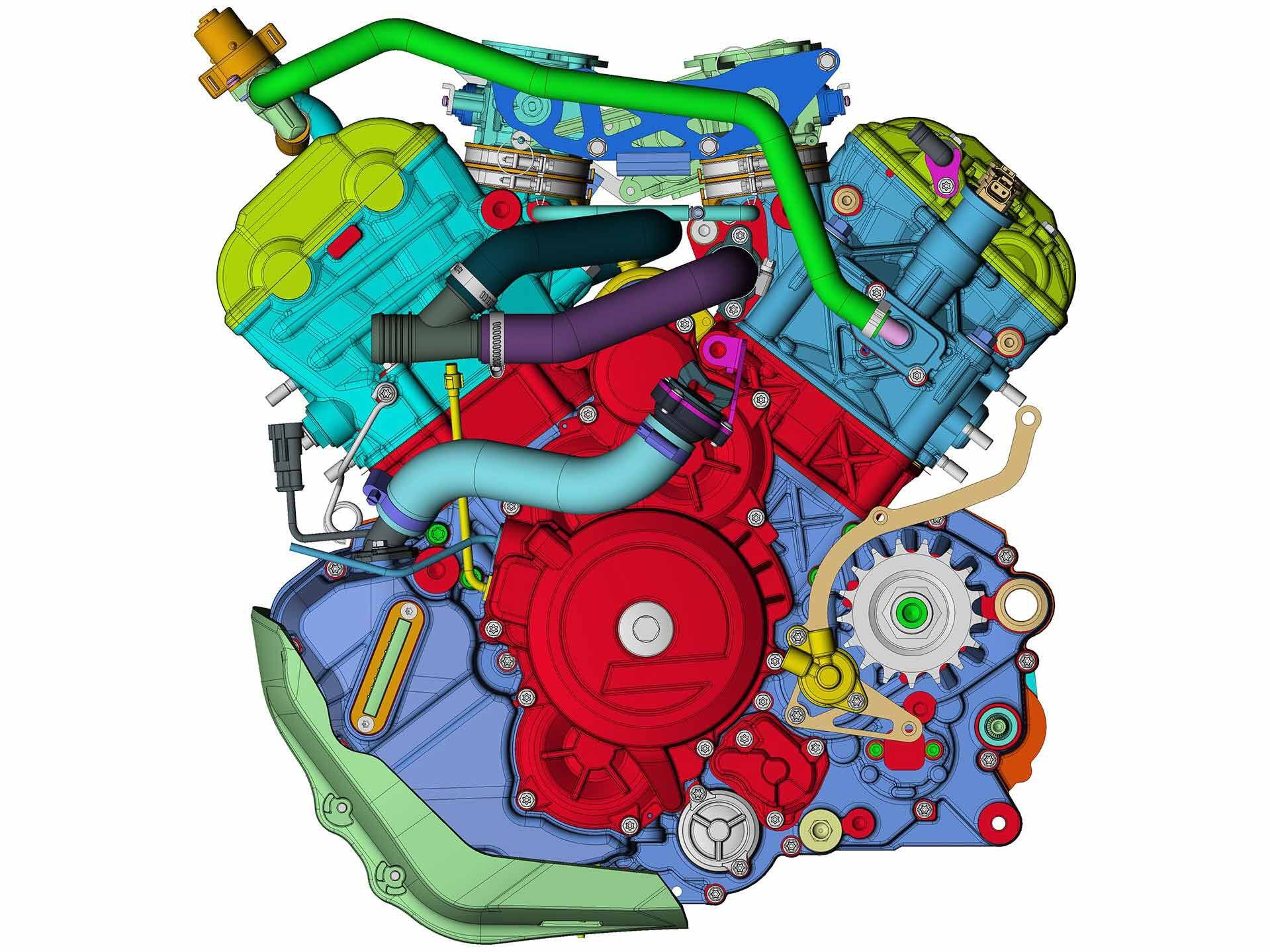
As well as having the same 1,301cc displacement with the same bore, it looks outwardly the same. (Qianjiang/)The patents show the engine goes under the internal code name “QJ2V108MYL.” Catchy, huh? That title follows a convention that applies to all bike engines manufactured in China and can be decoded to offer more information on the design. The first two places represent the engine manufacturer code, in this case “QJ” for Qianjiang. As well as owning Benelli, Qianjiang markets bikes under the QJmotor brand, as well as supplying machines in various territories under the Keeway and KSR Moto brands. Qianjiang itself is majority owned by the Geely Holding Group, better known as parent to marques including Volvo, Polestar, Smart, and Lotus. In other words, these aren’t fly-by-night, bit players in the automotive market.
The next part of the engine’s code, “2V,” is simply a descriptor of its layout. It’s a V-twin. That’s followed by the most significant element of the code, “108,” which relates to the engine’s bore—108mm. Perhaps unsurprisingly, that’s exactly the bore used on KTM’s 1,301cc “1290″ engine, as used in the Super Duke R and Super Adventure R, which is also visually identical to this design. The last three letters, “MYL,” appear to be an internal code, allowing different engines with the same manufacturer, layout, and bore to be differentiated.
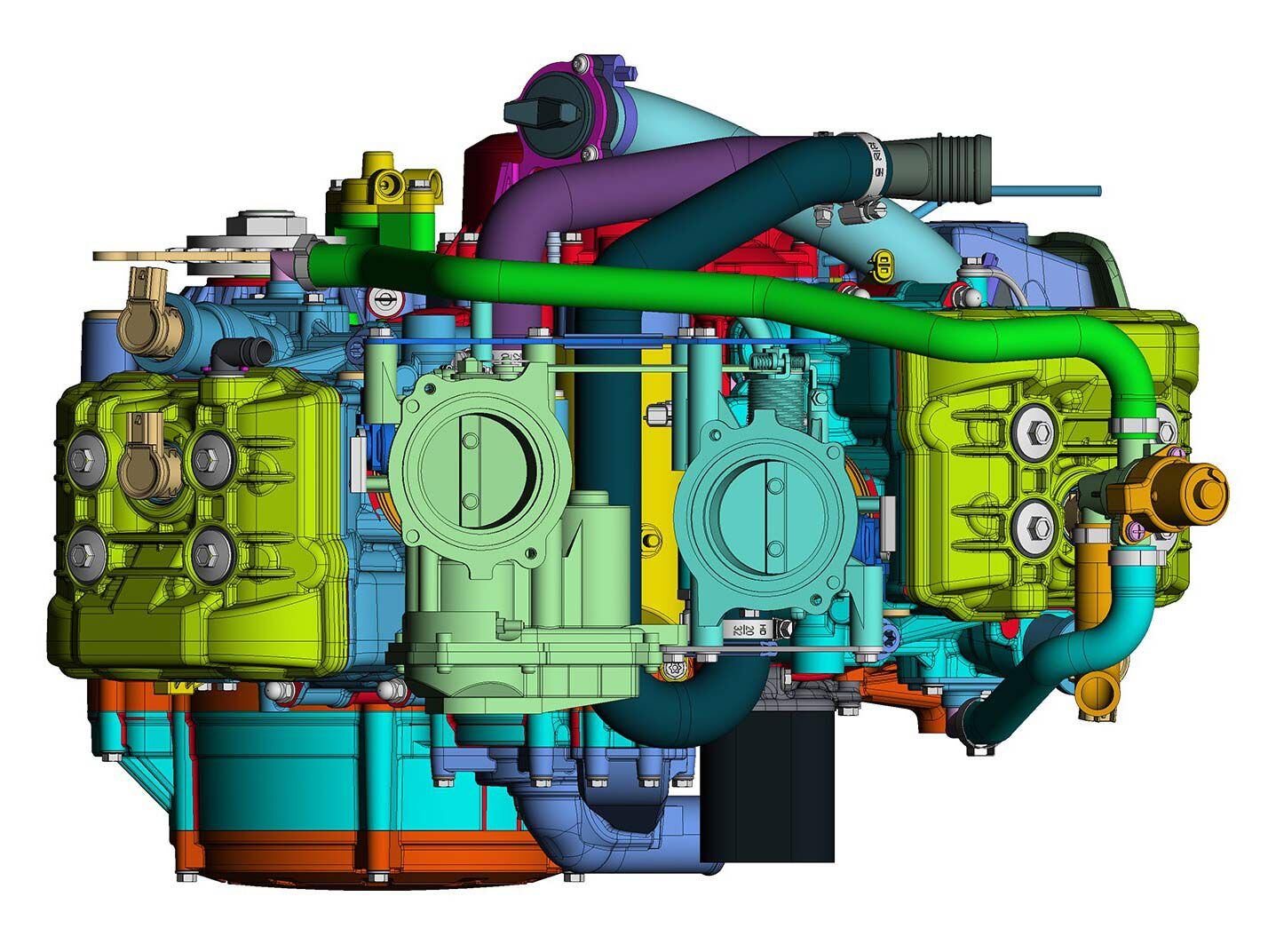
Qianjiang already has several agreements with Western brands, and KTM has also licensed some designs in China. (Qianjiang/)Although there’s a long history of Chinese brands shamelessly copying designs from other manufacturers, that isn’t necessarily happening here. It’s possible, even likely, that Qianjiang has either established or is negotiating a license to manufacture the engine. The company already has several agreements with Western brands, including a deal to develop and manufacture future small-capacity Harley-Davidsons for the Asian market, and an arrangement with MV Agusta to provide small to midsized bikes, starting with the recently revealed Lucky Explorer 5.5. The company also has a KTM connection already since it’s campaigning KTM-made machinery in this year’s Moto3 World Championship under the QJmotor brand with the Avintia team.
Beyond that, KTM already has several of its engines manufactured in China thanks to a deal with CFMoto, which makes the “790″ and “890″ parallel-twin engines for KTM as well as building entire bikes including Chinese-market versions of the 790 Duke. It also makes its own versions of the KTM 790 engine for the newly launched CFMoto 800MT adventure bike and has developed a 1,279cc version of KTM’s older LC8 V-twin to use in the biggest CFMoto model of all, the 1250TR-G tourer, which is already sold in China and widely tipped to be getting a global launch later this year.
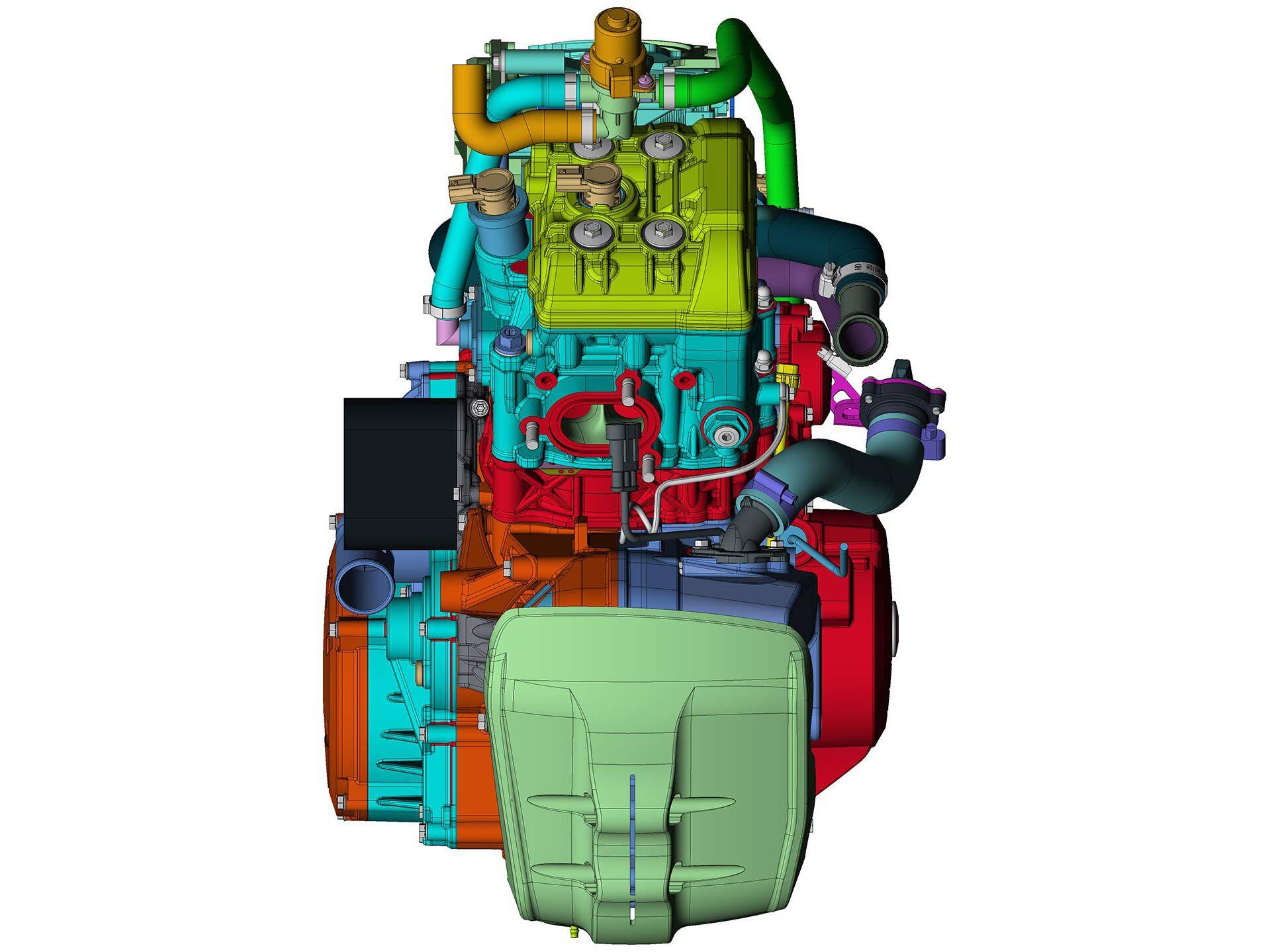
If this V-twin is ever produced, it’s very likely to find a home in a Benelli model. (Qianjiang/)If Qianjiang is to manufacture a version of the KTM V-twin, as this patent suggests, it’s likely to be destined for a Benelli-branded model. At the moment, the biggest Benelli is the 1200GT, a Chinese-market tourer rivaling the CFMoto 1250TR-G and using an upsized version of the old Tornado 1130 triple. The company also reintroduced the Benelli TNT 899 recently, again using the old Benelli triple. In late 2020, Benelli promised a future range that would include 250cc, 380cc, and 530cc singles; 400cc, 700cc, and 900cc parallel twins; 900cc and 1,200cc triples; and 650cc and 1,000cc four-cylinder bikes. The last of those is due to use MV Agusta’s four-cylinder engine. How the 799cc and 1,301cc KTM-based twins will fit into that plan remains to be seen.
-

I first met James Dye, the owner and founder of Lid Lamps, at the Excel bike show in February and was really taken with his helmet lamps and company so I arranged a time to have a chat and find out more about James and his company.
James started riding bikes at the young age of just two years old – he had a peewee 50 with stabilisers which came off by the time he was four years old. Nobody else in his family was into bikes but they had a field next to his house and he and his sister, who also had a peewee bike, used to ride around the field on their bikes.
At the age of 12 years, James got himself a secondhand motocross bike and started motocrossing and competing in events, and successfully too.

James switched to road racing and joined Aprilia superteens which was run by the British Motorcycle Racing Club (BEMSEE). Having come third in the championship he then went on to compete in the Triumph Triple Challenge in 2007. His first time competing on a 600cc bike and James won the championship that year.
At the age of 19 years, in 2008 James entered the British Supersport championship on a Team Buff Triumph 675cc bike. On the first lap of the race at Cadwell Park circuit, James fell from his bike and was struck on the head by a following bike, sustaining a serious head injury. James was placed into an induced coma for two weeks and it was a further eight months before he was cleared to race again.
The following season, James got a ride with Kawasaki but, following his accident James suffered severe memory loss, and he couldn’t remember which corners were coming up on the circuit and sadly had to retire from the rest of that season.
In 2010 James came back fighting fit and entered, and incredibly, won the Triumph Triple Championship.

2011 saw James switch to the Superstock 600 series and whilst competing in the 2012 season on a Haribo Starmix Triumph, James highsided at Snetterton and sustained a broken back and shoulder. James’ motorcycle racing career came to an early end.
Motorbike racing has been a huge part of James’ life, he’s always been into bikes and obviously motorcycle helmets.
James was looking for a motorcycle helmet lamp for his home and couldn’t see what he looking for so he decided to make one himself!
Originally James was looking to make a ceiling light lamp shade but after several designs and much contemplation, table lamps were decided upon to start with. He found a company in London who did 3D printing and after several styles, designs and ideas were printed, the finished product was born.

The lamp itself is in the shape of a helmet and sits on a small stand which is on a carbon fibre plinth. There is a touch on/off switch which is also a dimmer switch so you can adjust the brightness of the light.
The visor on the front of the helmet opens up and you can see the light going down the length of the helmet. Various types of lights were experimented with but the light they have gone with doesn’t dazzle you when the visor is open. The idea with the visor opening is that you have the option of more or less light as you wish.
I really love the styling of this helmet and the light it emits, it’s different, it feels nice and I think it looks cool sitting on the side.
There are plans in the pipeline for different designs, styles, colours and functions etc. and I look forward to seeing what comes out next.

You can find James and Lid Lamps at the following events this year:
BSB at Silverstone 15/17 April
BSB at Brands Hatch 22/24 July
BSB at Thruxton 12/14 August
BSB Snetterton 9/11 September
Cop Dock Suffolk Bike Show 4 September
NEC Bike Show 19/27 November
Thank you to James for your time, it was great chatting to you and learning about your great company.
BK
-
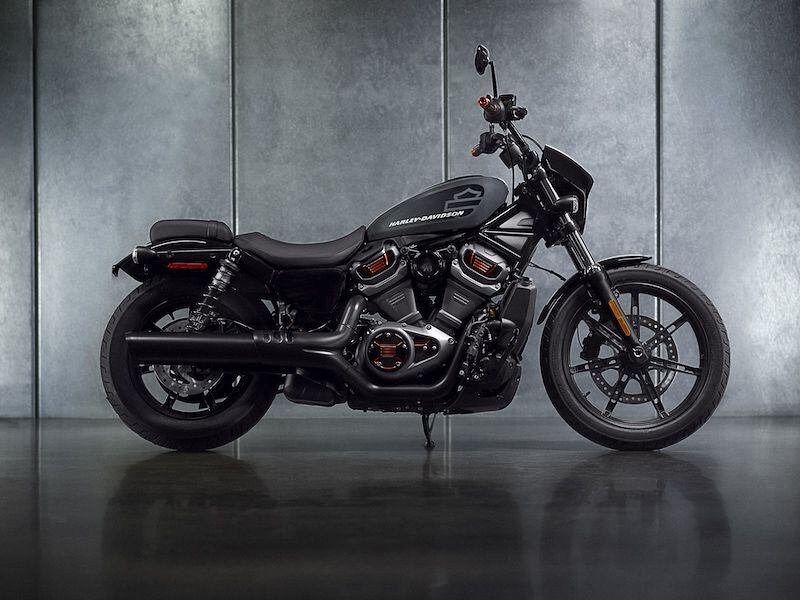
Harley-Davidson’s 2022 Nightster brings a more familiar shape and style to the new-generation Sportster product line. (Harley-Davidson/)The recent debut of Harley-Davidson’s Sportster S was a shock. The liquid-cooled, trellis-framed S is a major departure from everything that previously meant Sportster. Now, with Harley’s unveiling of the 2022 Nightster, H-D is both demonstrating the versatility of the new platform and returning to a more familiar silhouette.
The Nightster’s peanut tank seems vaguely familiar in front of its solo seat and twin rear shocks. It turns out the new cruiser chassis for the Revolution Max can properly carry the flag for the Sportster name after all. After breaking the internet for a few moments with the Sportster S announcement, the MoCo is giving us almost exactly what we wanted to see here: more traditional wheel sizing and a form that better represents the history of the Sportster model.
The original Nightster was introduced in 2007 as a blacked-out bobber-style model on the Sportster platform. It ran until 2012, when it was cut from the line. The similarly styled Forty-Eight still exists now in 2022, though the Sportster name has been removed from its page on the Harley-Davidson website. Many of those original styling cues carry over to the new Nightster.

H-D Vice President of Design Brad Richards said making the Nightster look correct with classic Sportster styling was a challenge. (Harley-Davidson/)Powering the Nightster is the new Revolution Max 975T, which H-D says is tuned for “muscular torque.” Like the 1250T in the Sportster S, the 975T is a liquid-cooled 60-degree V-twin. The Nightster’s engine will also feature variable valve timing, hydraulic valve lash adjustment, and internal balancers tuned “to retain just enough vibration to make the motorcycle feel alive.”
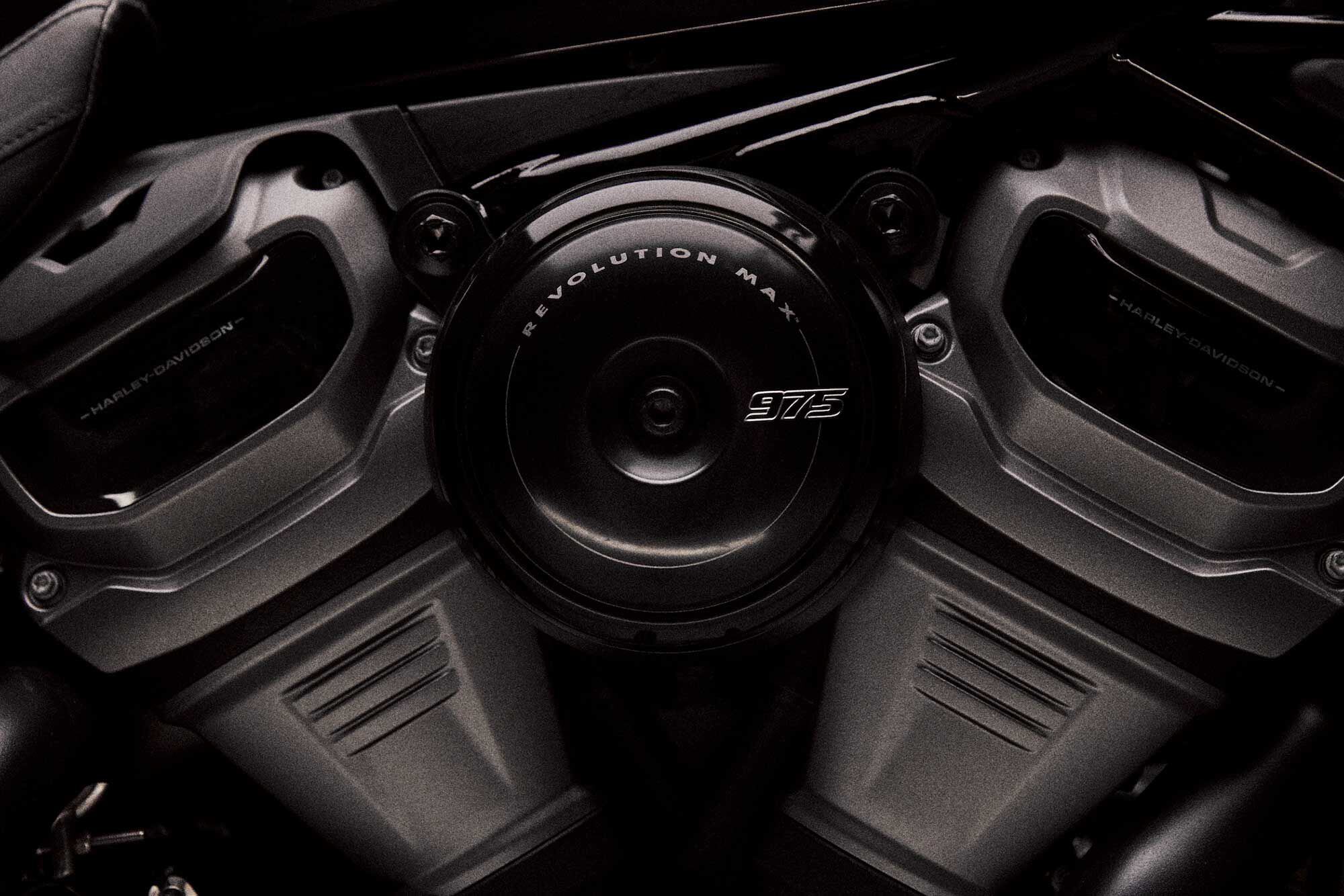
The Nightster is powered by the new Revolution Max 975T DOHC liquid-cooled V-twin. (Harley-Davidson/)“We do want to retain some of the feel that’s so much of what Harley is about, yet we want to balance that with a comfortable ride,” said Kyle Wick, chief engineer on the Nightster project. “With an engine like this, where you go much higher into the rev range, it’s got a different characteristic. If you don’t balance this well, you can create a very poor experience. We want people to know they’re on a bike, that they’re on a Harley-Davidson.”
As we will see on any Sportster moving forward, the Revolution Max engine is a structural part of the Nightster’s chassis. Its aluminum tailsection and welded rectangular steel swingarm are new compared to the S model, accommodating twin emulsion shocks that increase suspension travel, again comparatively. The fork is a 41mm Showa unit with Dual Bending Valve internals.
The Nightster will come with selectable ride modes, each providing a different combination of power delivery, engine-braking, antilock braking, and traction control. Available ride modes include Rain, Road, and Sport, each increasing in performance and response.
A 3.1-gallon fuel cell is located beneath the Nightster’s seat, with a metal shroud shaped like a traditional gas tank covering the airbox. Riders looking to fill that fuel cell will have to lift the Nightster’s hinged seat to do so, an interesting design choice for an H-D.
“We had to make a step change in the performance of Sportster,” said Brad Richards, Harley-Davidson’s vice president of design. “We knew we wanted to do that, and in order to do that there were certain airbox requirements in terms of volume, and of course we have range expectations as well for the product. When we combined fuel size and airbox size, there was no option for a smaller-proportioned, classic-looking Sportster tank. So we were really struggling with how to do this. We also wanted outboard dual shocks ‘cause that was part of the Sportster thing as well. We quickly realized that because of these two things, maybe fuel under the seat would be a good play for us. As soon as we did that it enabled the proportion that we needed with the fuel tank so we got the classic Sportster silhouette.”
Unlike the Sportster S with its LCD gauge system, the Nightster will come with a 4-inch analog gauge with a multifunction LCD display on the handlebar riser, likely similar to that seen on other H-D models like the Street Bob.
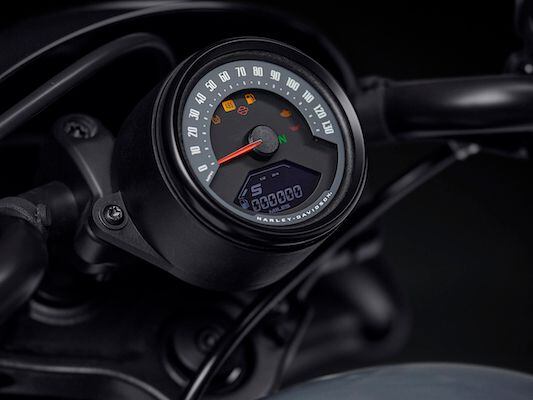
H-D’s Nightster gets an analog speedo featuring a multifunction LCD display mounted on the handlebar riser. (Harley-Davidson/)When asked about hiding new technology in a more traditional form, Richards said, “We knew with the Rev Max architecture that we wanted tremendous breadth in terms of modularity. We knew with Adventure Touring bikes and something like Sportster S we could get away with it, because those bikes didn’t have previous forms that we had to embody. But Nightster had to look like a Sportster. As soon as you take away the loop frame that becomes a real challenge. We did a lot of proportional foam mock-ups, we made a lot of models of this bike. The first ones, I’ll admit, weren’t very successful and we had to do some serious soul searching, and that’s when we got the fuel under the seat and we finally figured out how to put it all together and it was a serious challenge.”
Nightster models are expected in US dealerships April of 2022, so almost immediately. MSRP for the 2022 Nightster in Vivid Black is $13,499, with Gunship Gray or Redline Red coming in at $13,999.
The Nighstster promises to weigh less and produce more power than an old air-cooled Sportster 883, but it seems the 975T is playing a similar role as it pertains to the 1250T. Thanks to its low center of gravity, approachable engine with ride modes, and low seat height, the Nightster seems to be the new entry-level Harley-Davidson.
“This is a narrow bike and a low seat height and a low CG,” Wick said. “This bike is more approachable than arguably any bike in our lineup, and arguably any bike in this space.”
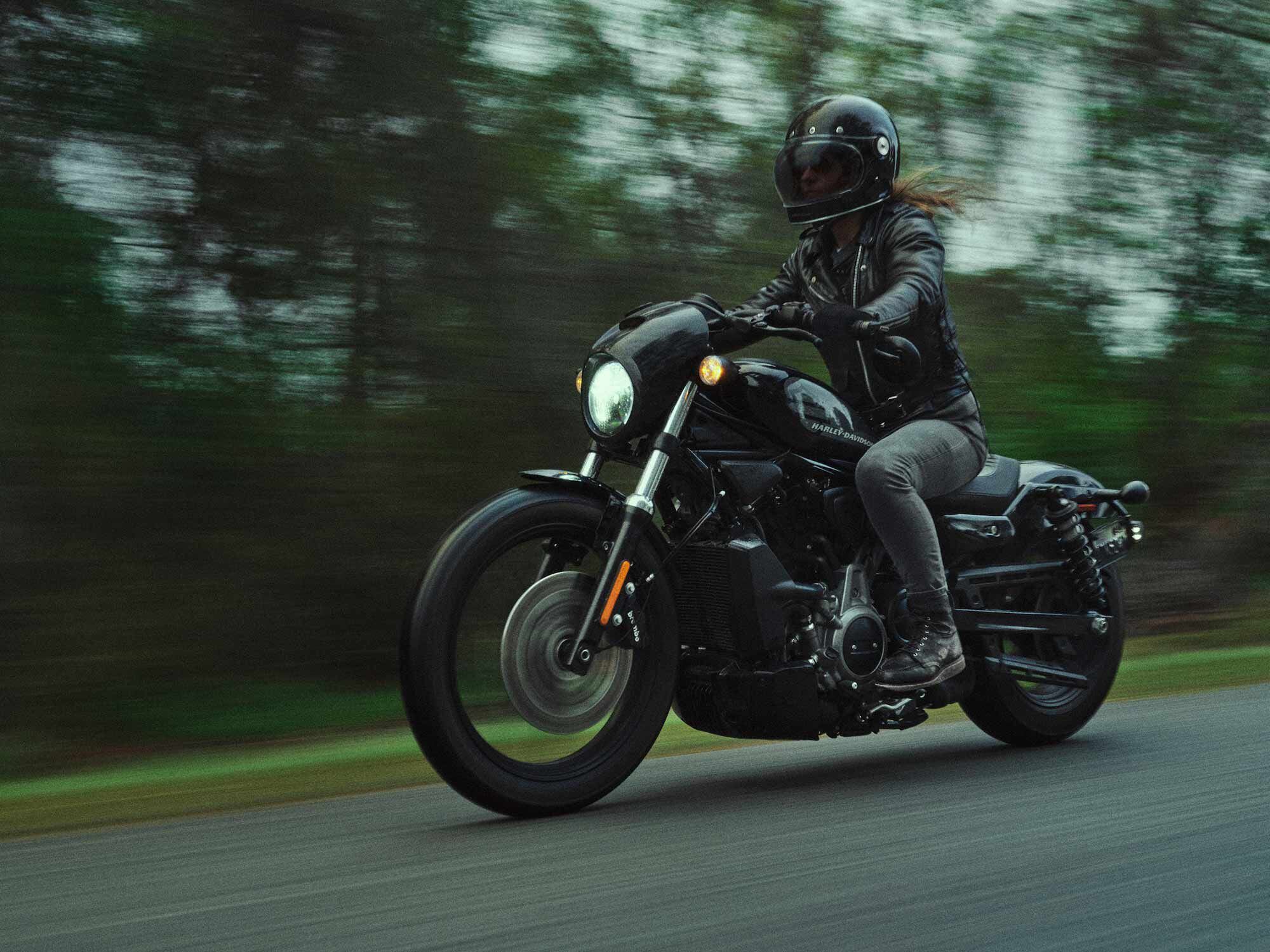
With less weight and more power than the air-cooled Sportster 883, the Nightster looks to provide more performance while still remaining approachable. (Harley-Davidson/)2022 Harley-Davidson Nightster Specifications
MSRP: $13,499 (Vivid Black)/$13,999 (Gunship Gray, Redline Red) Engine: Revolution Max 975T 60-degree DOHC V-twin; variable intake valve timing; 4 valves/cyl. Displacement: 975cc Bore x Stroke: 97.0 x 66.0mm Compression Ratio: 12.0:1 Transmission/Final Drive: 6-speed/belt Claimed Horsepower: 90 hp @ 7,500 rpm Claimed Torque: 70 lb.-ft. @ 5,000 rpm Fuel System: Electronic Sequential Port Fuel Injection (ESPFI) w/ 50mm throttle bodies Clutch: Wet, 8-plate, slipper/assist; mechanical Frame: Steel trellis frame; aluminum forged mid-structure Front Suspension: 41mm Showa Dual Bending Valve Rear Suspension: Emulsion shocks, preload adjustable Front Brake: Axially mounted 4-piston caliper, 320mm disc Rear Brake: Floating single-piston caliper, 260mm disc Wheels, Front/Rear: Cast aluminum; 19 in./16 in. Tires, Front/Rear: Dunlop Harley-Davidson Series Bias Blackwall; 100/90-19 57H / 150/80B-16 77H Rake/Trail: 30.0°/5.4 in. Wheelbase: 61.3 in. Ground Clearance: 4.5 in. Seat Height: 27.8 in. Fuel Capacity: 3.1 gal. Claimed Average MPG: 52.4 mpg Claimed Wet Weight: 481 lb Contact: harley-davidson.com -
Hello Connor150,
Welcome to The Motorbike Forum. Please feel free to browse around and get to know the others. If you have any questions please don't hesitate to ask.
Why not tell us a bit about yourself too.
-
Ride-by-wire, riding modes, and a punchier engine? Count me in!
-
Big adventures come in small packages.

Welcome mutley
in Newbies
Posted
Hello mutley,
Welcome to The Motorbike Forum. Please feel free to browse around and get to know the others. If you have any questions please don't hesitate to ask.
Why not tell us a bit about yourself too.